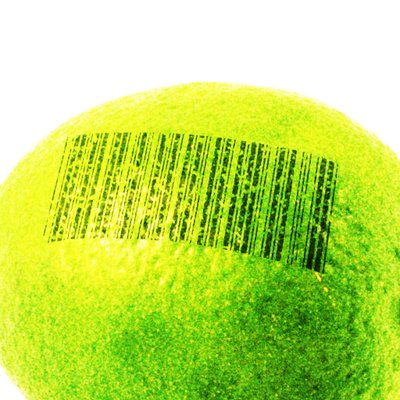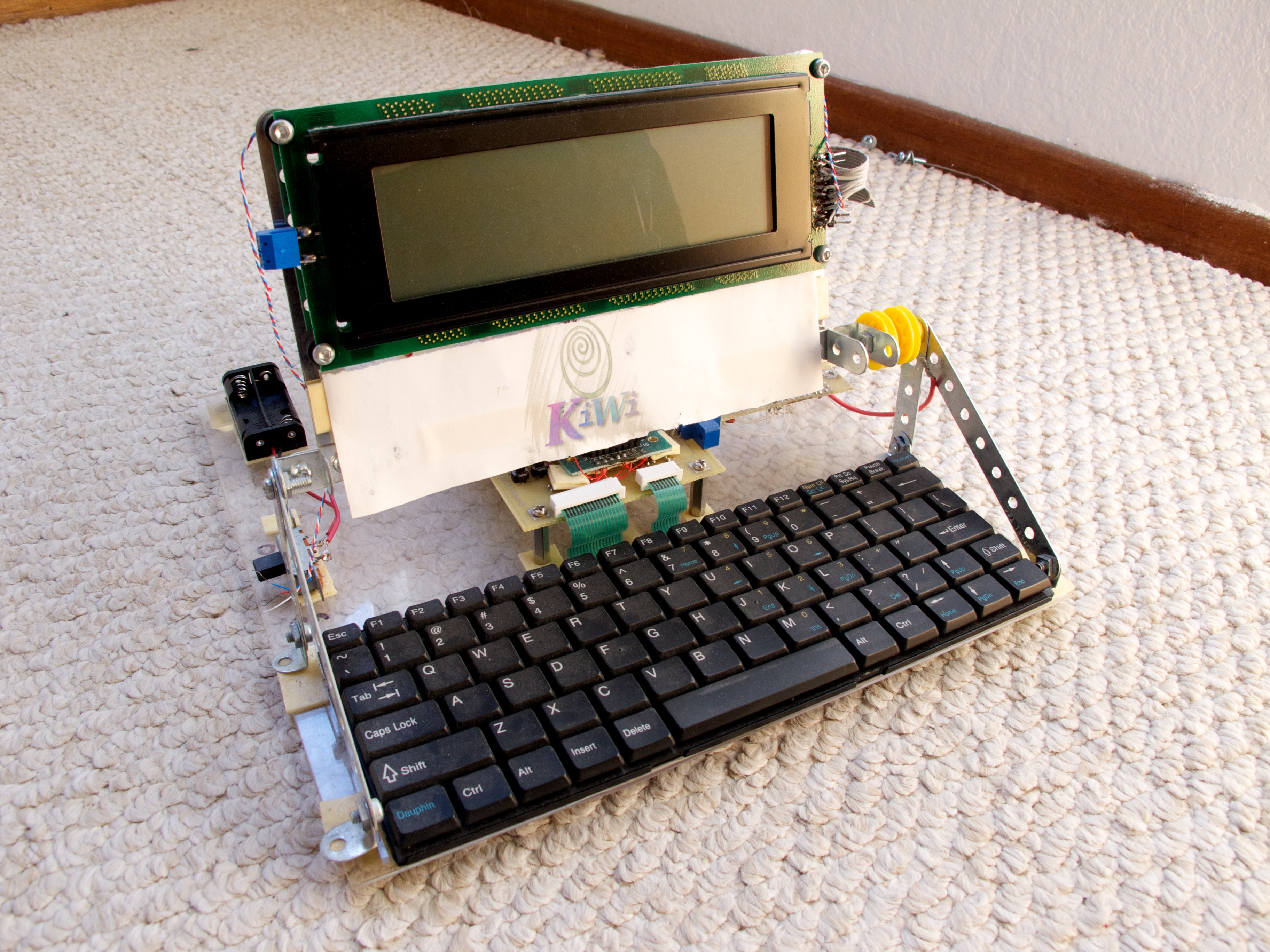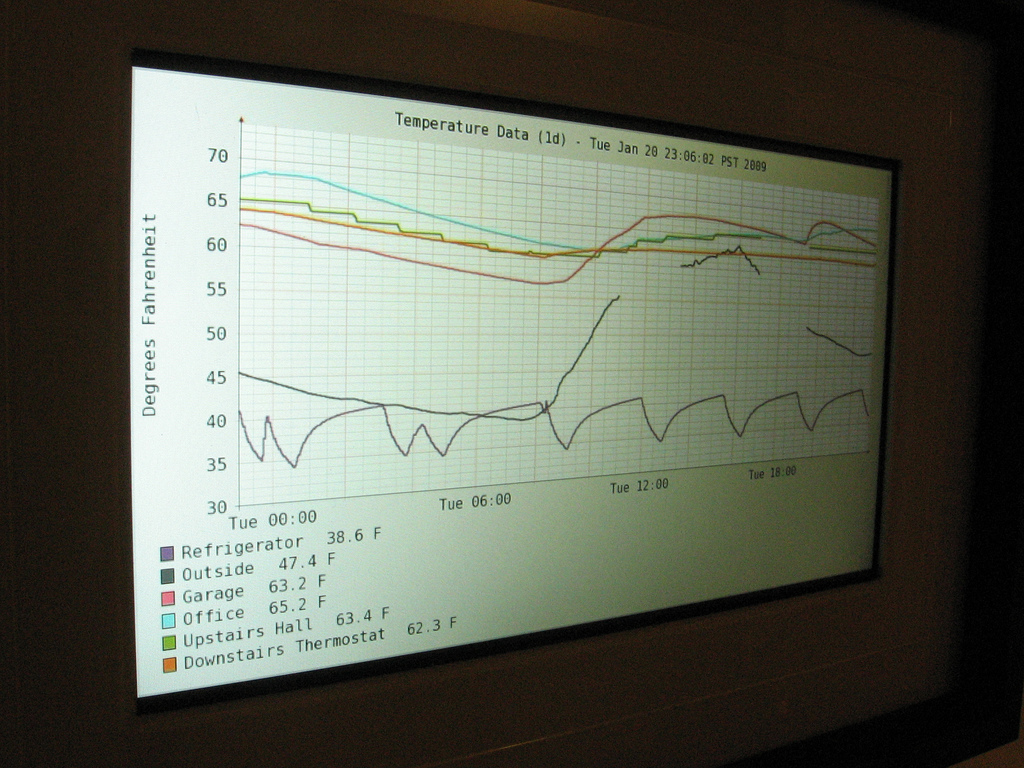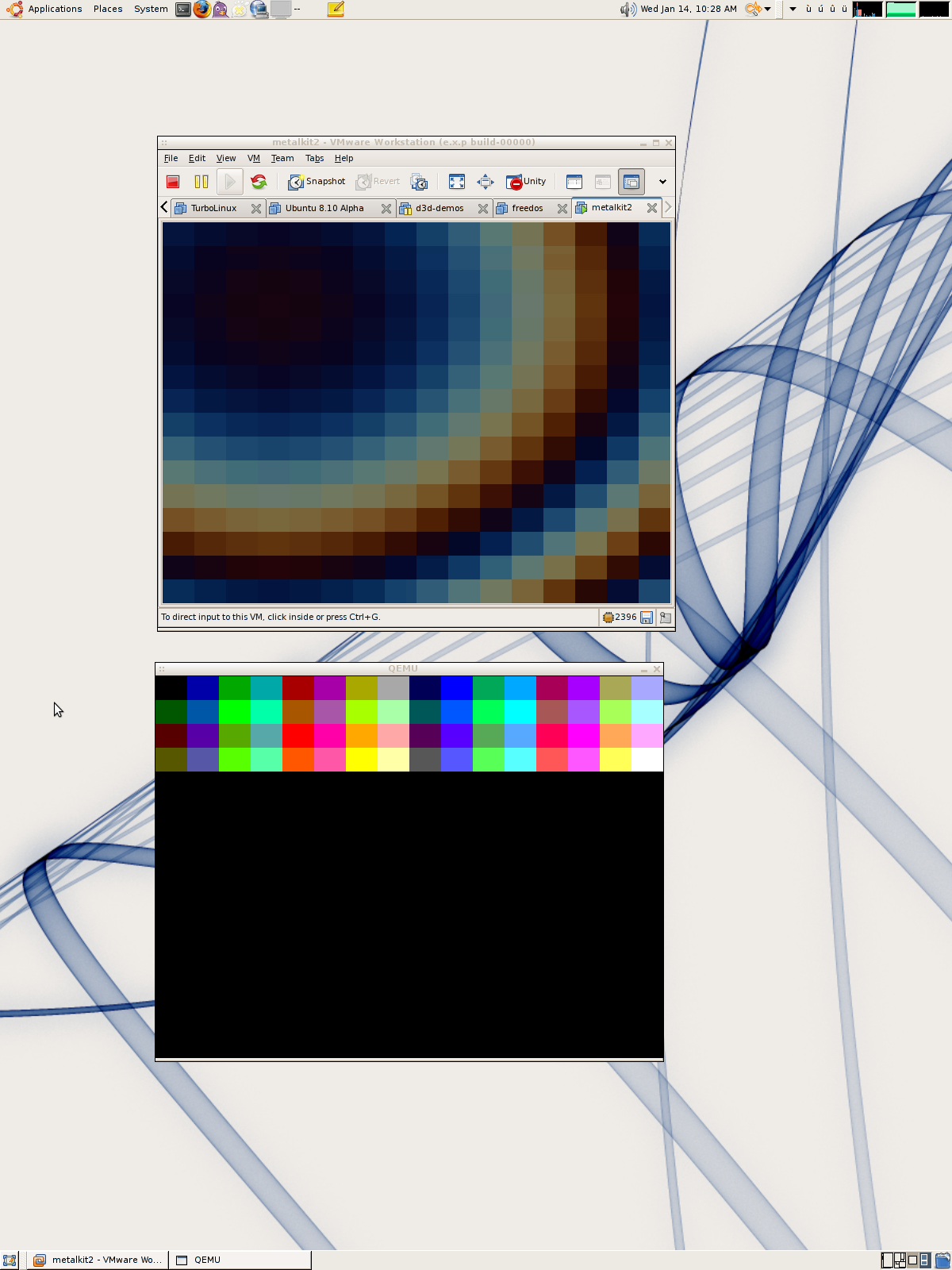Author: micah
-
scanlime055 – Pen Wiggler
It’s a vibrating robot that draws using closed loop feedback. This video was made possible by my patrons, [https://patreon.com/scanlime] Project files: https://git.approximate.life/wiggler.git/
-
scanlime053 – Active Stylus Teardown
What’s inside this “active stylus” and how does it work? No spoilers 😉 Thanks to my patrons for making these videos possible.
-
scanlime052 – Sewing Servo Mess
Finally debugging an old project. It’s a mess but we can work with this.
-
scanlime051 – Four Buttons
In which one button gets four stylish buddies, via forward and reverse engineering. Thanks to my patrons for their continued support.
-
scanlime050 – Perler Bead Shaker
Briefly looking back at an old project where I tried to push the capabilities of the first 3D printer I had, the Makerbot Thing-o-Matic designed in late 2010. This project from 2011 was intended to be a full printer or sort and place machine for fusible “Perler” style plastic art beads. I got as far…
-
scanlime049 – iCEBreaker FPGA Quick Look
Today’s video is about a package sent in by 1BitSquared with a prototype FPGA board. These boards are part of a new generation of open hardware which builds on a foundation of open source FPGA tools. At the time we streamed this live, the crowdfunding campaign was about to launch. It’s been successfully funded, and…
-
scanlime048 – Icestudio LED Matrix Driver Part 4
In the fourth and final part of our HUB75-style display driver series, we make a cool demo in gateware using the modular driver! In this segment we’ll add a frame buffer and implement a video feedback plus munching squares effect in Verilog and Icestudio. scanlime048 – Icestudio LED Matrix Driver Part 4 The Icestudio editor…
-
scanlime047 – Icestudio LED Matrix Driver Part 3
In the third part of our HUB75-style display driver in Verilog and Icestudio, we start looking at demoscene-style effects to implement next, and implement a gamma correction and dithering module to improve color quality. scanlime047 – Icestudio LED Matrix Driver Part 3 The Icestudio editor and the entire build toolchain are free and open source…
-
scanlime046 – Icestudio LED Matrix Driver Part 2
In this second part of the HUB75-style display driver in Verilog and Icestudio, we’ll debug and reorganize the existing gateware into something modular that we can build upon, with nice and stable Binary Code Modulation for brightness control. scanlime046 – Icestudio LED Matrix Driver Part 2 The Icestudio editor and the entire build toolchain are…
-
scanlime045 – Icestudio LED Matrix Driver Part 1
In this project we’ll be programming up some FPGA “gateware” using the visual Icestudio environment and the industry standard Verilog language, in order to display full color images on an inexpensive HUB75E-style LED video wall panel. This first video focuses on project bringup and just getting *something* on the screen, even if it’s a bit…
-
scanlime044 – FPGA Quick Answer
We’re doing some projects now with FPGAs, but first what even is that? This is a quick answer, compiled from the unscripted explanations I would give live. scanlime044 – FPGA Quick Answer Thank you so much for watching, subscribing, and sharing my videos. And a special thanks to my supporters on Patreon, where recurring donations…
-
scanlime043 – Diode Zone
What is Diode Zone? It’s a video site, a PeerTube instance, a friendly place you can post videos, and you can find out more in this collection of unscripted explanations from earlier live streams. Thank you so much for watching, subscribing, and sharing my videos. And a special thanks to my supporters on Patreon, where…
-
scanlime042 – New Isopod Colony
Watch on YouTube or Diode Zone: You can hang out with the new isopod colony live, or check out time lapse recordings. The microscope mount is free on Thingiverse or Github. scanlime042 – New Isopod Colony Thank you so much for watching, subscribing, and sharing my videos. And a special thanks to my supporters on…
-
scanlime041 – Pineapple Slime Oscillator
Watch on YouTube or Diode Zone: Assemble the Boldport Ananas with me, in a trippy music video full of fluorescent goo and disco ball motors! This is a fun electronics kit that calmly pulses its yellow LEDs with a set of transistorized ring oscillators. Thank you so much for watching, subscribing, and sharing my videos.…
-
scanlime040 – Test Jig Quick Look
I found these two test jigs for sale at a local business that was relocating. They would have been used as part of the quality assurance procedure for smart bike lights. Later we might go into more detail on the firmware, or repurpose the formidable hunks of metal for another project! Thank you so much…
-
scanlime039 – Unboxing Cameras and LEDs, USB 3 and pre-UNIX
In my live streams I’ve been inviting you to send me new reverse engineering projects at my P.O. box. In these videos, I’ll introduce a few of the items I’ve been receiving, with a bit of the mystery preserved! Thank you so much for watching, subscribing, and sharing my videos. And a special thanks to…
-
scanlime037 – Squishy Resistor Repair
These wire-wound resistors have seen better days, and my trusty Orion Delta printer from SeeMeCNC needs a replacement heater. More recent printer designs use cartridge heaters, but this’ll be an oldschool repair with fresh resistors and silicone goop. After the repair, I’ll do a test print with time lapse! Thank you so much for watching,…
-
scanlime036 – DaveCAD Sticky Printer
Some of you may know about a fancy CAD package used by a certain popular electronics rambler on utube, and I wanted a piece of that sweet handwritten design. Hanging with Tuco Crew one night, the tiger and I put this crack together. Milled linoleum printing block, 3D printed alignment jig, and as many copies…
-
scanlime035 – Lite2Sound BC
Is there a synthesizer in your LED, or a song in the shadows? Are your lights quiet or do they roar? This surface mount soldering kit from Boldport and Rare Waves will help you hear the audio-frequency signals that hitch a ride on any light source, whether it’s modulated LEDs or the shadow of fluttering…
-
scanlime034 – Tiny Oven Kit
This cute 3D soldering kit makes for a chill build video. The package comes our way as a crowdfunding reward, from pitching in to help Signal Ditch buy a reflow oven. Now we can all enjoy the sights and sounds of the build, but sadly I can’t share the sweet epoxy fumes. (Please do not…
-
scanlime033 – Robot Odyssey Full Playthrough
Is this a YouTube first, a full play of the whole game? It’s a classic that many have lost patience for, including my childhood self. It’s like if Atari 2600 Adventure were full of digital logic puzzles. Let’s do this, play through from start to finish, and test the new WebAssembly port I’ve been making!…
-
scanlime032 – Early Flyer View
Tuco Flyer is actually flying now, so let’s see what it can do! This is a high-level update on where the project is at and what the next steps are. And cat! Lots of Tuco the cat. This project is open source hardware and software, you can get the code and designs on GitHub. Music…
-
scanlime031 – Zoom H2
Just a quick video as I keep the equipment running: my Zoom H2 microphone was damaged thanks to some leaky batteries, but a brush and some Deoxit and isopropanol help me get it running again. Music for this episode is “Hot Drop Potato” by Jesse Spillane, licensed under CC BY 3.0 Please consider supporting me…
-
scanlime030 – Why Reverse a Gimbal
Why do all this gimbal reversing? It works so nicely now, and I didn’t need to design the whole thing from scratch! Notes and tools are in GitHub: https://git.approximate.life/fygimbal.git/ https://github.com/TucoFlyer Music for this episode is “I Don’t See the Branches, I See the Leaves” by Chris Zabriskie, licensed under CC BY 3.0 Please consider supporting…
-
scanlime029 – Bad Gear
A winch gear split, taking a closer look and failing to repair it. How would you fix this nylon helical gear? Music for this episode is “パワーポイント” (Power Point) by Anonymous420, available under a CC0 1.0 Universal license. Please consider supporting me on Patreon so I can keep making these vids! I’m also trying out…
-
scanlime028 – Four Winches
Continuing our Tuco Flyer robotic camera project, this montage covers the remaining electronics assembly and bot calibration to get our winches flying a 1.5kg spool around the shop! Music for this episode is “Something Elated” by Broke For Free, licensed under CC BY 3.0, remixed slightly. Please consider supporting me on Patreon so I can…
-
Smart Camera Gimbal Bot – scanlime:027
In this episode, we’re building the Tuco Flyer bot itself, and giving it the power of computer vision so it can look around and follow my cat. Please consider supporting me on Patreon so I can keep making these vids! https://www.patreon.com/scanlime I’m also trying out Liberapay as an alternative to Patreon, if you’d like to…
-
Winch Bot – scanlime:026
Finally some locomotion for the flying camera system, it’s a 3D printed 1-dimensional robot that knows how to hang out on a network and pull rope. Please consider supporting me on Patreon so I can keep making these vids! https://www.patreon.com/scanlime Subscribe to YouTube notifications or follow https://twitter.com/scanlimelive for live streaming announcements.
-
bigclive’s LED Tree – scanlime:025
Join me in assembling a surprise LED lighting kit from bigclive himself! Check out his channel at https://www.youtube.com/user/bigclivedotcom Subscribe to YouTube notifications or follow https://twitter.com/scanlimelive for live streaming announcements. I’m also streaming on Twitch now, at https://twitch.tv/scanlime Please consider supporting me on Patreon so I can keep making these vids! https://www.patreon.com/scanlime
-
Boldport Stringy Synthesizer – scanlime:024
Last month’s Boldport Club kit was a collaboration with Madlab to produce this beautiful little guitar synthesizer kit, the Stringy! You can learn more about the Boldport Club and get your own delighful kits by signing up at https://www.boldport.club/ Please consider supporting me on Patreon so I can keep making these vids! https://www.patreon.com/scanlime Subscribe to…
-
Intel Euclid Teardown – scanlime:022
This is a teardown and quick look at the Intel Euclid, a new developer platform for robotics which combines an Atom CPU and RealSense depth cameras. This video was filmed in front of a live Internet audience. Stream archive: https://youtu.be/tIGvWYMwLzA Please consider supporting me on Patreon so I can keep making these vids! https://www.patreon.com/scanlime Subscribe…
-
Feiyu Gimbal Serial Hack – scanlime:021
Join this reverse-engineering journey where I wind through software and hardware in a Feiyu Tech Mini3D gimbal, in order to give it serial controls more suitable for my Tuco Flyer robot project. I start out by taking apart the wire protocol used by the settings app, then after accidentally breaking the gimbal we have to…
-
scanlime:019 / Gimbal SDI Camera Mod
This is a mechanical and electrical modification to the Feiyu Mini3D 3-axis brushless gimbal, so it can hold a Crazyfire HZ-100P SDI camera and LIDAR-Lite distance sensor. Now I can use this small and inexpensive gimbal for the new live streaming cat robot! Please consider supporting me on Patreon so I can keep making these…
-
scanlime:018 / Tuco the Cat’s Robot
Meet my cat, Tuco. He’s a polydactyl American Curl kitty who loves fetching nylon 1/4-20 bolts. This is a video introduction to the new project I’m building and streaming, a camera robot for interacting with Tuco online. Please consider supporting me on Patreon so I can keep making these vids! https://www.patreon.com/scanlime Subscribe to YouTube notifications…
-
scanlime:017 / Boldport #3, Cordwood Puzzle
Assembling the Cordwood Puzzle, an electronics kit from the Boldport Club subscription service. It’s a close look at a relaxing build with a vintage look and delightfully unique design. Check out Saar’s work: https://www.boldport.com/ This video was filmed in front of a live Internet audience. Stream archives: Dec 2, 2016: https://youtu.be/OodND7hXA-A?list=PLhbhmdpDp9xFvxH7lYiD0mnCrw4dqgasJ Dec 4, 2016: https://youtu.be/zGrPml4o_Cg?list=PLhbhmdpDp9xFvxH7lYiD0mnCrw4dqgasJ
-
scanlime:016 / Shiny Blue Vacuum Fluorescent Pole Thing
I’ve been streaming lots of live forward and reverse engineering lately, and I’m about to start editing some of the recent work into a multi-part series of videos! But this little self-contained project had been sitting partially-edited in my queue so long, I had to give it the finish it needed. Here we have a…
-
scanlime:015 / Glitchy Descriptor Firmware Grab
To understand a program, it helps to see it first. This episode is all glitching and USB, turning a chip’s environment against it to slurp out hidden code. Get the source and play along: https://git.approximate.life/facewhisperer.git/ The tool I use here is the ChipWhisperer. I’m not being paid or anything, I’m just a fellow hardware engineer…
-
scanlime:014 / Boldport #2 – Superhero
Finally, another Boldport video! This time a short music video based on the Engineer Superhero kit, assembled in original form and in a variant that includes a coin cell to power the LED and a piezo button to charge the 2N7000 MOSFET gate and make the LED glow for a while. The sound track was…
-
scanlime:013 / Wacom Teardown and Schematic
This time we’re looking at the protocol that powers Wacom’s wireless pens, and taking a deep look into the logic circuits (74xx!) that make them run. If you missed the last video, check it out for the big picture on how graphics tablets work: https://youtu.be/nPab7pbOhBY Get your own copy of the schematics in PDF or…
-
scanlime:012 / Graphics Tablet Primer for Hackers
This time we’re hurtling through the layers of technology that make a graphics tablet (pen tablet) work, from operating systems politics to electromagnetic induction. I’ll be looking closely at two tablets, the Wacom Intuos Pro and Huion H610PRO, and going into a full teardown on the Huion.
-
scanlime:011 / Ultrasonic Transducer
This video takes a close look at those little chirping sonar cylinders that might have helped your robot avoid bumping into furniture. They’re sort of like a microphone or a speaker, but looking closer they seem more like a tiny tuning fork with a hat.
-
scanlime:010 / Protek B8010FD Function Generator
I had another video planned, but today the yak stack needed tending after my trusty 10 MHz signal generator started buzzing horribly. Today’s video will be a teardown, repair, and mini-review of the 2007 vintage Protek B8010FD.
-
scanlime:009 / Flame Effect
Let’s use the glow discharge in a flicker flame bulb to make some weird neon art. This video is a photographic tour and rebuild of a simple glowthing made from a novelty light bulb and an old CCFL backlight inverter. It might have left me with more questions than answers after the laser pointers came…
-
scanlime:008 / Boldport #1 – Pease
I jumped at the opportunity to get hardware in the mail from another like-minded art hacker. In this video I’ll unbox the kit, assemble it delicately, and finally I’ll have to make some squiggles and beeps with it. Link to Saar’s Boldport Club: https://www.boldport.com/club You can also hear more from Saar himself in this episode…
-
scanlime:007 / USB Disk Recorder Part 2
Continuing the adventures from Part 1, this video wanders along several tangential paths, trying to get some data out of this device worthy of reversing. This time we spend a bit more time in IDA looking for Z80 code, tinker with SCSI trying to break things, and we even do some necromancy in trying to…
-
scanlime:006 / USB Disk Recorder Part 1
This time I find something in my junk drawer with a few teeth marks on it, and it leads to a weirdly specialized CPU built on a super oldschool core.
-
scanlime:005 / Microphone Receiver
I take apart a Pyle PDWM1940 wireless microphone receiver, searching for a way to make the output less noisy. Meanwhile, I’ll be using the same receiver for filming.
-
scanlime:004 / Electronic Whiteboard hacking
My friends at Tangible Interaction sent some electronic whiteboard hardware to take apart. In this video I’ll start to look at the transmitters, receivers, and communication protocol.
-
scanlime:003 / Robot Odyssey DS
A quick look back at my partially complete console port of an old DOS game. Source on github: https://github.com/scanlime/robot-odyssey-ds
-
scanlime:002 / Coastermelt Part 2
Part 2 in the series on hacking optical drives for fun! Source code at https://github.com/scanlime/coastermelt
-
scanlime:001 / Coastermelt Part 1
The first in a series about reverse engineering optical drives for fun and maybe laser graffiti.
-
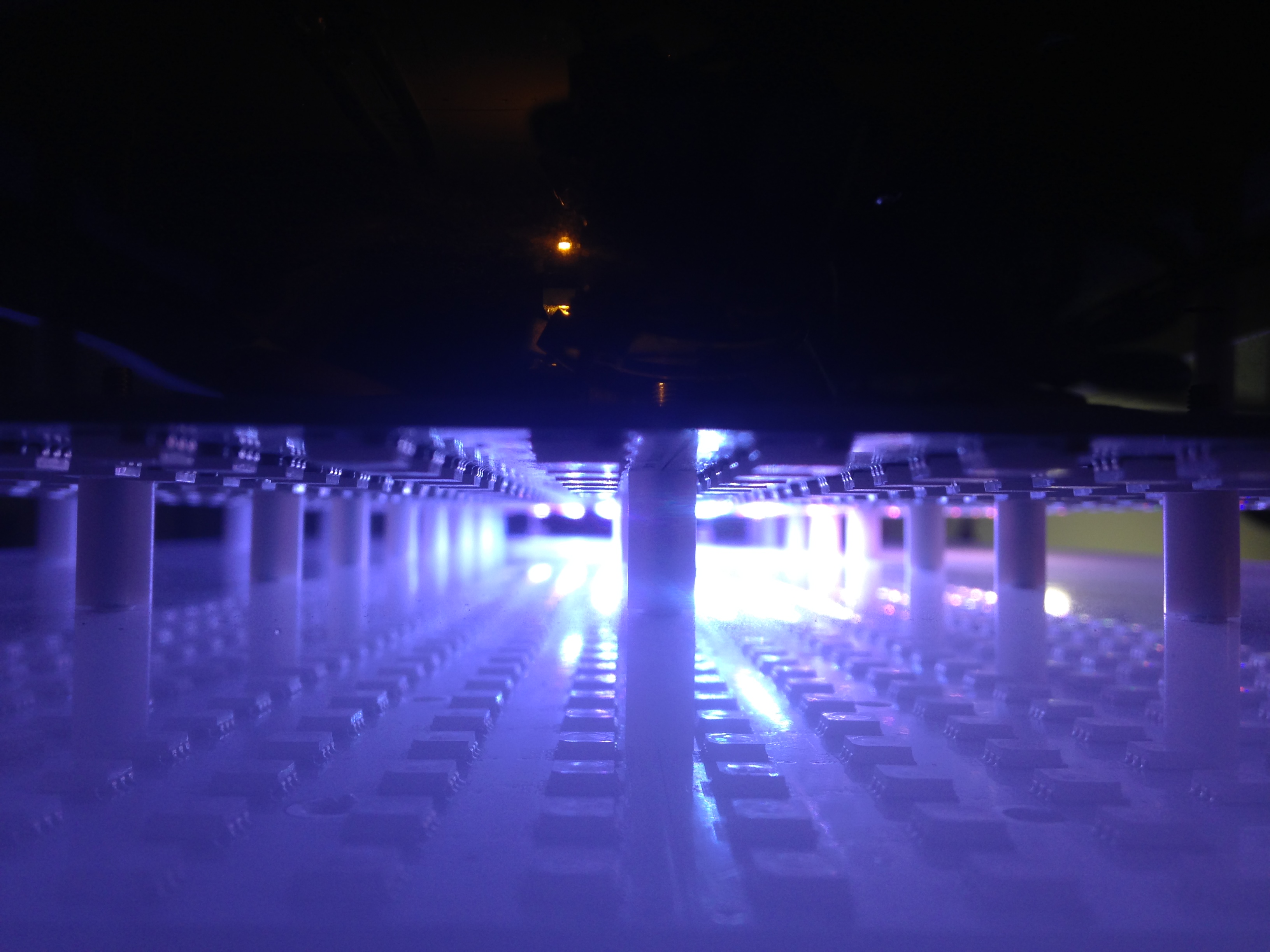
Fadecandy video updates
I’ve been super busy lately, working on a new installation. I’m excited to document the process more at some point, but for now I have some videos to share with new LED effects I’ve been working on:
-

HQZ rendering with Blender and Maya
Damien Picard has been doing some neat things with my High Quality Zen rendering engine.
-
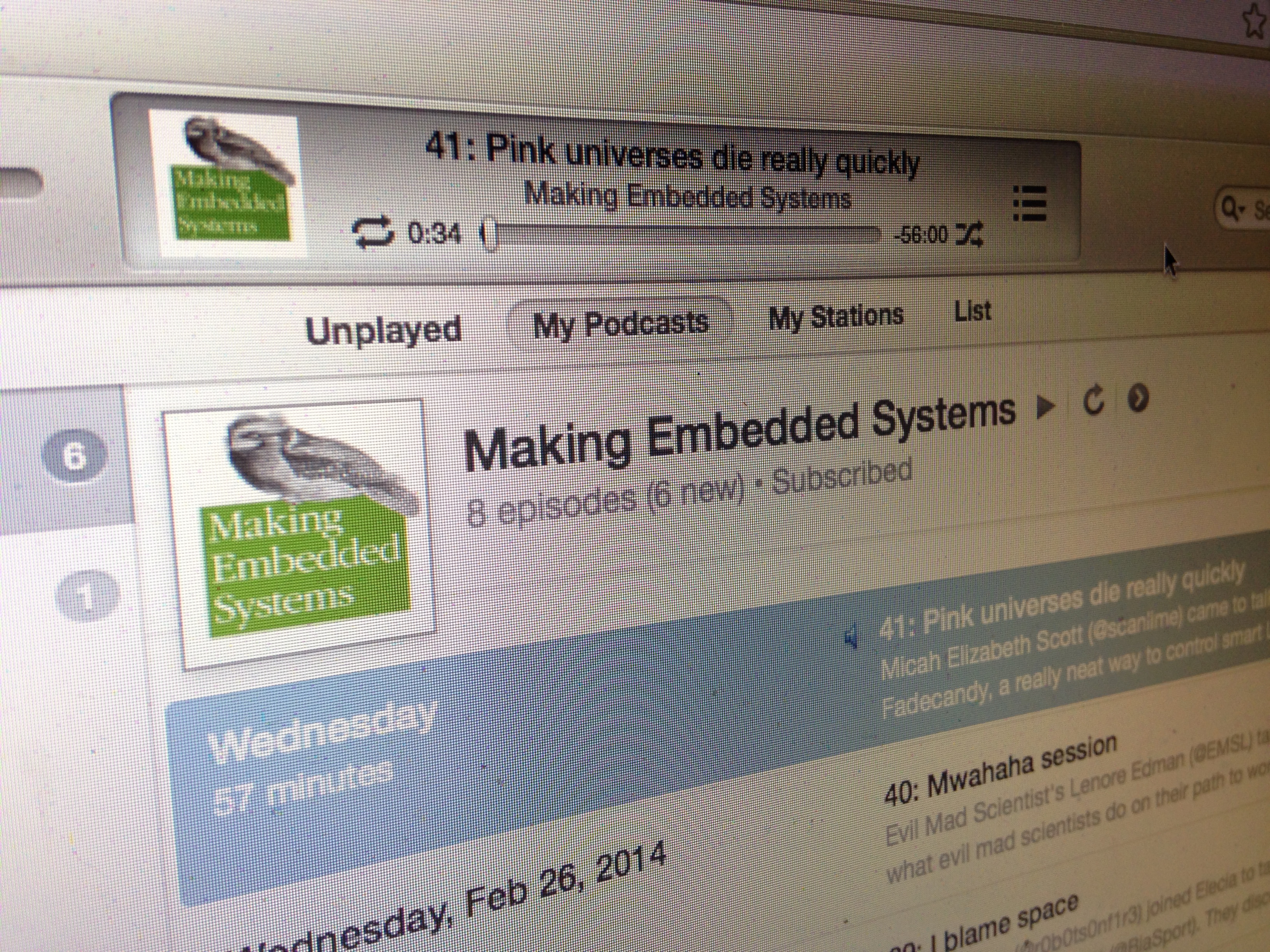
Fadecandy on the Making Embedded Systems podcast
I recently had the opportunity to speak with Elecia White on the Making Embedded Systems podcast about Fadecandy. The conversation ranged from beautiful LED control algorithms and open source embedded projects to triangle tessellations, art, and identity.
-
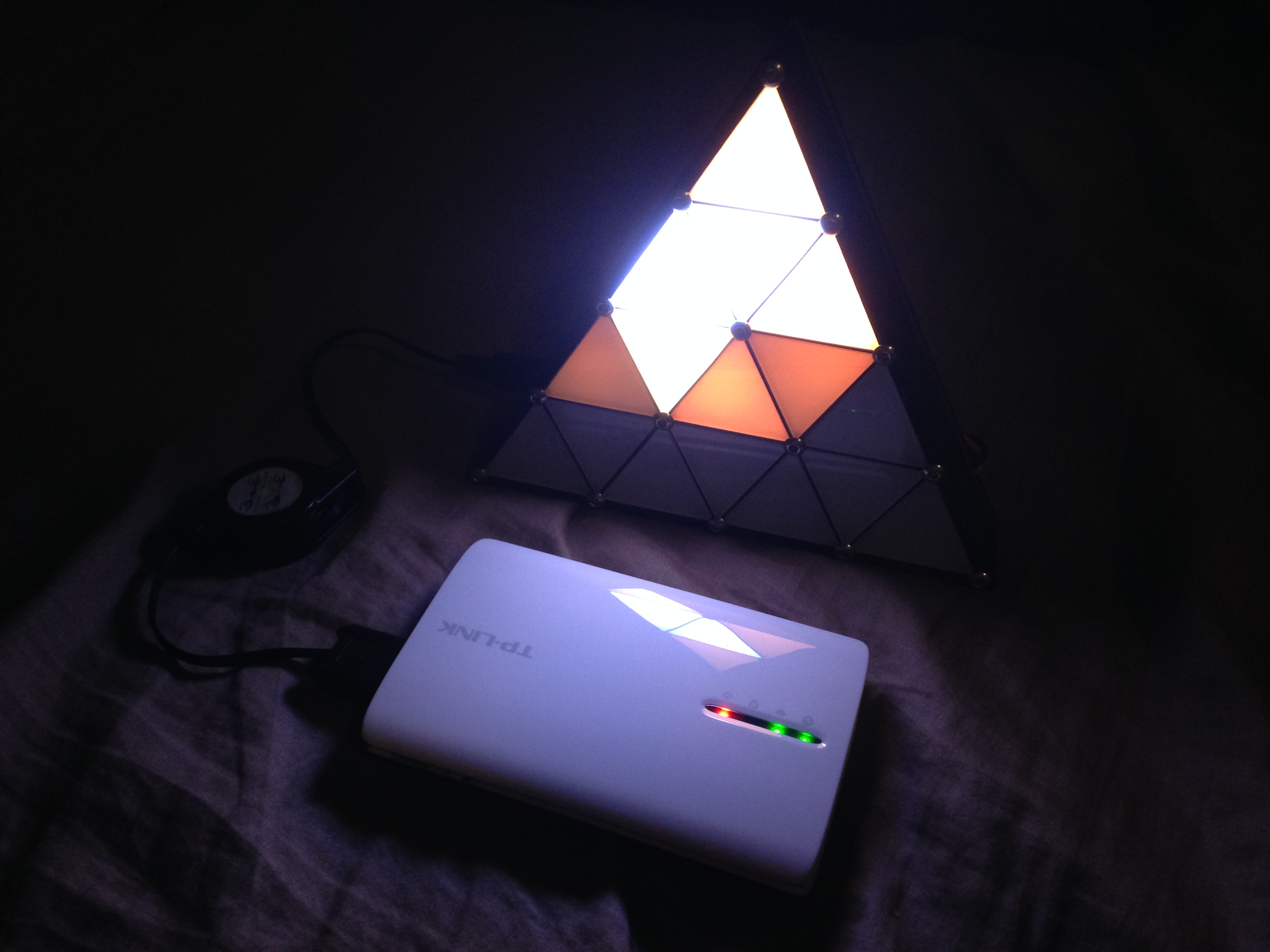
Standalone WiFi Fadecandy server
This week, nemik posted a package for OpenWRT that makes it really easy to run the Fadecandy server on a cheap battery-powered WiFi router. I just got my router in the mail, and I recorded a quick video demo.
-
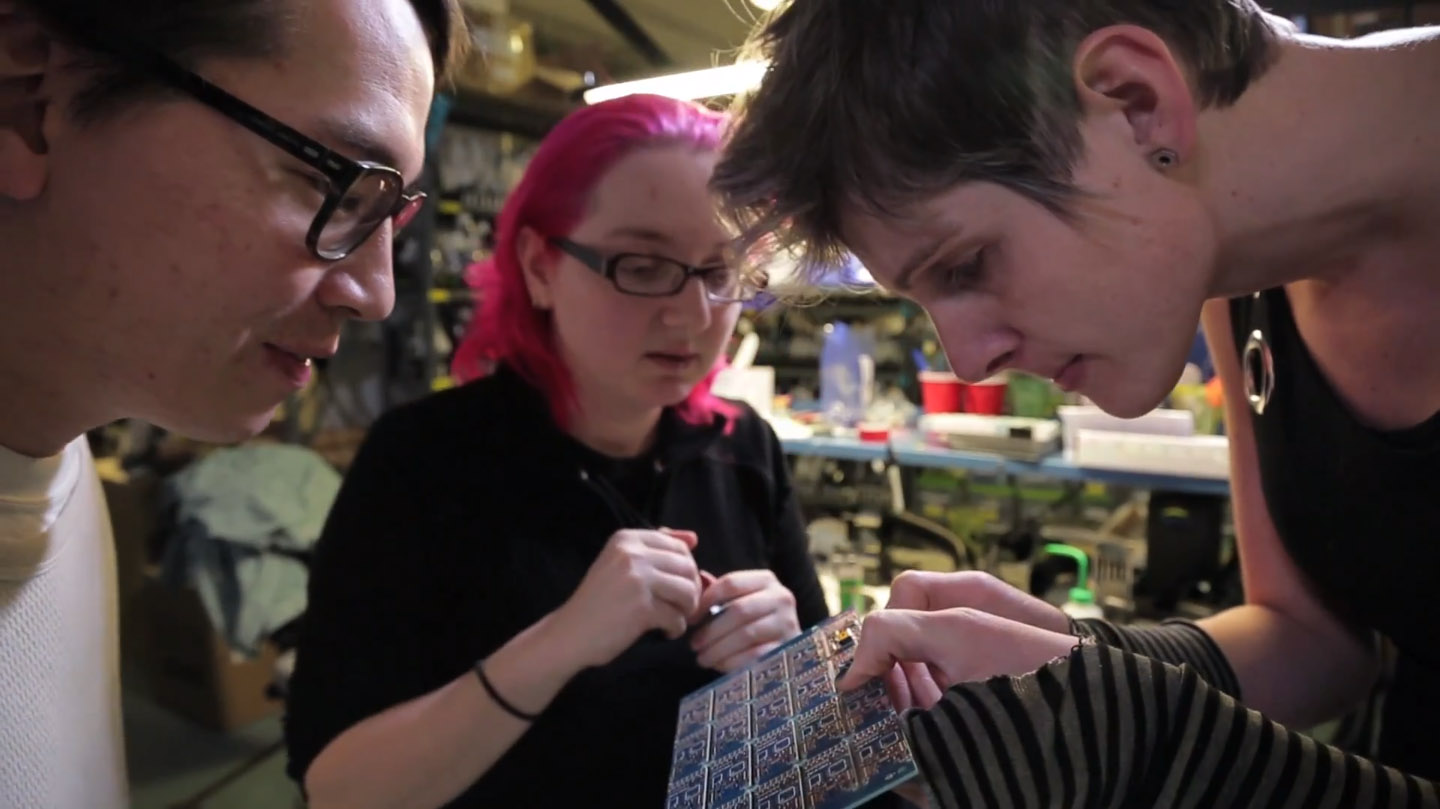
Fadecandy: How it’s made
I was at the Adafruit warehouse in Manhattan a couple weeks back, where we ran the first Fadecandy boards through their assembly line. The boards are now in the Adafruit catalog, and we made a video about the manufacturing process.
-
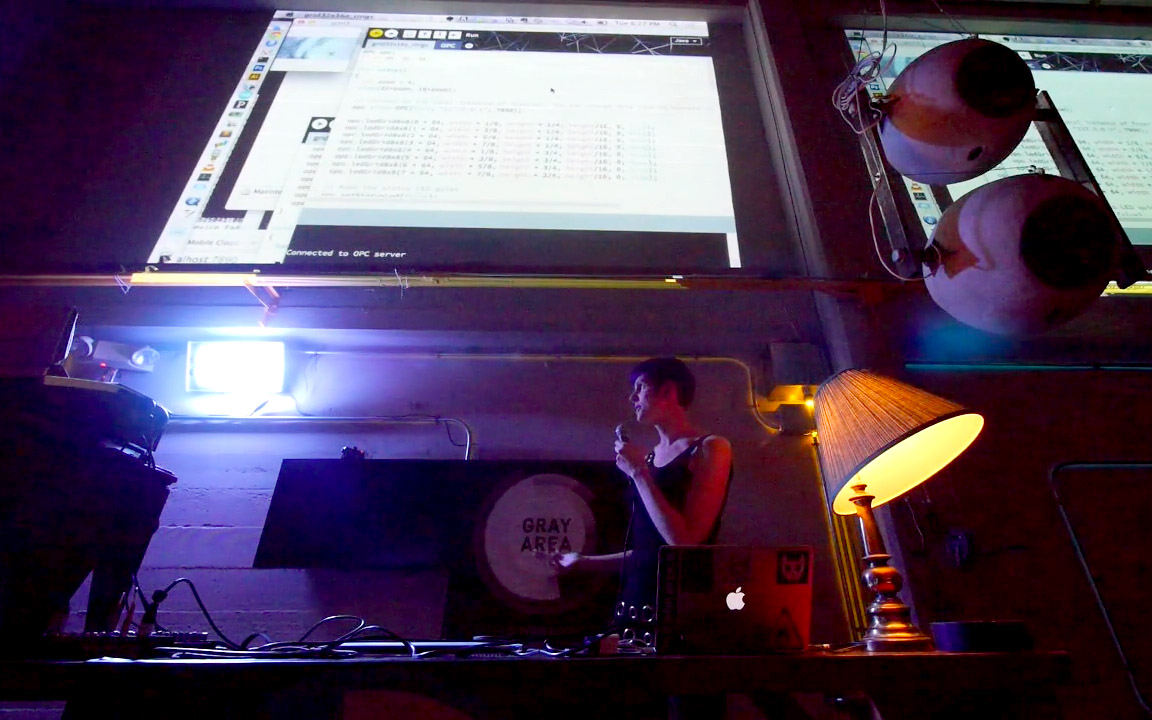
Presentation at GAFFTA Creative Code Meetup VII
I gave a talk at the GAFFTA Creative Code Meetup back in November. It was a brief overview of my recent work including Zen Photon Garden, High Quality Zen, the Ardent Mobile Cloud Platform, and Fadecandy. It includes a live demo of Fadecandy, starting at 18:43. Creative Code Meetup VII- Micah Elizabeth Scott from GAFFTA…
-
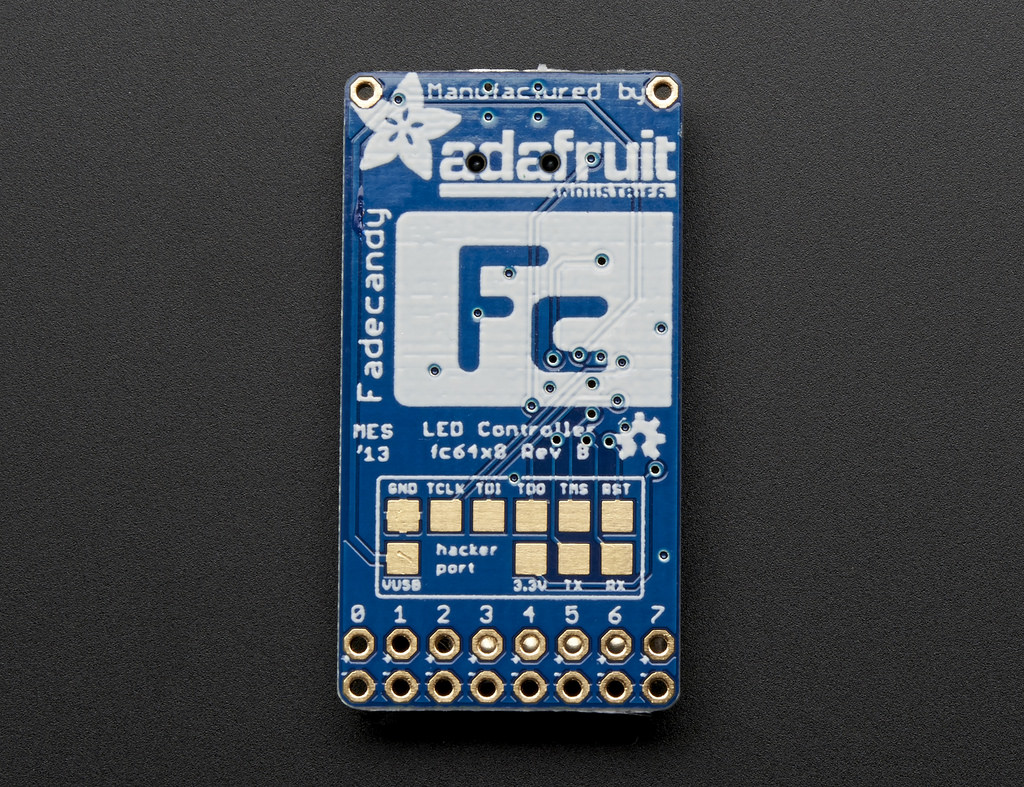
Fadecandy Controller available from Adafruit
The Fadecandy controller (initially announced here) is a new USB interface board for making more expressive art installations using the widely available WS2811 “NeoPixel” LED strips. It controls up to 8 strips of 64 LEDs, and it includes a unique dithering algorithm to help you quickly get the best quality color from each of your…
-
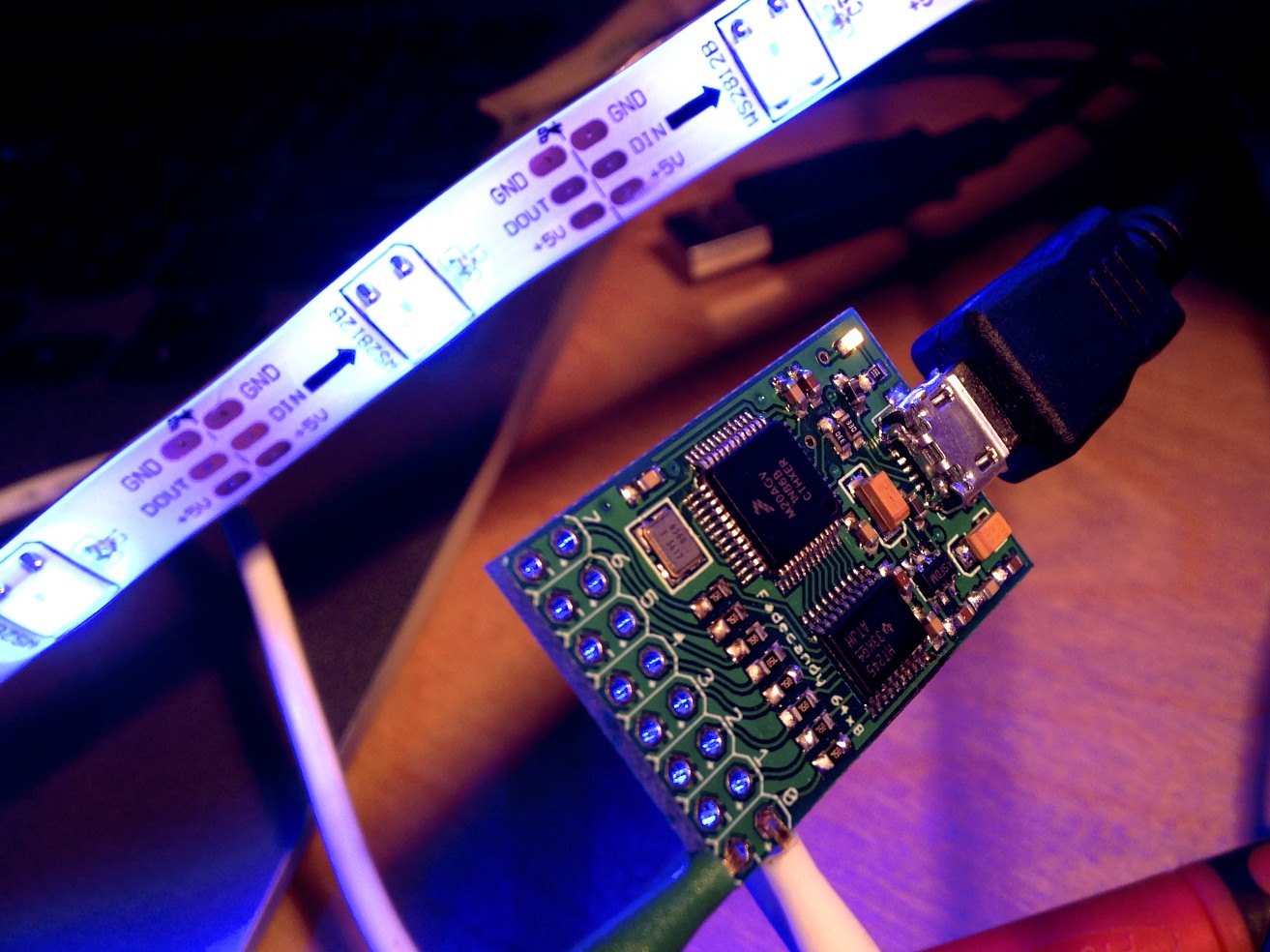
Fadecandy: Easier, tastier, and more creative LED art
I’ve been working on a project lately that I’m really eager to share with the world: A kit of hardware and software parts to make LED art projects easier to build and better-looking, so sculptors and makers and multimedia artists can concentrate on building beautiful things instead of reinventing the wheel. I call it Fadecandy.
-

Slides from Arse Elektronika 2013
Arse Elektronika is a yearly conference that focuses on the intersection of sex and technology. It’s almost too San Francisco, but it actually comes from the weird Austrian art group monochrom. And it’s a lot of fun! This year I was invited to give a talk on my sonar-controlled vibrator. I even won a really…
-
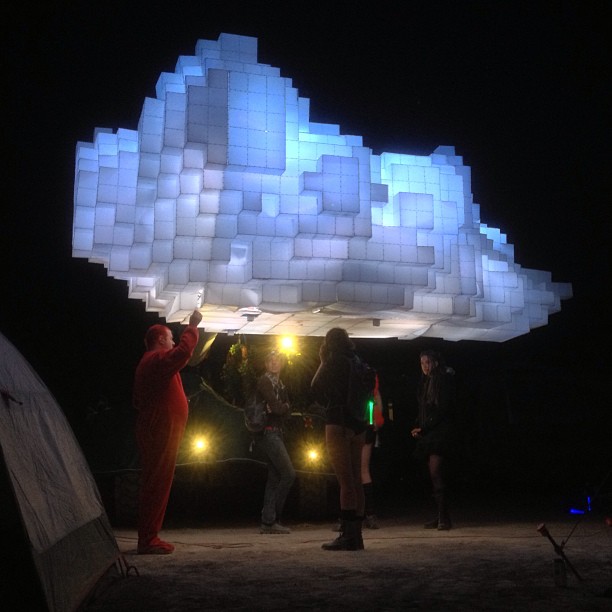
The Ardent Mobile Cloud Platform
This year I had the pleasure of working on a big art project for Burning Man with a wonderfully talented group of artists and engineers in my community. It started with a simple idea: Let’s bring a variable reach forklift to Burning Man, and put a cloud on it.
-

High Quality Zen
Announcing High Quality Zen, a batch renderer based on Zen photon garden. I built it as a way to further experiment with this 2D raytracing style, adding animation and color.
-

-
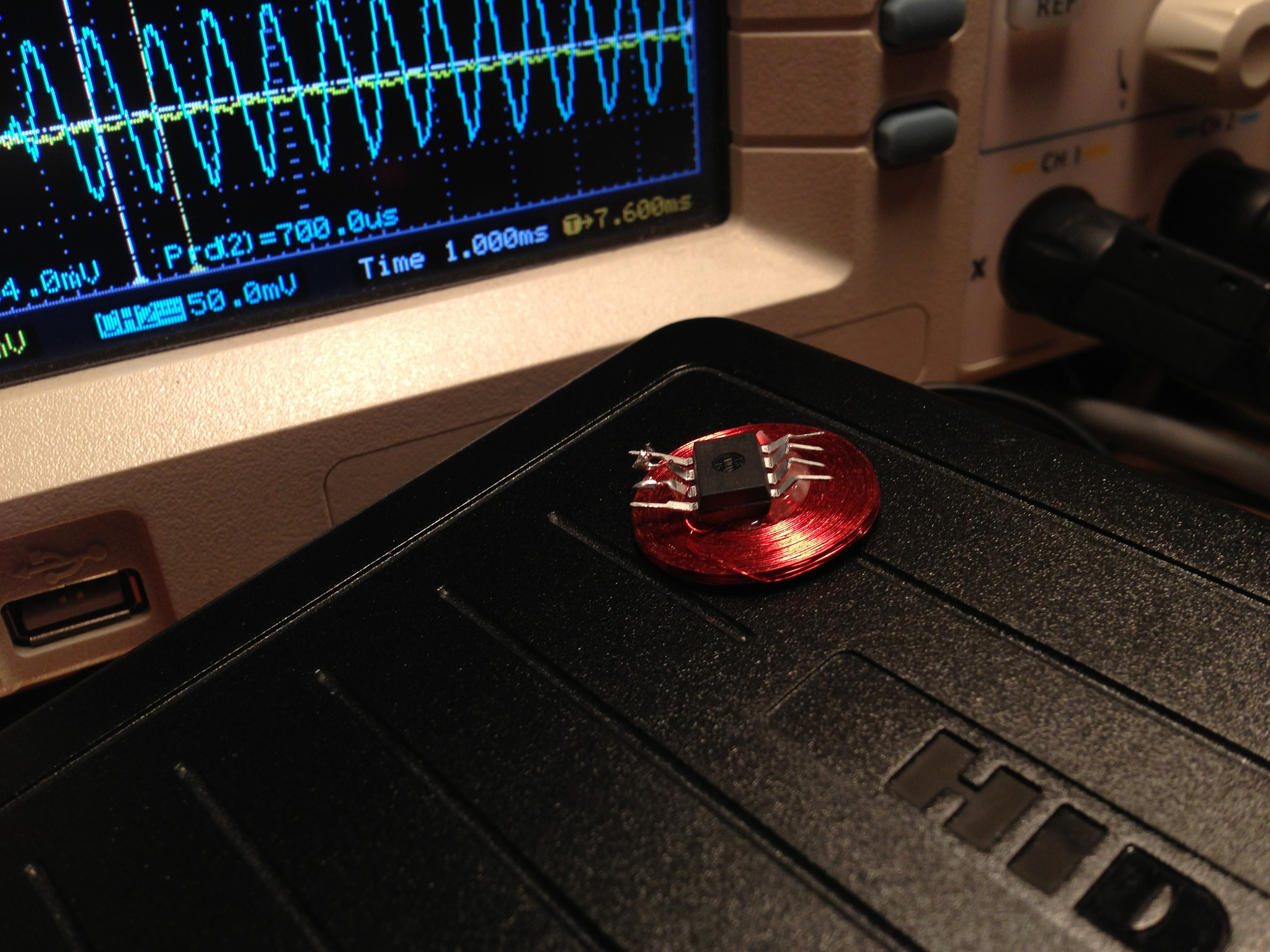
AVR RFID, Optimized and Ported to C
Way back in 2008, I posted a writeup about using an AVR microcontroller as an RFID tag. Since then, it’s been great to see many people pick up this code and build their own DIY RFID tags. In my original project, I was just interested in using an AVR as a way of emulating any…
-
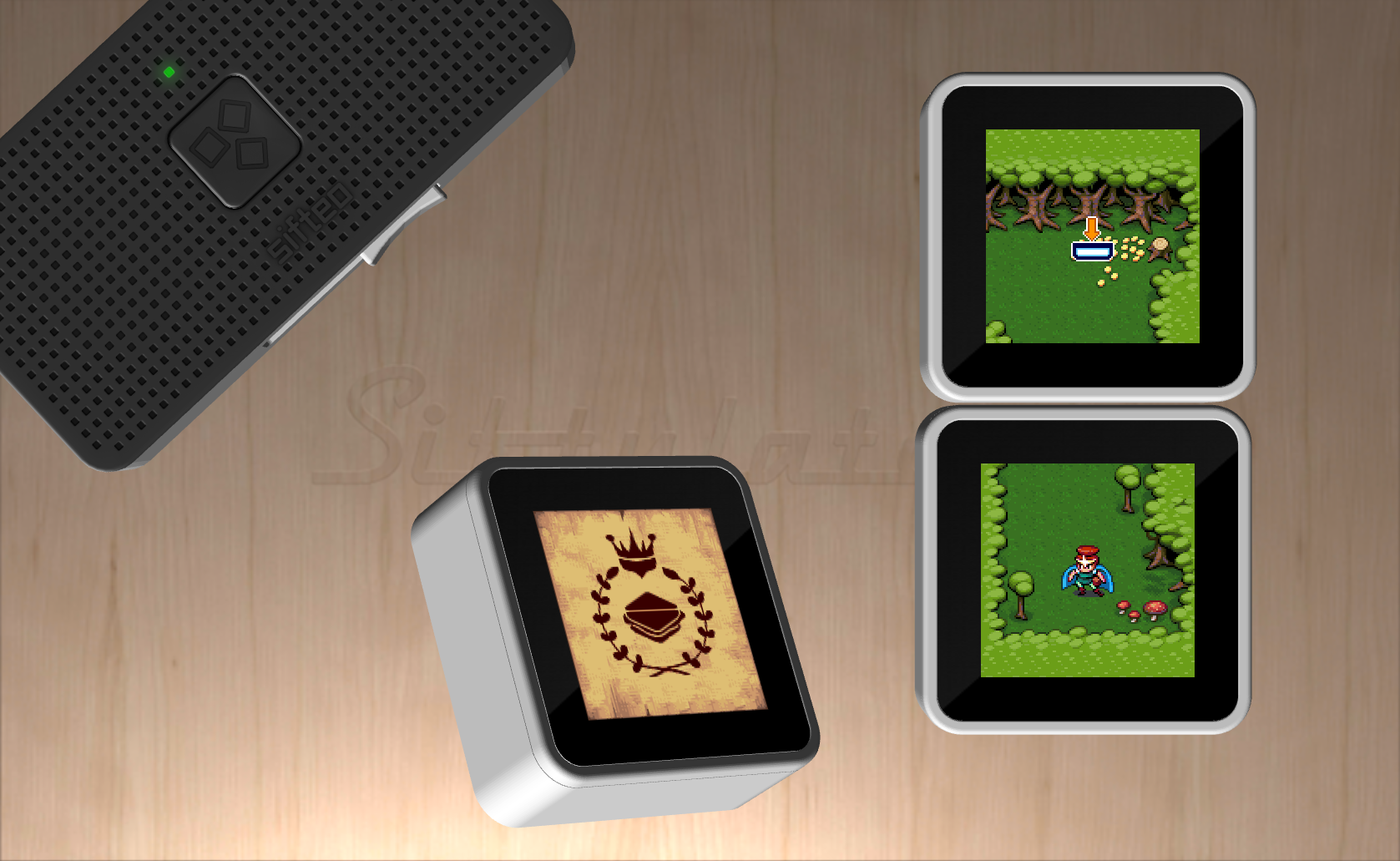
How we built a Super Nintendo out of a wireless keyboard
This is a guest article I wrote for Adafruit, on the story of how we built the hardware behind the new Sifteo Cubes, our second generation of a gaming platform that’s all about tactile sensation and real, physical objects.
-
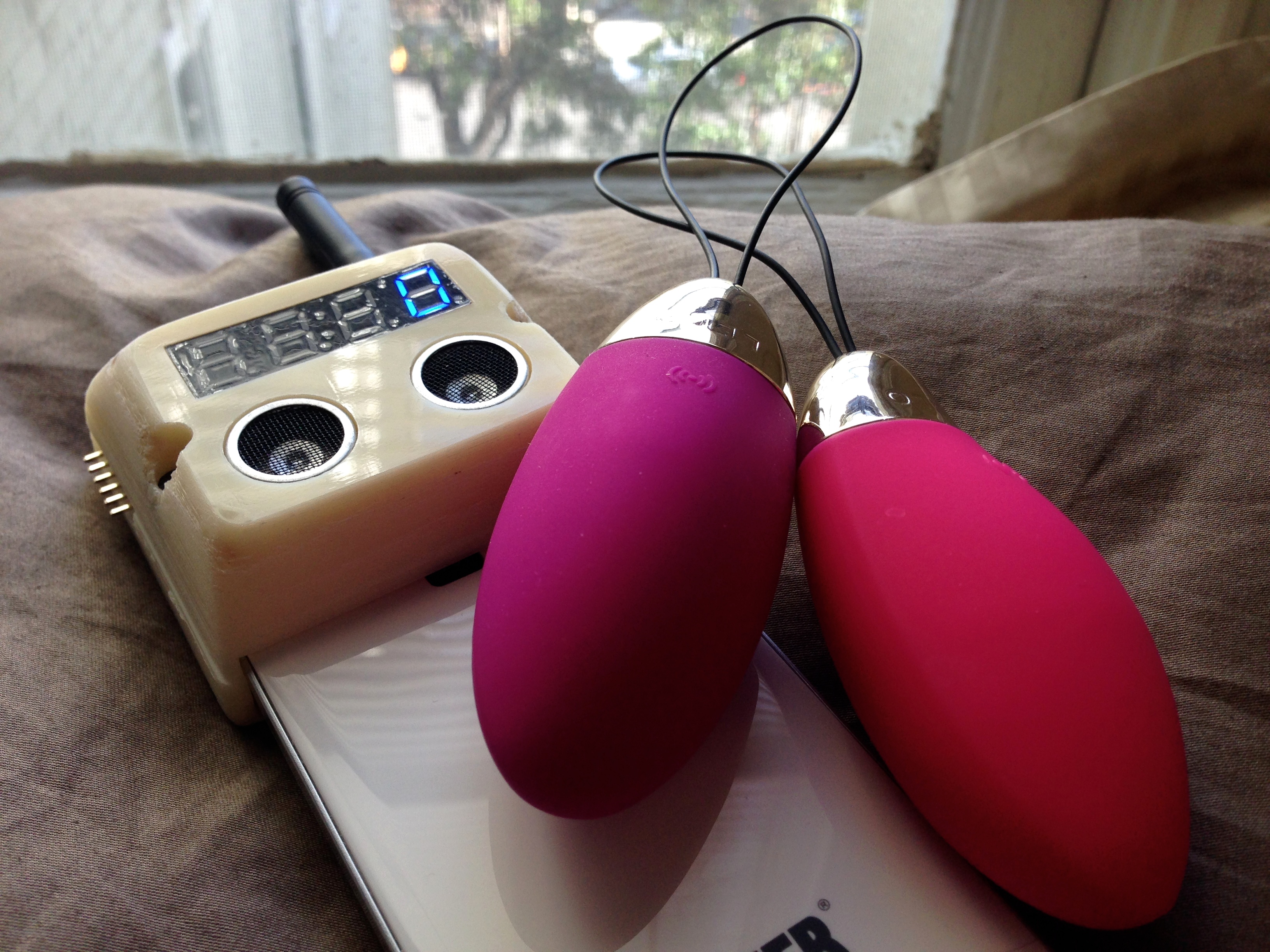
Hacking My Vagina
To me, a good sex toy helps form feedback loops. It doesn’t get in the way. A good toy gives you simple ways of exchanging signals with a partner or with your own body. It acts as a conduit. A good sex toy is analog.
-
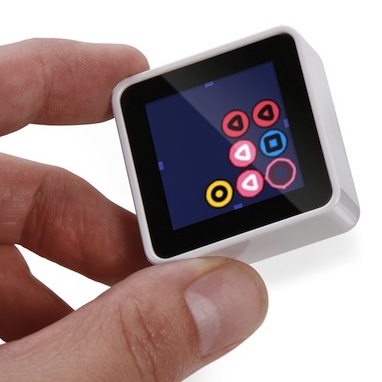
Sifteo and San Francisco
Moving to The City, starting a new job at Sifteo, and a month-long trip to Thailand!
-

X-10 SmartRemote
I’m not even sure why I built this at all. I guess I did always have a childhood fascination with making things that seemed professional in some way. A simulacrum of some expensive piece of A/V equipment, or simple computer games that came in a shoe box with construction-paper cover art. This is another ancient…
-

LEDboard/144
This is a 9×16 LED matrix I made by hand back in 2004, with LEDs I had left over from another, even sillier project. It has a USB interface powered by a PIC16C765 microcontroller, one of the first to feature a built-in USB device interface. This video post is something of a eulogy for the…
-
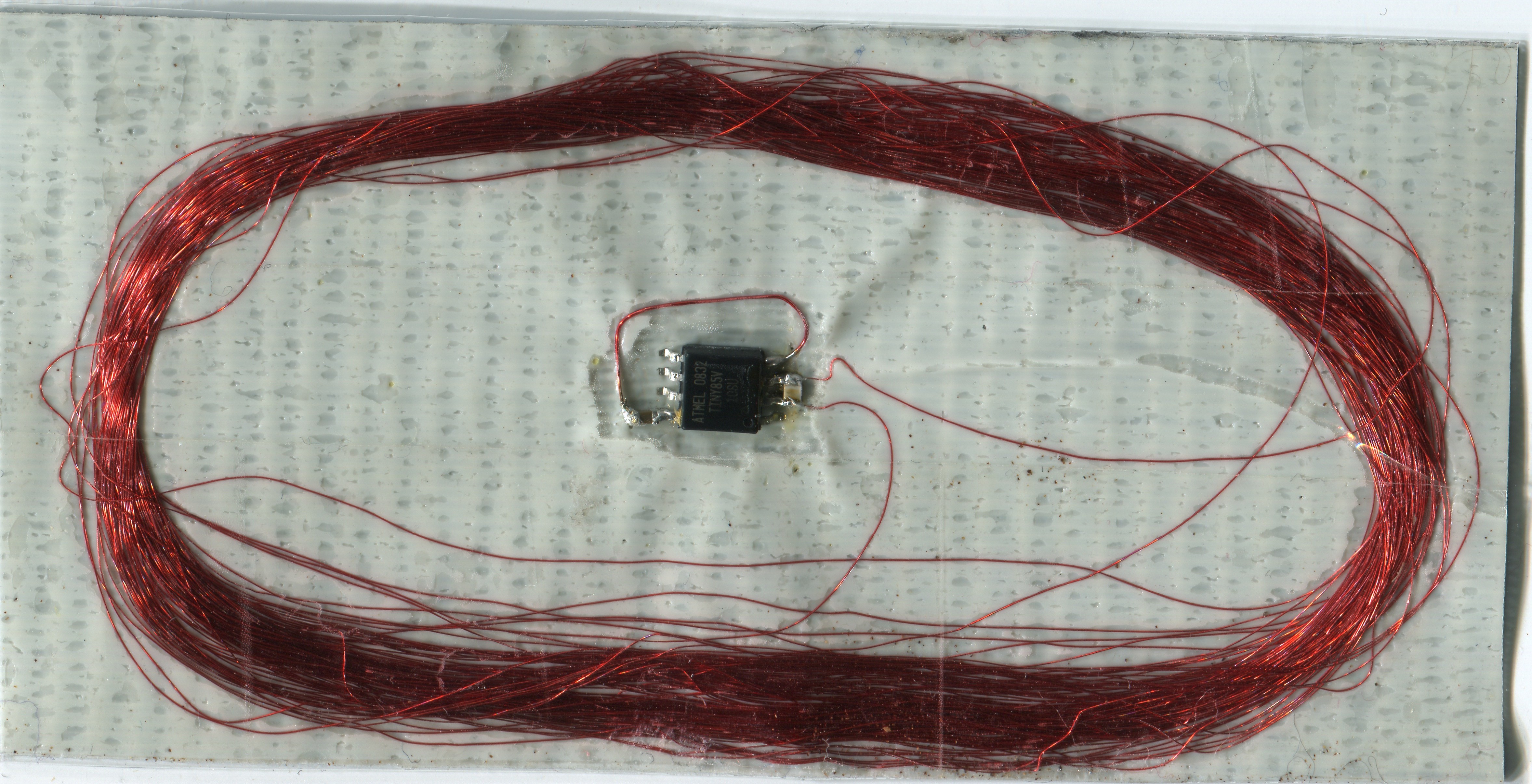
Duct tape RFID tag #1
This is just a messy first prototype, but I recently tried making an AVRFID tag on a substrate of duct tape. The first attempt involved: An upside-down strip of duct tape, as the base for everything else to stick atop 100 turns of AWG 40 magnet wire around a ~66mm diameter form, which I then…
-

CIA.vc service is down indefinitely
For those who haven’t seen it: CIA.vc is a web service I started about 8 years ago, as a way of Open Source projects tracking code changes in real-time over the web and IRC. This is probably going to come as a surprise to most of you reading this, but today I’ve taken the CIA.vc…
-
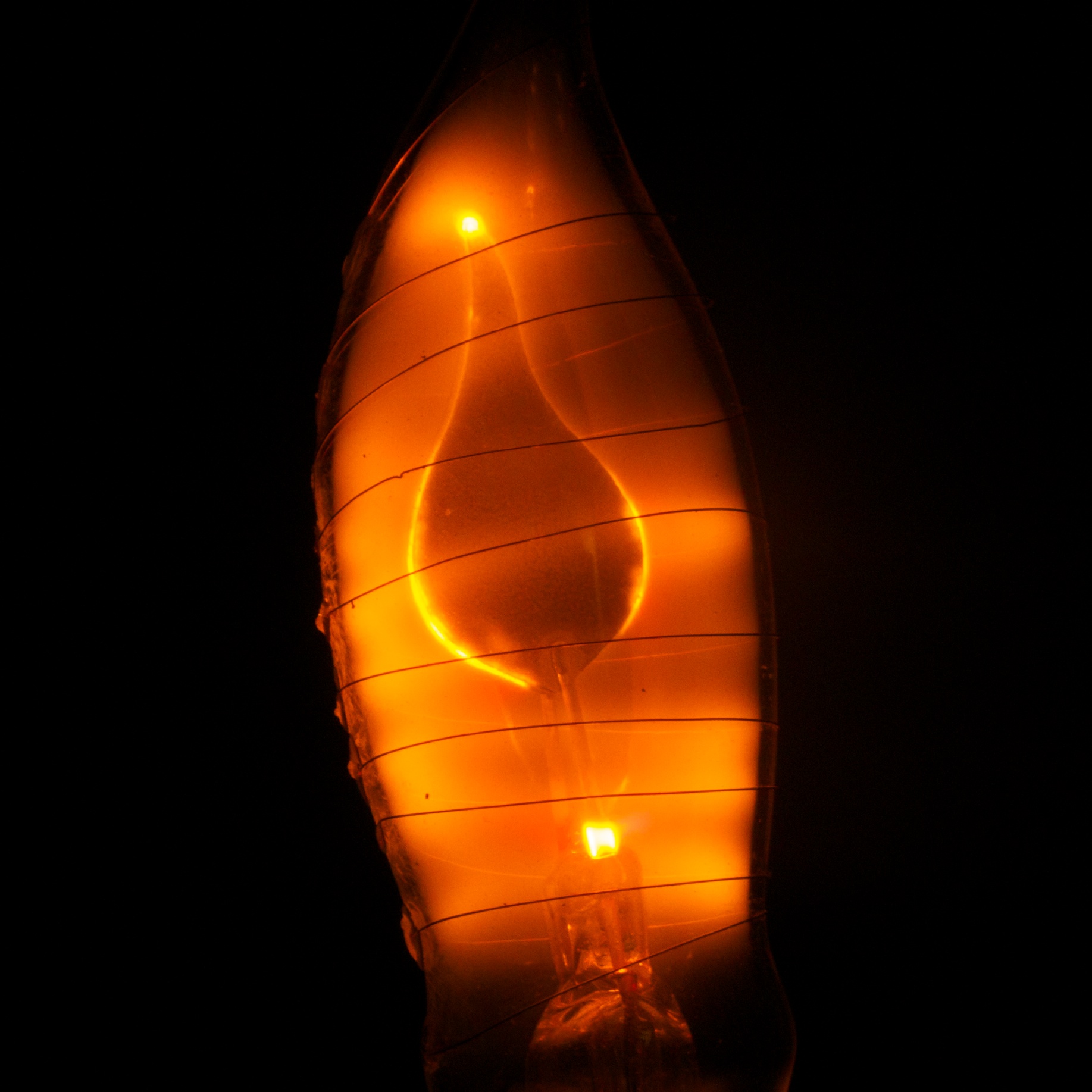
Neon Scope
It’s so hard for me to clean up my office. I’ll see a random collection of objects that I’m supposed to be sorting, putting away, and/or throwing in the garbage.. and I can’t help playing with them instead. This time the objects in question were an old CCFL backlight inverter, a neon flicker-flame bulb, and…
-
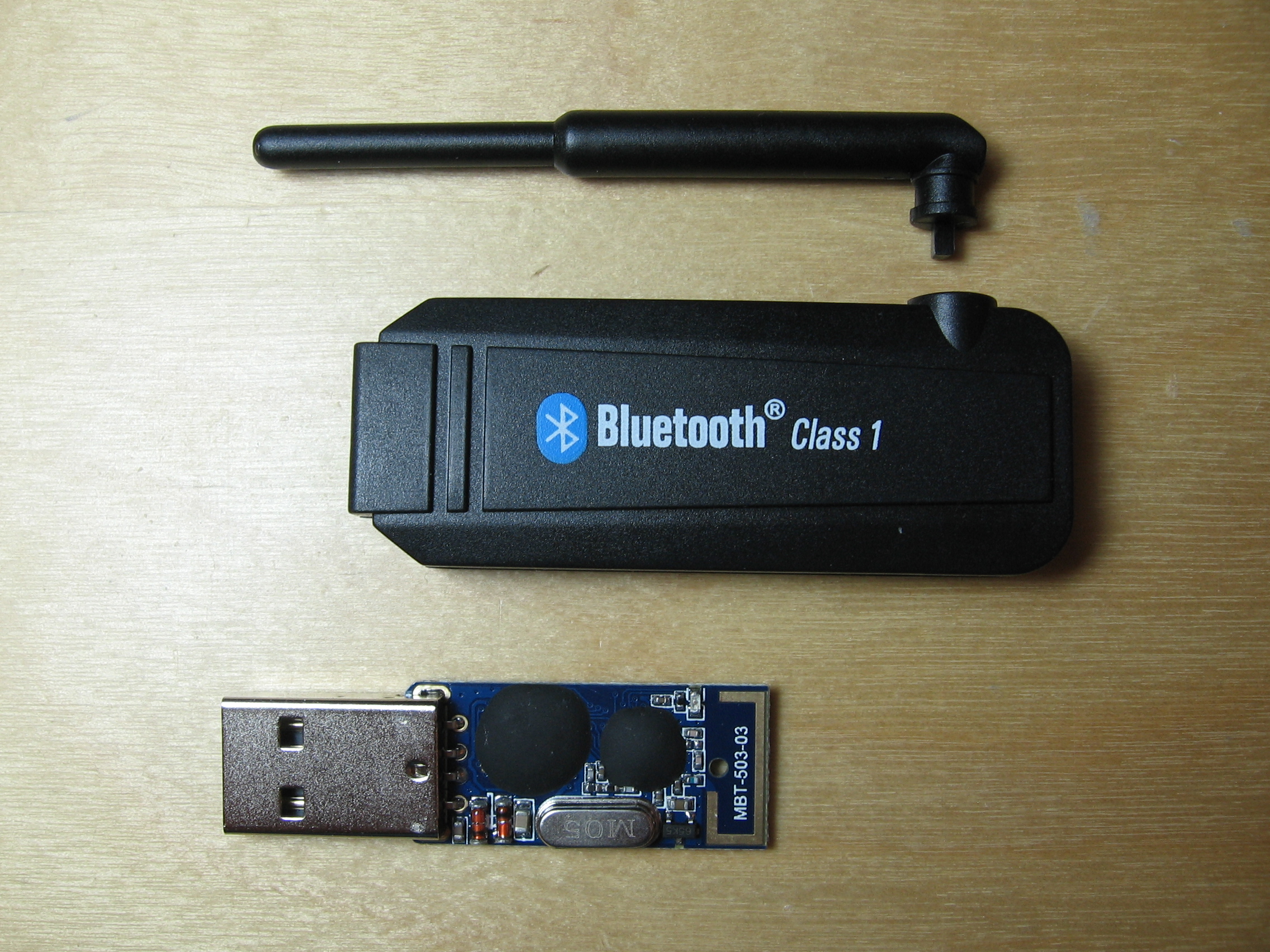
Another Reason to Beware Bargain Basement Bluetooth
I was debugging a Bluetooth-related problem on a Windows 7 machine recently, and I found another great example of why sometimes you get what you pay for, even when buying something as nominally standardized and homogeneous as a Bluetooth adapter. It so happens that this machine was using one of these $5 adapters with the…
-
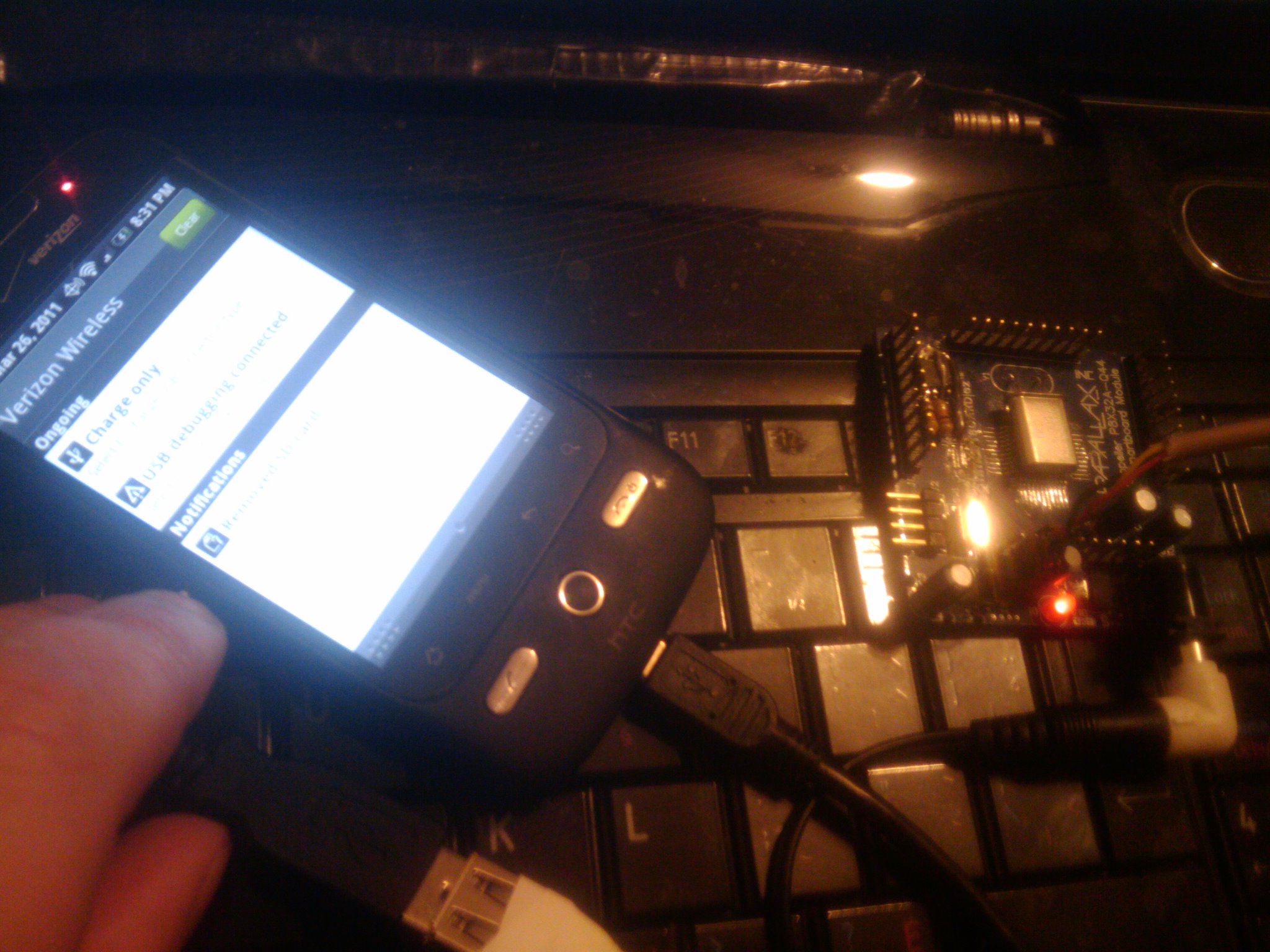
Cheap and easy Android to Propeller bridge
This is a quick plug for a spiffy project that M. K. Borri (spiritplumber) has been building using my usb-fs-host object. He’s connecting an Android phone to a Propeller microcontroller, emulating the ADB debug protocol on the µC, and using this as a communication bridge in order to control robots from the phone. He has…
-

S/PDIF Digital Audio on a Microcontroller
A few years ago, I implemented an S/PDIF encoder object for the Parallax Propeller. When I first wrote this object, I wrote only a very terse blog post on the subject. I rather like the simplicity and effectiveness of this project, so I thought I’d write a more detailed explanation for anyone who’s curious about…
-

Cube64 GameCube to N64 Adaptor
Enjoy retro N64 games, but can’t stand the controller? That’s the situation I found myself in about 7 years ago, back in 2004. So I built an adaptor, to use Game Cube controllers on the N64. (tl;dr… Cube64-DX on Google Code) The adaptor hardware is very simple- all you need is a PIC microcontroller. I…
-
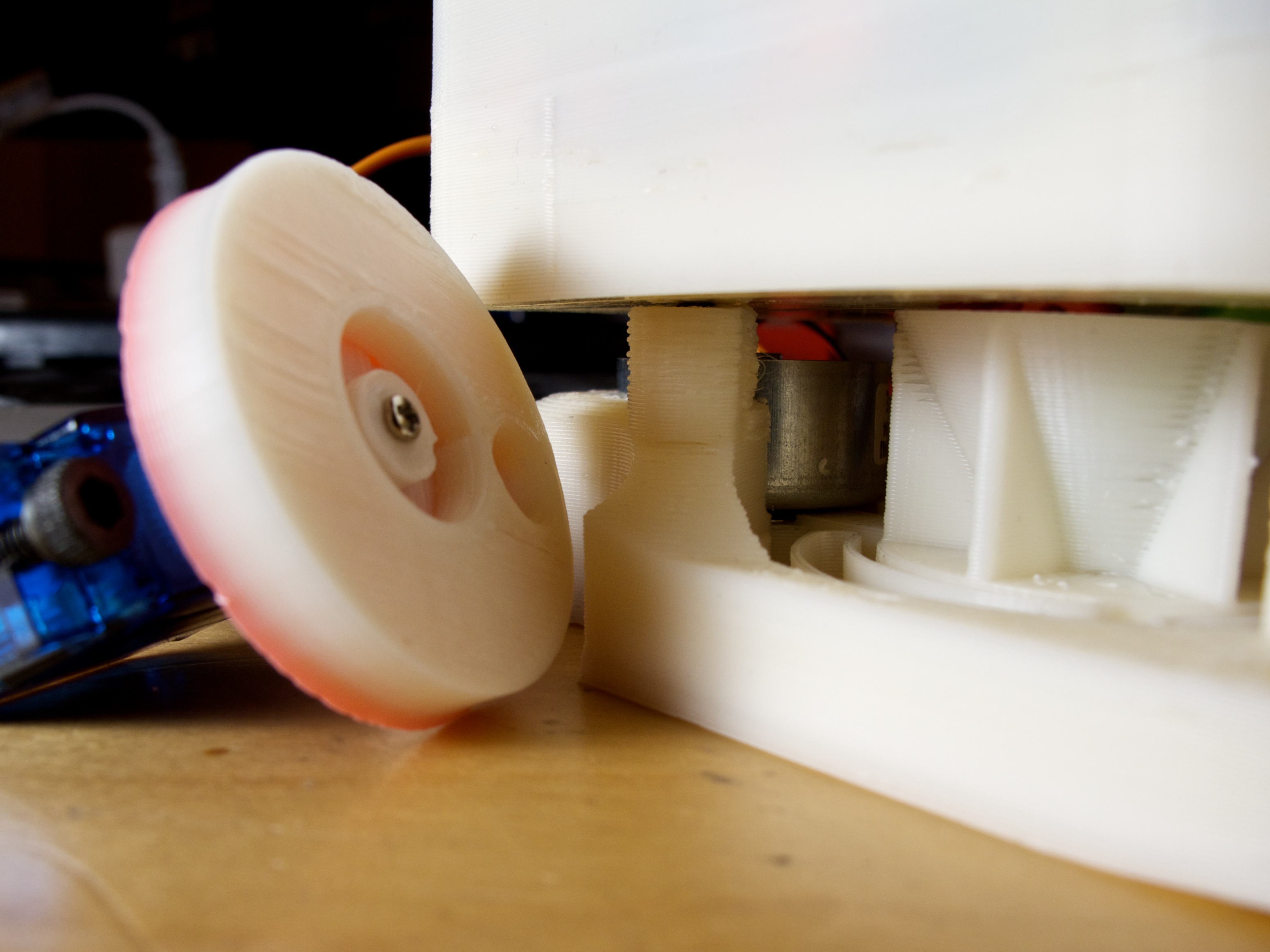
Perler Bead Robot Ideas
This was originally going to be a comment response to Tim’s blog entry, Scanlime’s Perler Bead Hopper Sorting Suggestion: I was looking at Scanlime’s 3D Printed Vibrating Perler Bead Hopper: and I was thinking how best to sort out the different color beads. I thought that if scanlime used one main hopper with the color…
-
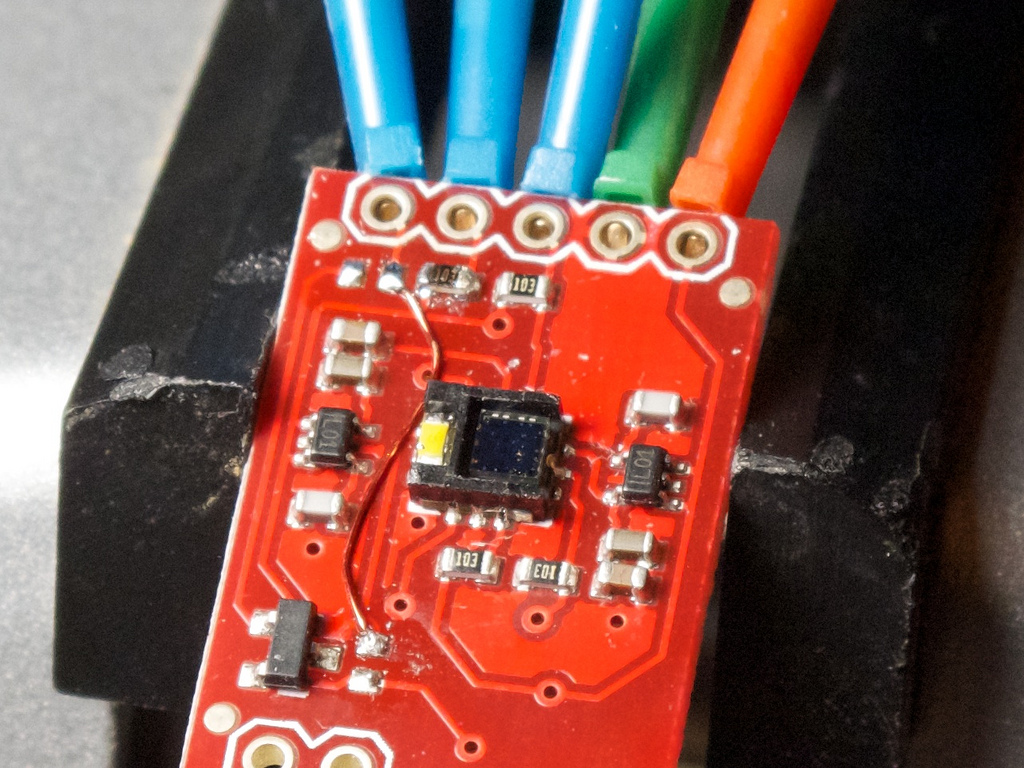
Trying out the Avago ADJD-S371-Q999 Color Sensor
This is another sub-experiment leading up to a project that I’ve only tangentially mentioned on this blog so far: a robot that automatically sorts and places Perler Beads. The robot starts with a pile of unsorted beads, and after it separates them into single beads, it needs a way to accurately sense the color of…
-
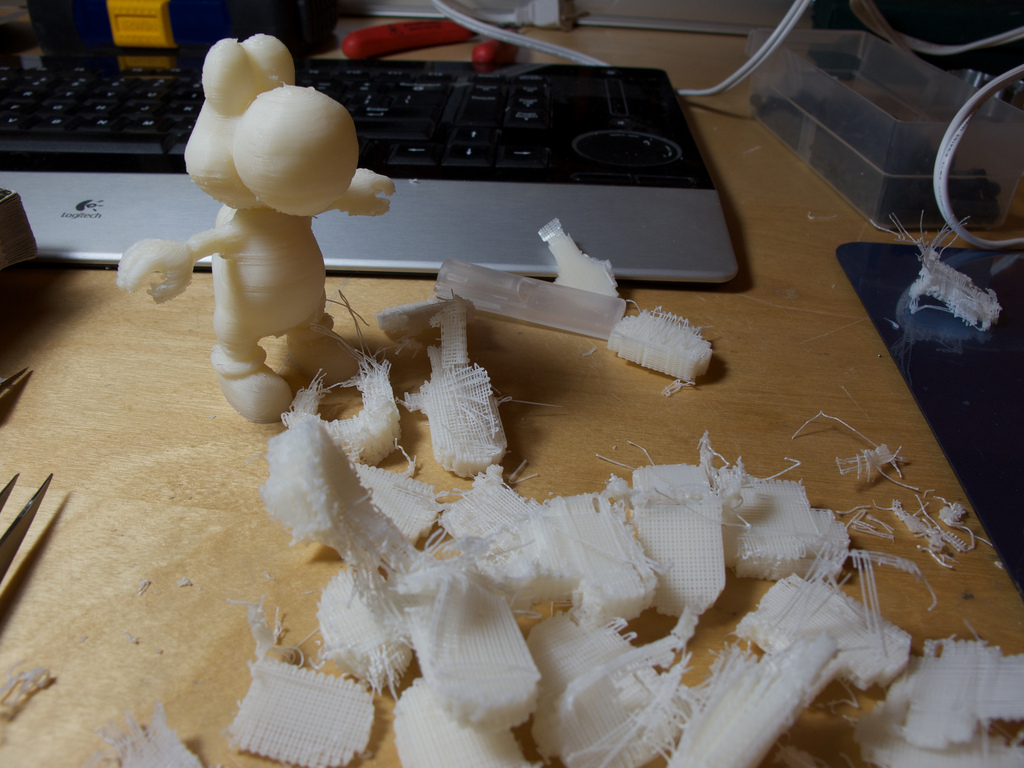
Trying out Skeinforge Support Material
This is a quick photoblog and a video to document my first experience with using the support material options in Skeinforge. This was on my Makerbot Thing-o-Matic with a MakerGear stepper extruder, 0.35mm nozzle, and aluminum/kapton heated build platform. The model I’m printing is Yoshi, the familiar Nintendo character. I cleaned up and subdivided the…
-

MakerBot Protip: Build from SD card without a PC
If you’ve ever wanted to build a model on your MakerBot without a PC attached at all (or perhaps you just never have a USB cable quite long enough to reach…) there’s an easy solution! This is a quick one-line addition to the V2 MakerBot motherboard firmware. With this change, your MakerBot will start up…
-
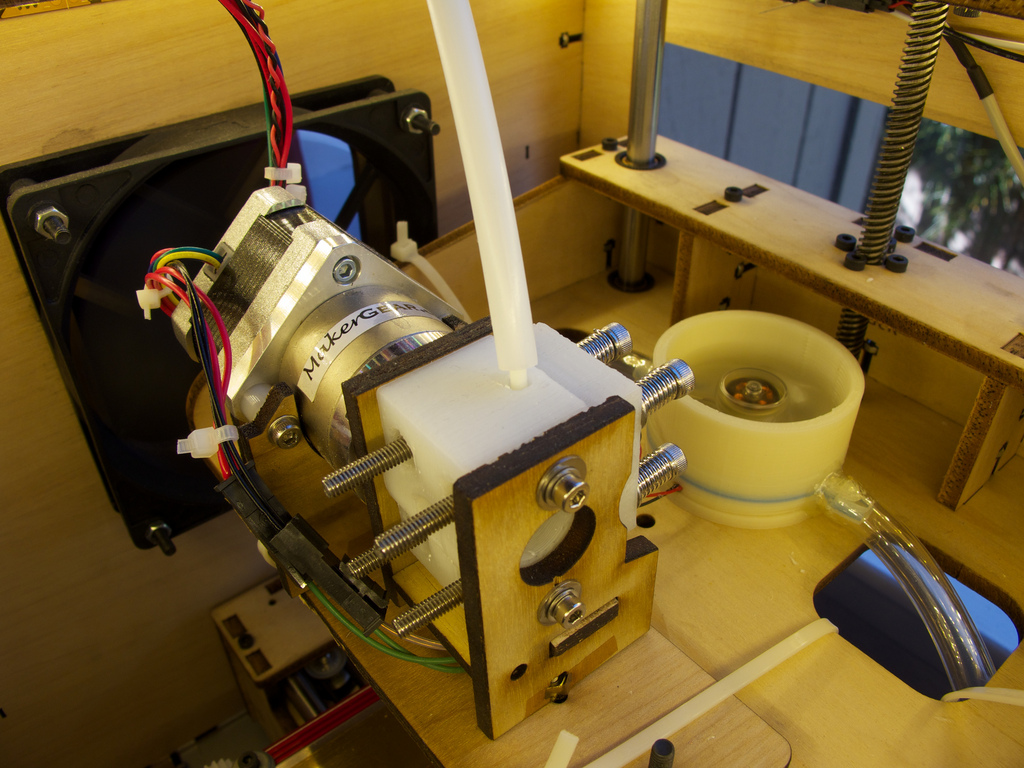
MakerBot Upgrades
A few add-ons for my MakerBot: New build surface, sheet aluminum and hot Kapton. MakerGear Stepper Extruder, currently using the 0.35mm nozzle Running the latest firmware and ReplicatorG from git, with the MK6 Stepper Plastruder support Using the Skeinforge Reversal plugin. Say goodbye, Comb and Oozebane. Printed around-the-nozzle cooling ring (Video on YouTube)
-
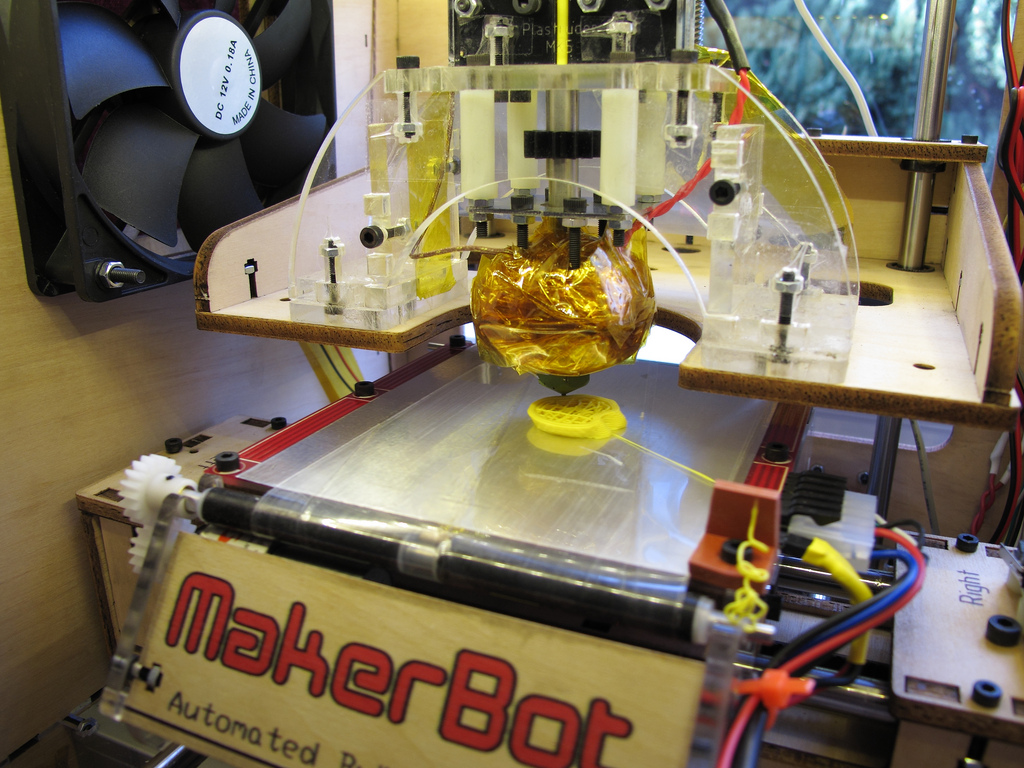
Getting to know the Thing-O-Matic
This post is mostly an apology for not having done anything blog-worthy in the past few months. As usual, life has been full of Things. Like Katamari Damacy. Kinda. On the technical side, I’ve had a few interesting ideas bouncing around in my head lately: 3D Printing. Seems like a space ripe for DIY innovation,…
-
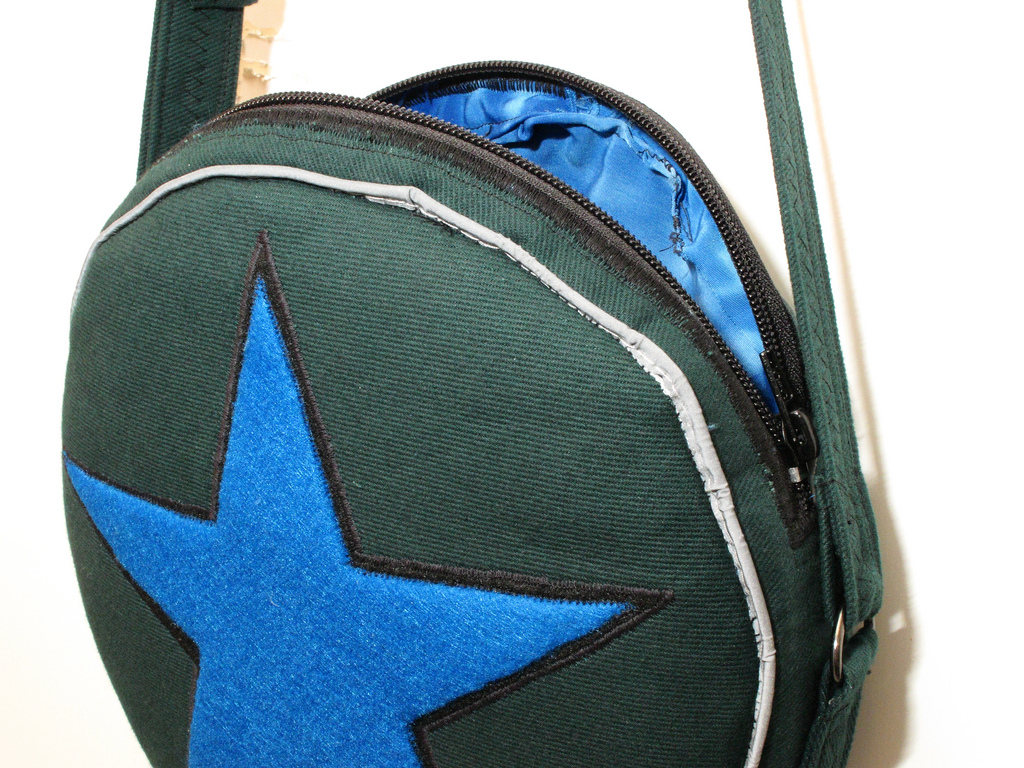
Ramona Flowers subspace purse
I’m pretty new at this, and this was my biggest sewing project so far. The piping around the edges got kind of messed up in places, but overall I’m happy with the results. Front: Two layers of green denim with heavy interfacing Rear and sides: Two layers of green denim with medium interfacing Strap: Three…
-
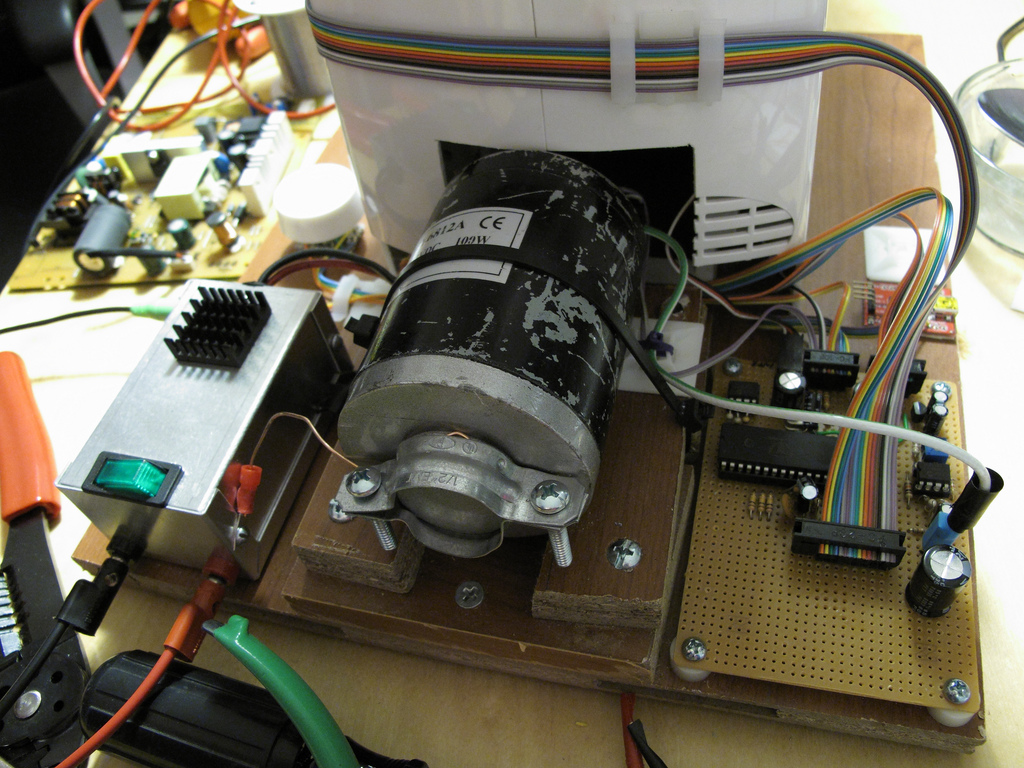
Sewing Machine EMI Woes
I think I got my sewing machine to stop randomly rebooting! (Yes, I am a huge dork…) This isn’t the first time I’ve delt with EMI problems in my hobby projects, but this one actually turned out to be a lot more annoying than the others. This project has no really high-frequency signals, no super-wide…
-
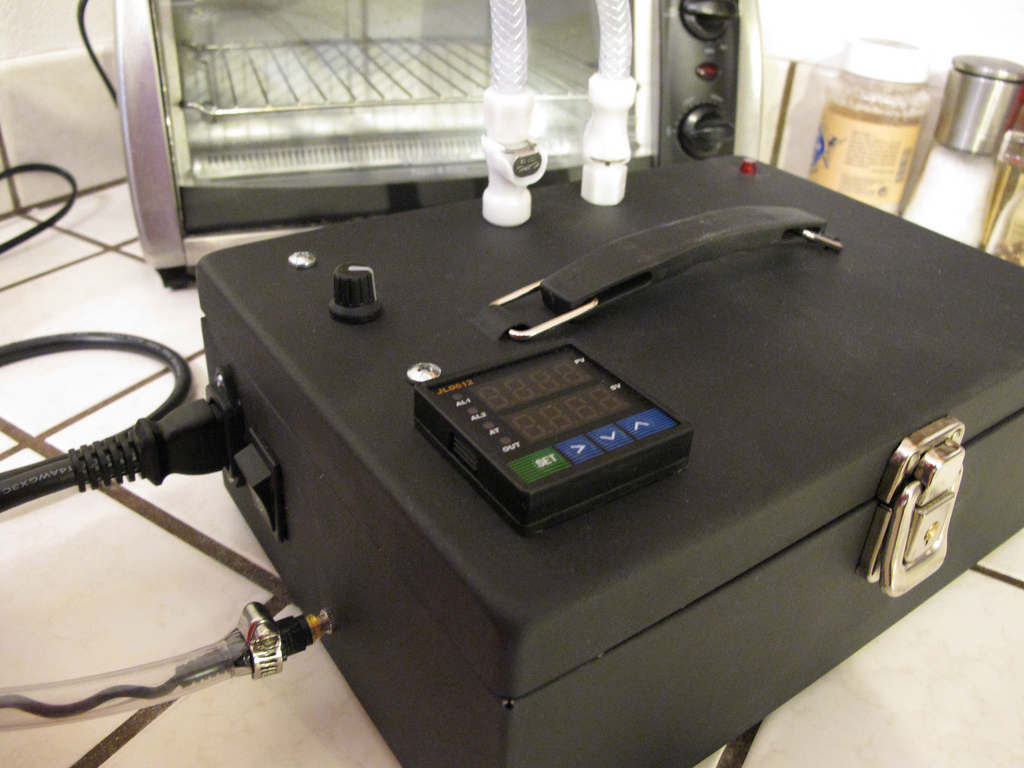
Espresso Machine Sous-vide
This project is a bit different from what I normally do. No firmware to write, just several trips to the hardware store and a lot of quality time with the drill, files, and nibbler. But this one has a higher purpose: Food. It was actually a commission by a friend of mine. He wanted to…
-
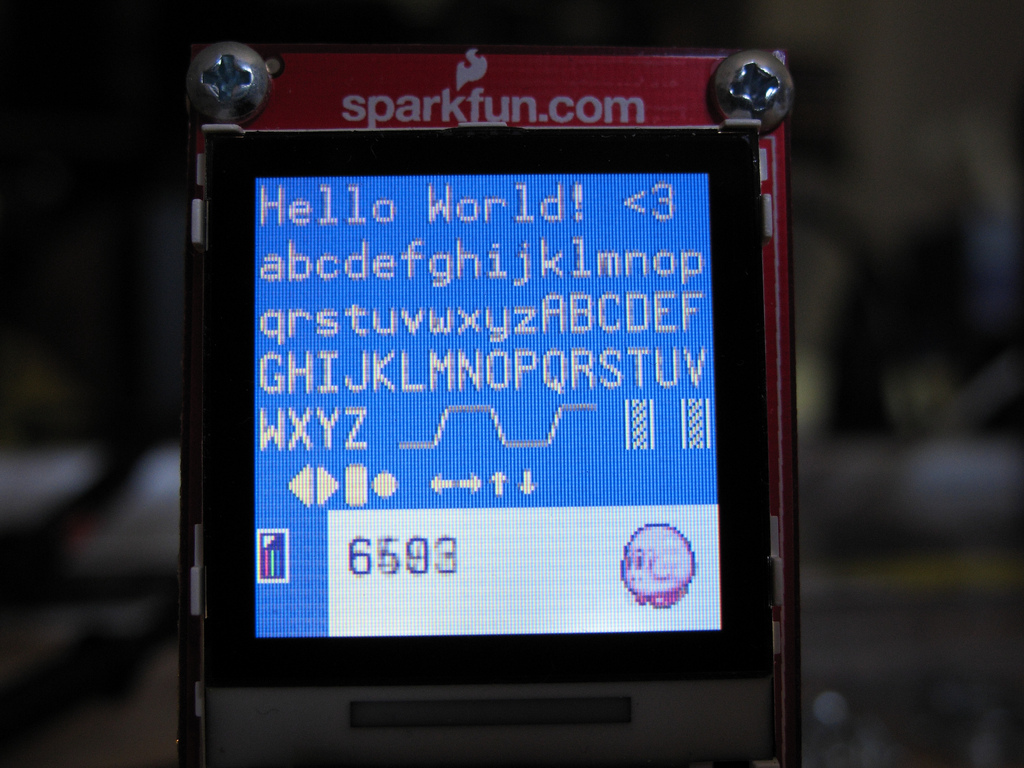
Sewing Machine Update: LCD
I had a rather cute 128×128 Nokia 6100 knockoff LCD that I wanted to use with the project. It’s inexpensive, not a bad quality/price tradeoff, and they’re pretty easy to interface with. Spark Fun already has plenty of drivers on their page for different microcontrollers. But of course, not a Propeller. And after searching through…
-

Propeller Bluetooth Stack Demo
After going months without a lot of time for working on my hobby projects, I finally had a few free days to work on debugging my embedded Bluetooth stack for the Propeller. I got it working well enough to demo a Serial Port Profile device, implemented using only a Propeller Demo Board and a $2…
-
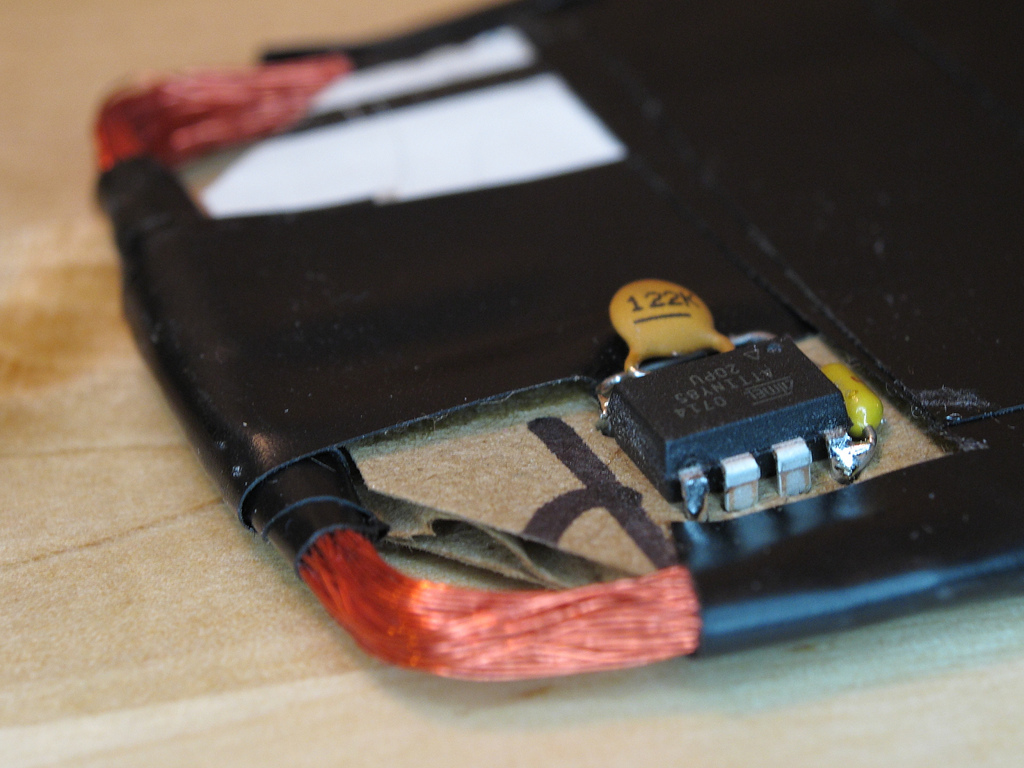
AVRFID 1.1 Firmware
I don’t normally write bloggy posts on every version of every source file I check in, but every so often an older project sees some more activity, and I love the opportunity to revisit software I wrote years ago. Sometimes I wonder why I wrote such-and-such thing that way and oh my god what an…
-
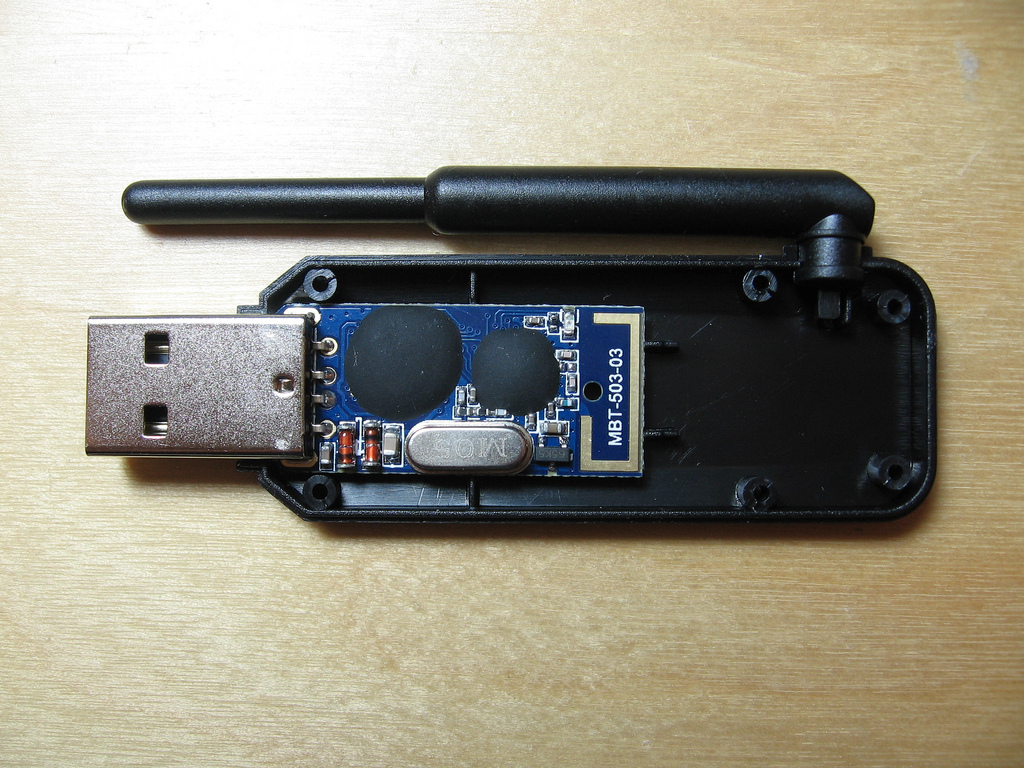
Failed Antenna Design 101
I just got some more Bluetooth dongles in from DealExtreme. This one advertises extended range and EDR support, for $5. The package looks convincing enough, nevermind the engrish: So I cracked it open, naturally. (Hey, I was planning on using it for that crazy project.) And I was shocked to find this:
-
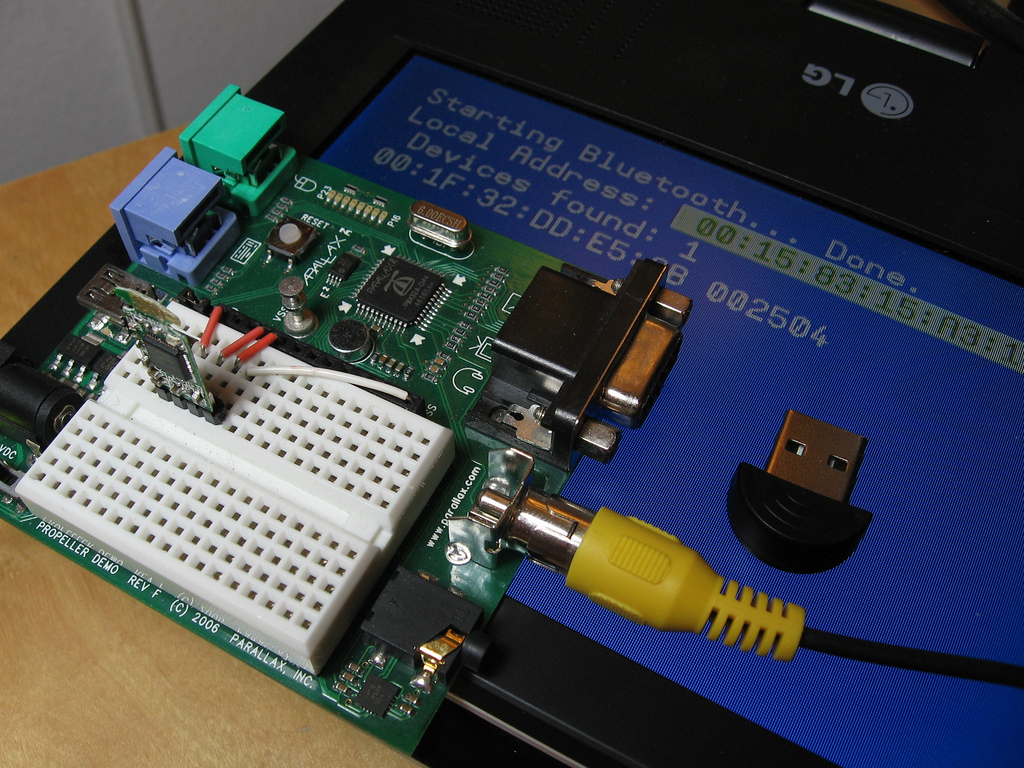
Embedded Bluetooth for $2
This is a continuation of my experiments in bit-banging full-speed USB on the Propeller. I have the basic host controller working reasonably well now, so I started trying to do something a bit more “useful” with it by implementing a simple Bluetooth stack on top of it. Bluetooth and USB are both quite complicated, and…
-
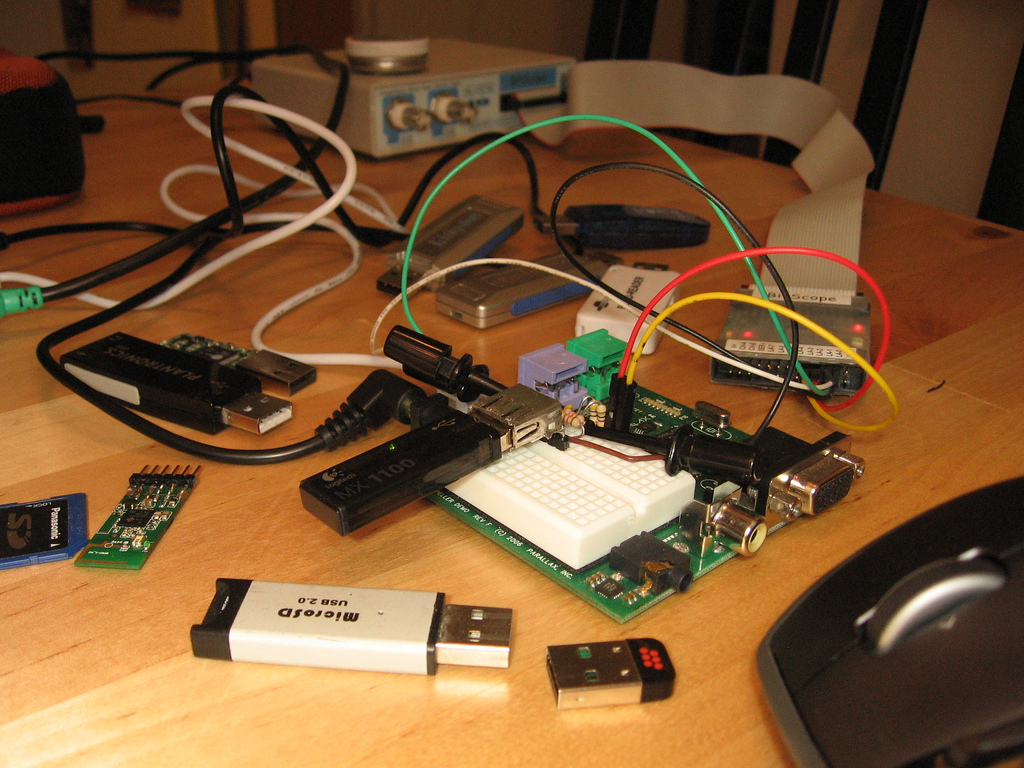
It’s Alive: Bit-banging full-speed USB Host for the Propeller
I’d like to make a more detailed post about this once the project is a bit further along… but for now just a brief description and a couple teaser photos 🙂 This is one of those things that people have said was impossible, and I’ve wanted to try it for a while. I finally found…
-

More laser projector photos
I brought my old hard disk laser projector to work today, since it was the most interesting portable project I had to show off to some friends and new acquaintances at a geek get-together. Scott being himself, he naturally always has a fantastic camera with him. So we got some better pictures of its output:
-
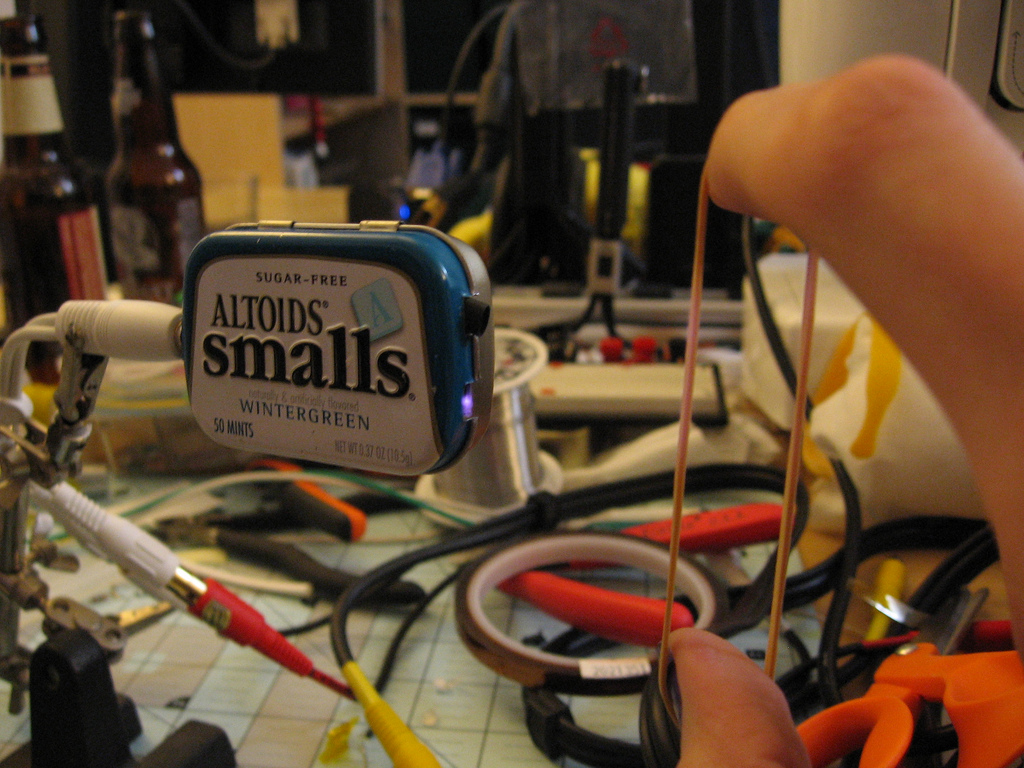
Simple Optical Microphone/Pickup
This is another mini-project that began, like so many have, in a discussion with Scott over some beer. We wanted to build a new kind of speaker amplifier, which used mechanical closed-loop feedback to position the speaker cone exactly where the audio signal says it should be. We figured that, if done right, this could…
-

Hacking a Digital Bathroom Scale
People all around the internet have been doing cool things with the Wii peripherals lately, including the Wii Fit balance board. Things like controlling robots or playing World of Warcraft. But what if you just want one weight sensor, not four? The balance board starts to look kind of pricey, and who wants to deal…
-
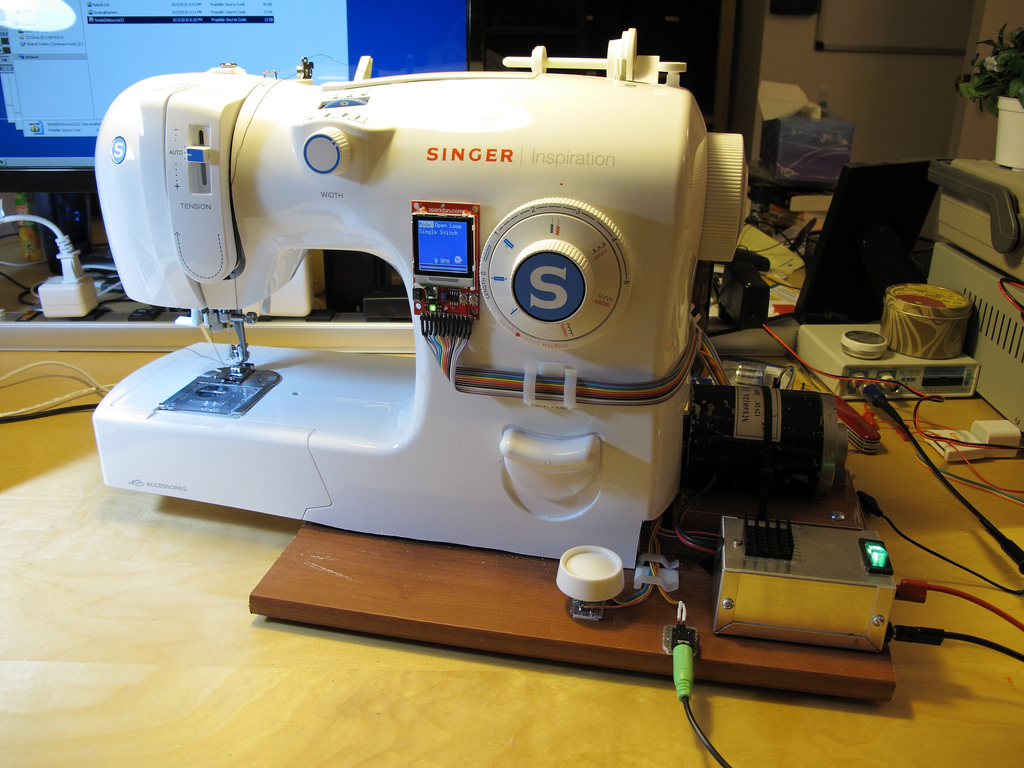
DIY Sewing Machine Retrofit
The story behind this project is a bit overcomplicated. That’s all below, if you’re interested. I made a video to explain the final product: Back Story This all started when I bought a sewing machine for making fabric RFID tags a little over a year ago, and started using it to make cute plushy objects.…
-
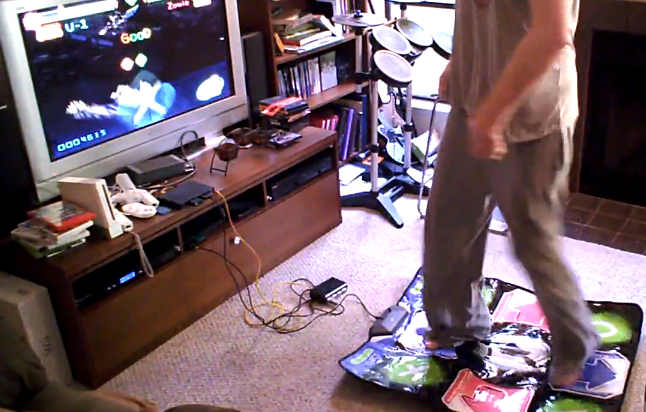
Gitaroo Man + DDR Pad
As much as I like the long, complicated projects that involve weeks of soldering, gluing, coding, tweaking, re-tweaking and debugging, it’s really refreshing to occasionally do something cool with no more than an hour or two of work. This mini-project was my boyfriend’s idea. It’s an experiment in cooperative two-player Gitaroo Man, played using a…
-
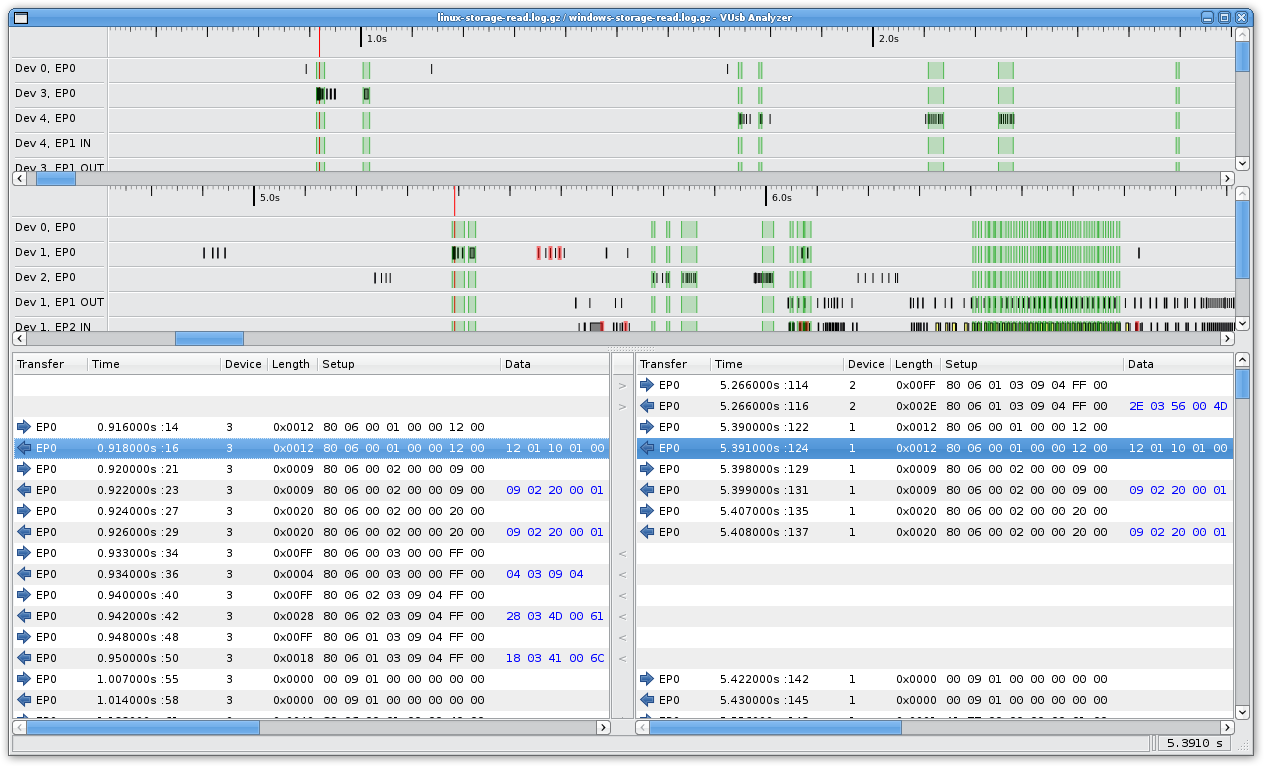
Announcing vusb-analyzer 1.1
The Virtual USB Analyzer is a graphical tool for analyzing USB sniffer logs. It can do some basic protocol decoding, and it has a graphical timeline view which helps to visualize the latency and concurrency characteristics of USB traffic. This release only adds a single feature, but it’s one that many people have probably been…
-
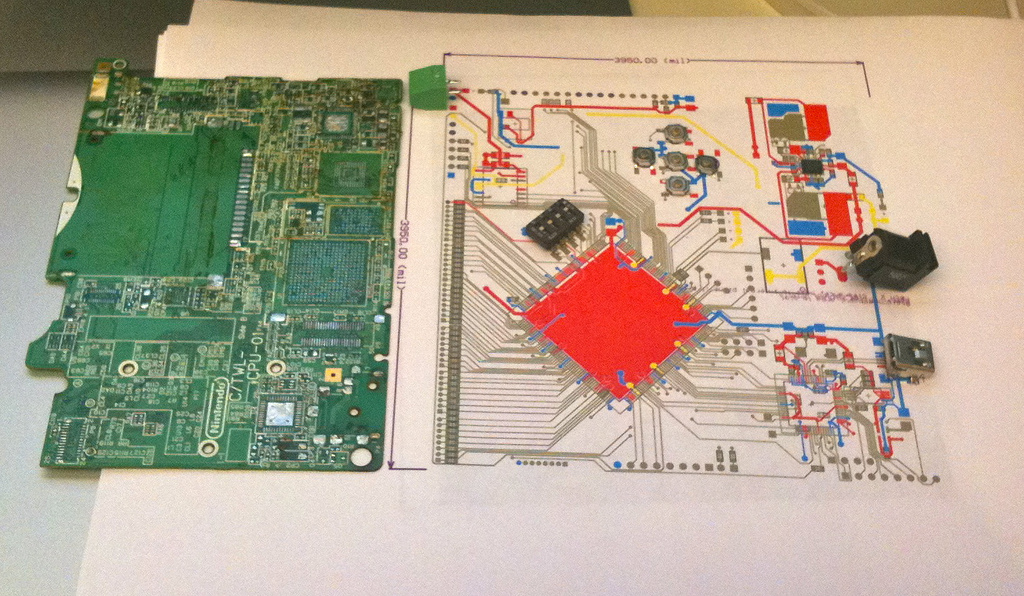
November Update
I guess I don’t have a complete blog entry to write on any one thing.. but there are several unrelated things that I feel like writing down. I recently joined Twitter, but I must suck at using it because none of these things ended up there. Life Tragic. Introspective. Complicated. This isn’t really a place where…
-
Lipo Woes
I was hoping to dust off my Blade CX2 this afternoon and get some flying in. It’s been many months since I’ve flown, and that’s really a shame. So I take my two 800 mA 2S packs out of the liposack in the garage, and they’re both pretty swollen. One of them is still at…
-
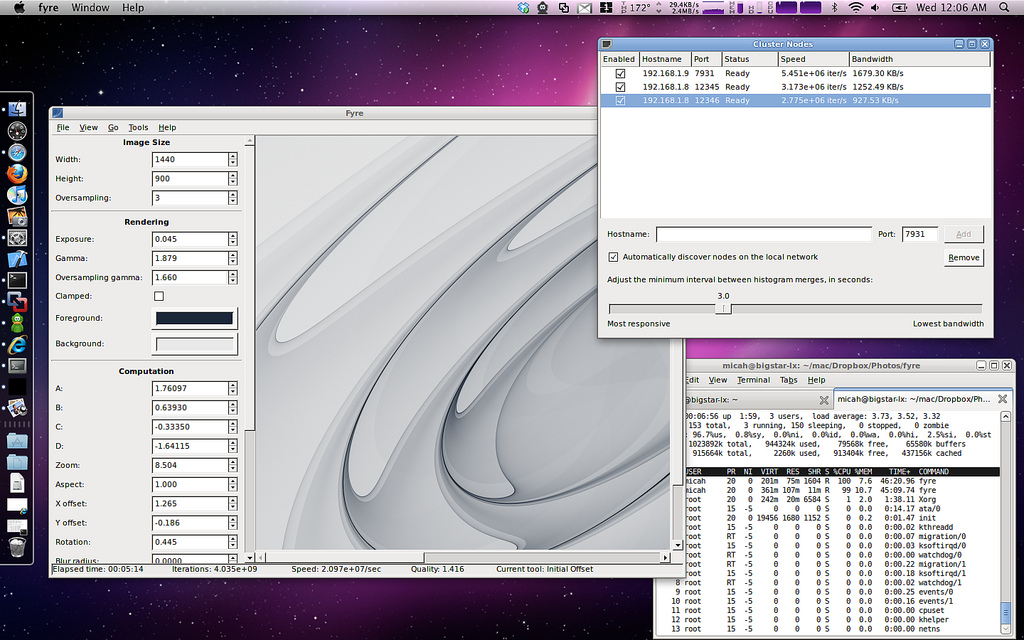
New MacBook Pro + Fyre
Back when I bought my last Mac: USB and the Playstation 2 were new, Altivec and shiny plastic were in, and fans were almost starting to line up for the first Harry Potter movie. Oh, and warrantless wiretapping was still illegal. So, Apple, I guess it’s time to put all those hardware failures behind us…
-

Graphics in VMware Fusion 3 and Workstation 7
I work on the graphics virtualization team at VMware. The company is about to release two new desktop virtualization products: Fusion 3.0 is in beta, with a release coming tomorrow. Workstation 7.0 has a public release candidate available. There are a lot of exciting features in these releases, and my team has been working really…
-

Temporal Hex Dump
After building some hardware to trace and inject data on the Nintendo DSi’s RAM bus, it became obvious pretty fast that there’s a lot of data there, and (as far as I know) no good tools for analyzing these sorts of logs. The RAM tracer has already given us a lot of insight into how…
-
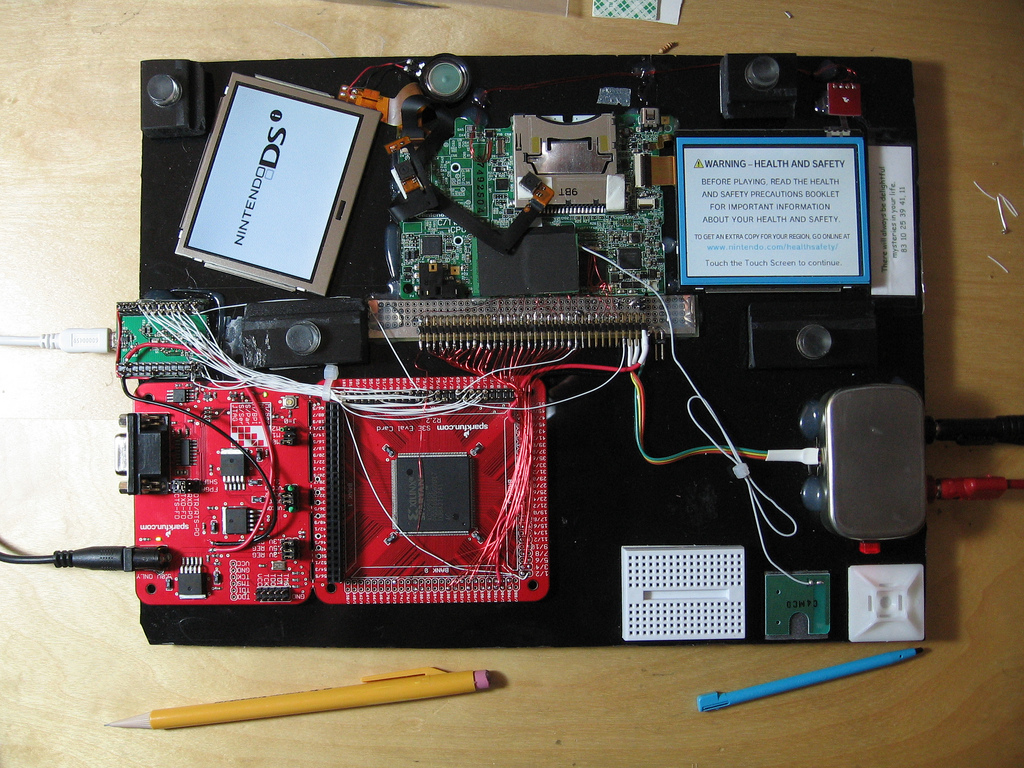
DSi RAM tracing
It seems like a lot of people have been seeing my Flickr photostream and wondering what I must be up to- especially after my photos got linked on hackaday and reddit. Well, I’ve been meaning to write a detailed blog post explaining it all- but I keep running out of time. So I guess a…
-
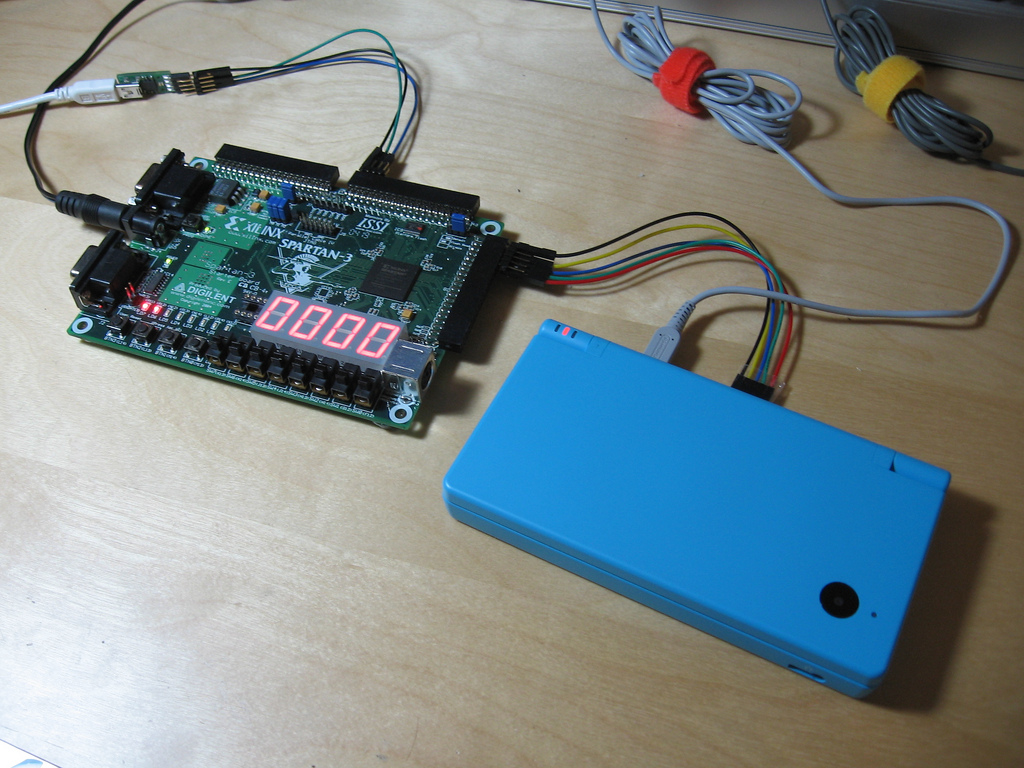
Fun with FPGAs: SPI EEPROM emulator
I found a fun excuse to practice my digital logic design over the past few days: This is an FPGA emulating the SPI EEPROM (save game memory) in a modified Nintendo DS game cartridge. The emulated EEPROM is backed by 1 MB of SRAM, and there is a USB interface that you can use to…
-
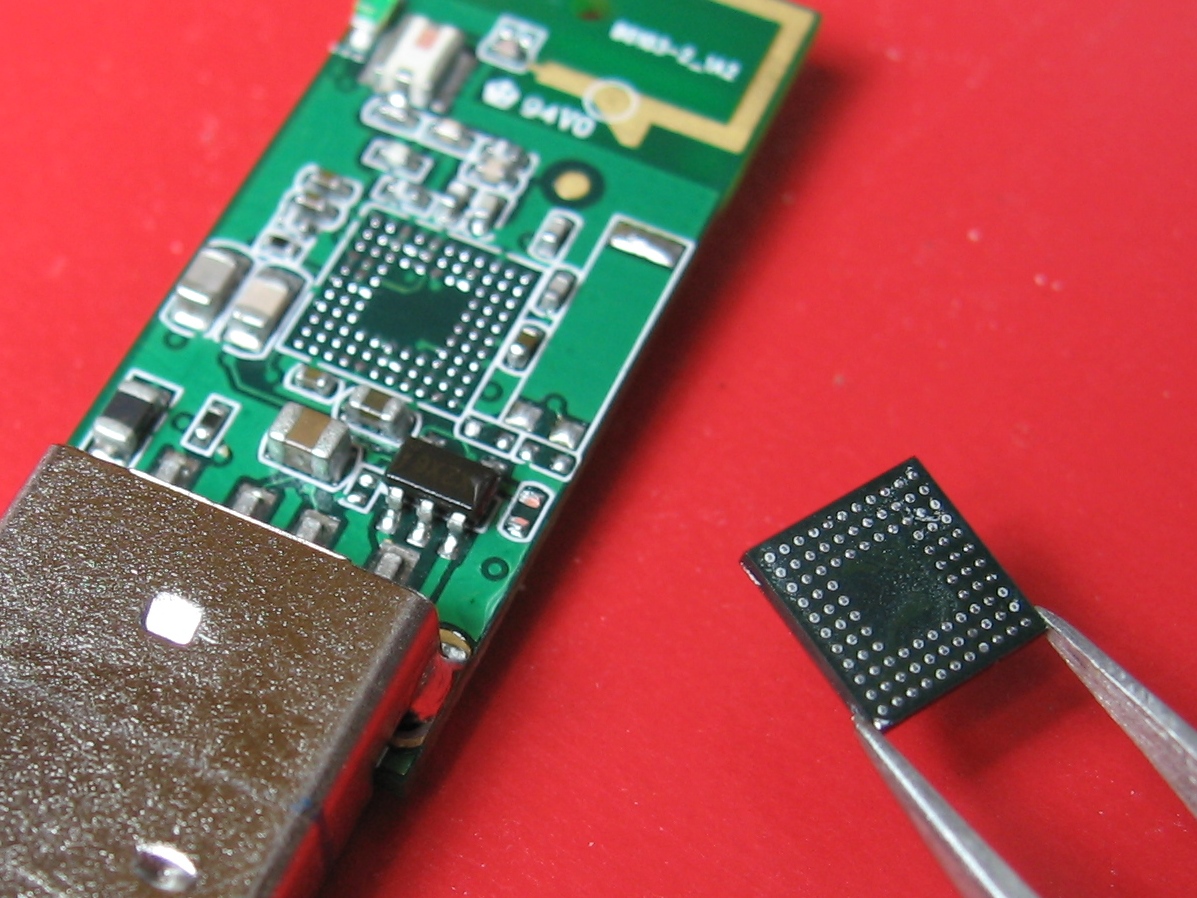
DSi hacking, BGA rework
I got a Nintendo DSi earlier this month. It’s a really cute little console, and a nice revision to the DS Lite. Screens are slightly larger, CPU is about twice as fast, 4x the RAM. And of course it has these camera thingies. Other folks have teardowns online with internal photos aplenty 🙂 So, I…
-
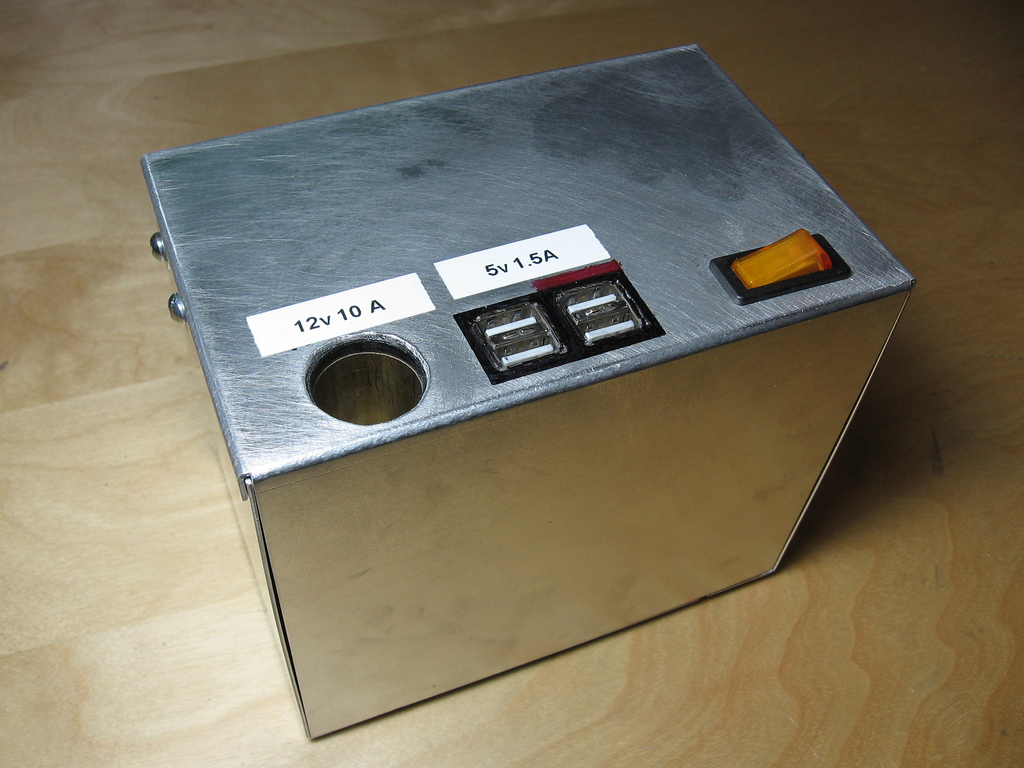
“Luggable” power pack
Paul and I are leaving on a cross-country train trip next week, for Jen and Shawn’s wedding in Colorado. I’m sure the view will be great, and I’m bringing a handful of books- but Paul and I are geeks and we need our electro-doodads. If only we had a way to run our Nintendo DS…
-

Turbulence
For anyone who hasn’t already seen it, Linus Akesson (of Craft fame) just released his first demo for the Parallax Propeller: Turbulence. You can watch the high resolution video on capped.tv, with an introduction by Linus himself. Or, if you have a Propeller board, he’s provided binaries and source code. The demo is quite impressive,…
-

Robot Odyssey DS: First screenshots
This is nowhere near ready for prime-time, but: Yep, it’s Robot Odyssey for the Nintendo DS. I literally just got this working yesterday, so please don’t ask for any precompiled binaries. If you don’t already know where the source code is, you really don’t want to see it 🙂 Before you ask, this is not…
-
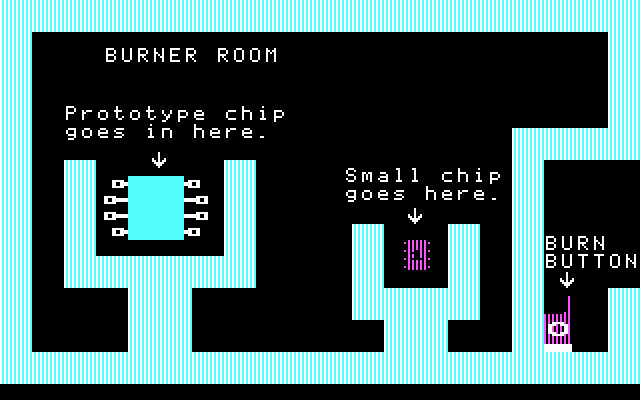
Robot Odyssey Chip Disassembler
I’ve been spending more time hacking on Robot Odyssesy lately. Most of it has had a specific purpose… I’ll write a separate blog post on that project once it’s a bit more fully baked. In the mean time, the reverse engineering has had some useful side-effects. Chip Simulation If you haven’t heard of Robot Odyssey,…
-
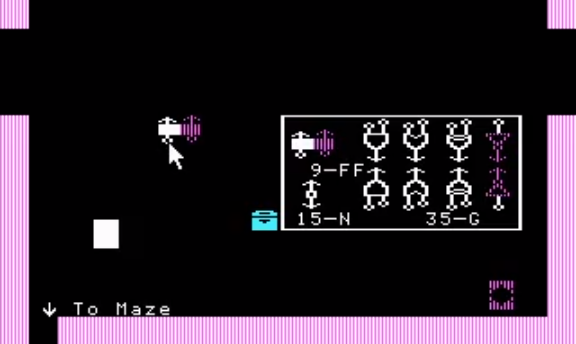
Robot Odyssey Mouse Hack 1
Yesterday I spent some more time reverse engineering Robot Odyssey. This was a great game, and it’s kind of a nostalgic pleasure for me to read and figure out all of this old 16-bit assembly. So far I’ve reverse engineered nearly all of the drawing code, big chunks of the world file format, and most…
-

Robot Odyssey: 4-way low latency flip flop
Robot odyssey rocks. Also, I didn’t realize that you could upload a video captured with VMware Workstation directly to Youtube. It’s pretty neat that they support our video codec. Here’s a video of a chip I was just designing, a low-latency 4-way flip flop.
-

A Binary Patch for Robot Odyssey
Robot Odyssey is one of the games that I have the fondest childhood memories of. It’s both a high-quality educational game, and a gentle (but very challenging) introduction to digital logic. There’s a Wikipedia article on the game. There’s also DroidQuest which is a Java-based clone of Robot Odyssey. The DroidQuest site also contains some…
-
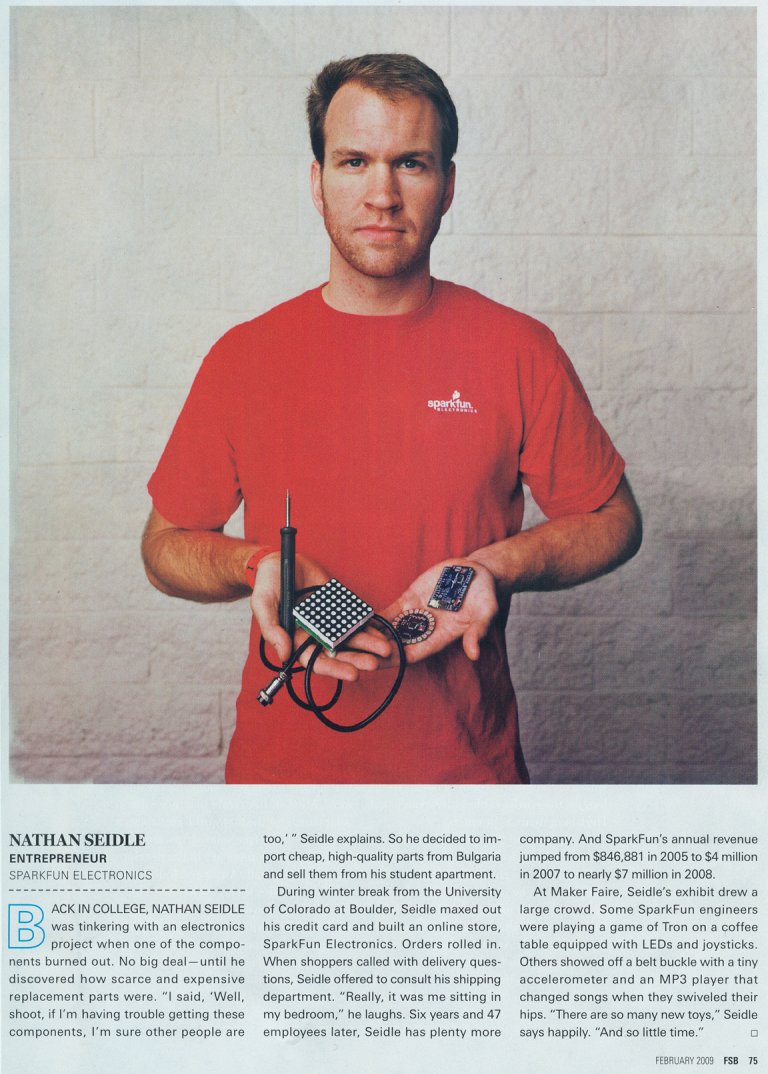
Spark Fun in Fortune magazine
Spark Fun Electronics is awesome. If you’re an electronics hobbyist who hasn’t heard of them, you’re missing out. While us hobbyists have long been able to get a huge variety of “reasonably” priced staple components from Digi-key, and crazy-cheap surplus components from places like All Electronics Corp. and B.G. Micro, I couldn’t help feeling like…
-
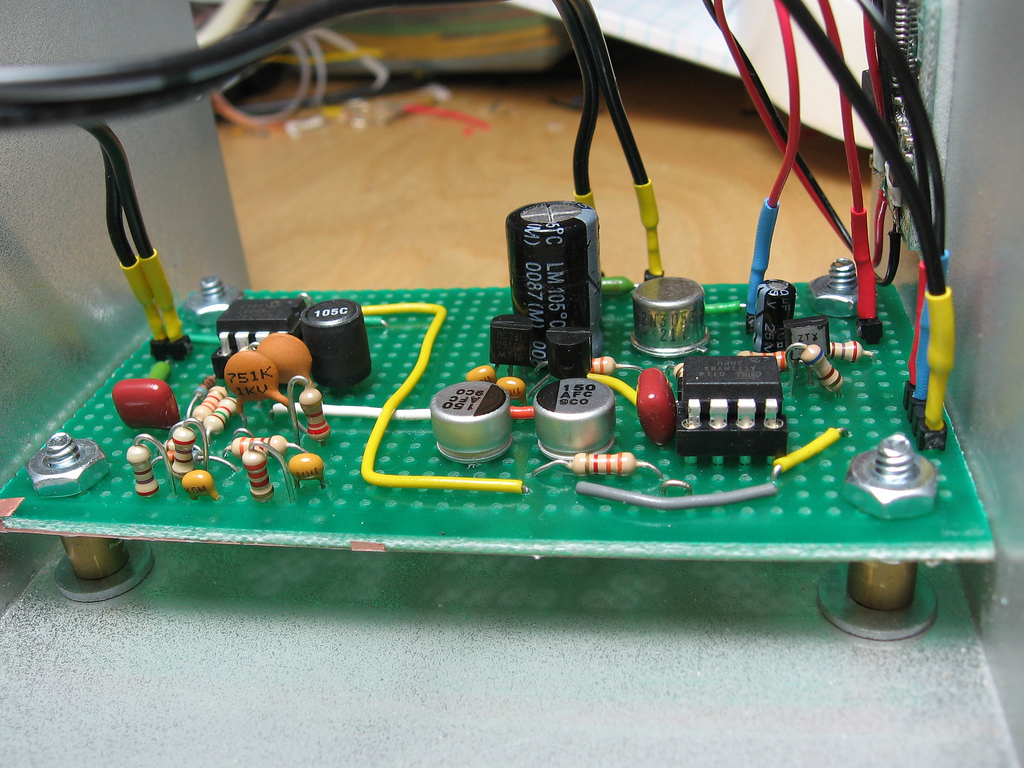
Open source extra-sensitive high resolution TED receiver
Previously on the bloggy blog, I posted a few of my projects related to home data acquisition and to The Energy Detective (TED), a whole-house power measurement device. I made a set of homebrew wireless temperature sensors that display graphs on a digital picture frame, I reverse engineered the TED protocol, built a small self-contained…
-

Virtual USB Analyzer
From late 2005 to early 2007, I worked on the USB virtualization stack at VMware. We ran into all sorts of gnarly bugs, many of which were very hard to reproduce or which required access to esoteric or expensive hardware. To help with debugging problems both internally and with customers in the field, we added…
-

GPU Virtualization at WIOV ’08
I just got back from the first USENIX Workshop on I/O Virtualization. WIOV was an interesting workshop. It was really nice to see what I/O virtualization looks like from a wide range of different viewpoints. There was some good industry perspective from AMD, Intel, Microsoft, and Oracle. There were also a wide range of academic…
-
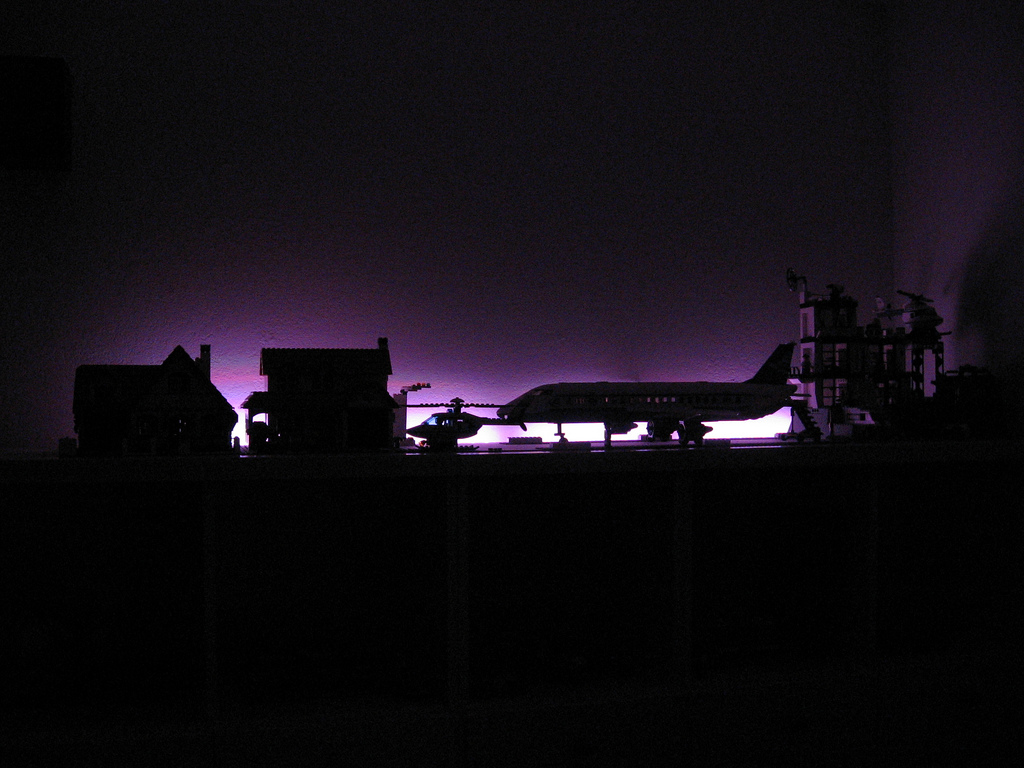
Lego Sky
Over the weekend, I had a chance to finish up a project that I started (and immediately became distracted from) several weeks ago. In our house, Paul and I have a game room. This is where the video games live, as well as other assorted geekery. We have Magic cards, D&D books, some manga.. it’s…
-
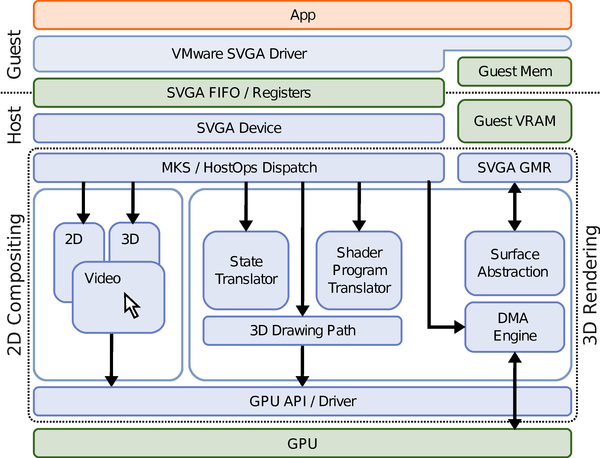
Speaking at USENIX WIOV 2008
Well, this Monday I submitted the final copy of my paper, and yesterday everything was approved. Jeremy Sugerman and I wrote a paper for the USENIX Workshop on I/O Virtualization’s Industrial Practice session: GPU Virtualization on VMware’s Hosted I/O Architecture. We’re on the program for a 15-minute talk at the workshop in San Diego this…
-
Moral dilemma…
Lately I’ve been interested in e-textiles and fabric sensor technology. For an example of something I find infinitely fascinating, take a look at this DIY fabric bend sensor. (Via talk2myshirt, the best named blog evar.) In that project, many of the conductive textile materials were originally designed (or at least marketed) for electrostatic/electromagnetic shielding applications.…
-

Soft RFID tags and cuddly plushies
This week a new power tool arrived on my desk: How did this happen? It was actually kind of complicated… Months ago, Scott and I dreamed of an automated kegerator. For the workplace, naturally. We’d need some way to hand out credits that coworkers could use in order to dispense beer, so we’d need a…
-
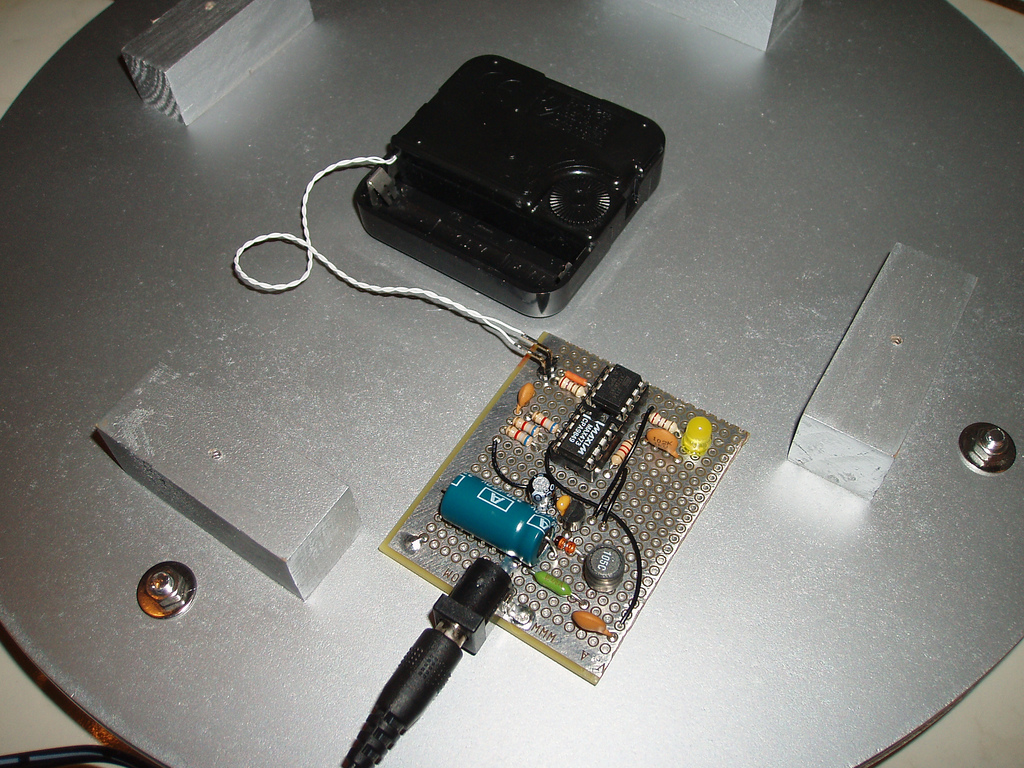
The Kilowatt Clock
I thought I’d try putting together a YouTube video to show my latest crazy project. As usual, the schematic (navi-misc/tedrx/hardware/kwclock-v1-schematic.png) and firmware (navi-misc/tedrx/firmware/kwclock/main.c) is in Subversion.
-
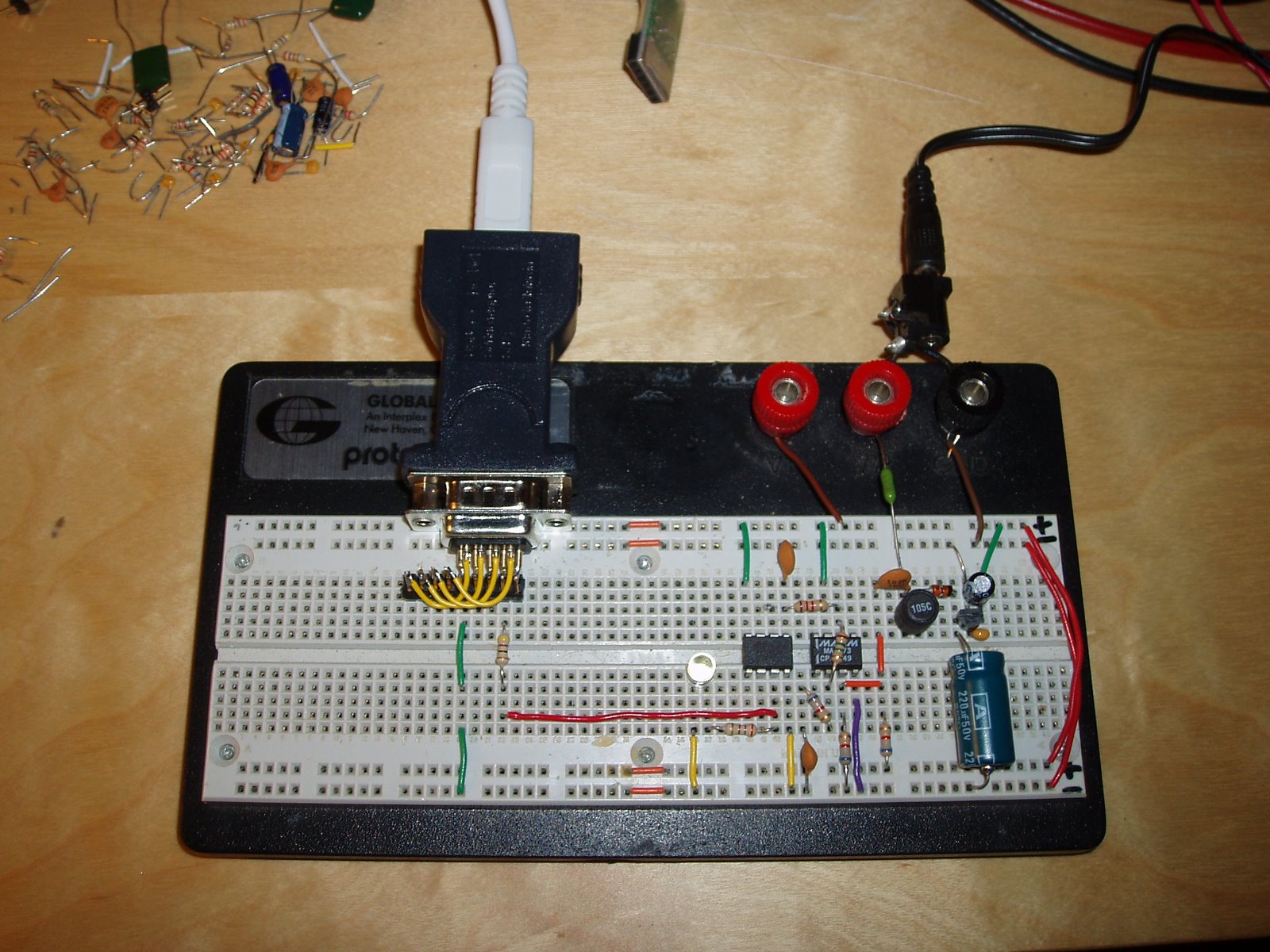
Self-contained TED receiver
My previous entry introduced a homebrew receiver for the powerline-based data protocol used by The Energy Detective. I just designed a second revision of that receiver. This one is self-contained: It gets power and modulated data from a 9V AC wall-wart transformer, and decoded data leaves via an RS-232 serial port at 9600 baud. Best…
-
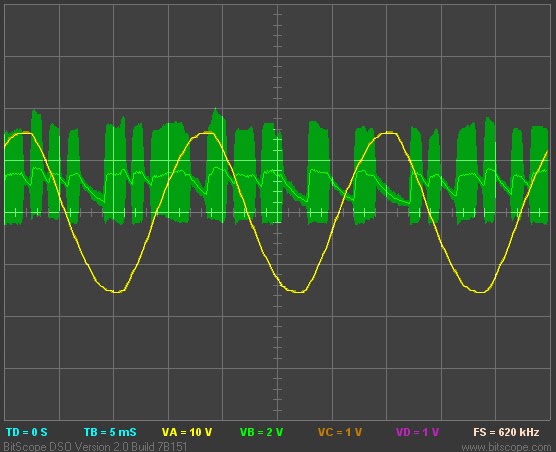
Interfacing with The Energy Detective
I recently bought The Energy Detective (TED), a pretty inexpensive and friendly way to keep tabs on your whole house’s electricity usage. It’s a lot like having a more featureful version of your utility company’s power meter, sitting on your kitchen counter. It can estimate your utility bill, and tell you how much electricity and…
-

Using an AVR as an RFID tag
Experiments in RFID, continued… Last time, I posted an ultra-simple “from scratch” RFID reader, which uses no application-specific components: just a Propeller microcontroller and a few passive components. This time, I tried the opposite: building an RFID tag using no application-specific parts. Well, my solution is full of dirty tricks, but the results aren’t half…
-
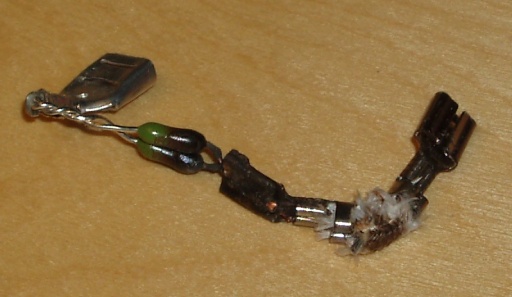
Mmm, crispy.
I hate power electronics. This was my first attempt at fixing a broken Cuisinart cordless kettle. The original symptoms: I notice the kettle occasionally turns itself off. If I turn it back on, it works again for a little while. This kept up for a day or so, then it refused to turn on at…
-

Measuring energy usage
Lately I’ve been interested in measuring whole-house power consumption. I’d like to know where my electric bill is going, how often I forget to turn the lights off, how much the CFL bulbs are actually helping, etc. Besides, I really like measuring things in real-time and displaying them in interesting ways 😉 So, I’ve been…
-
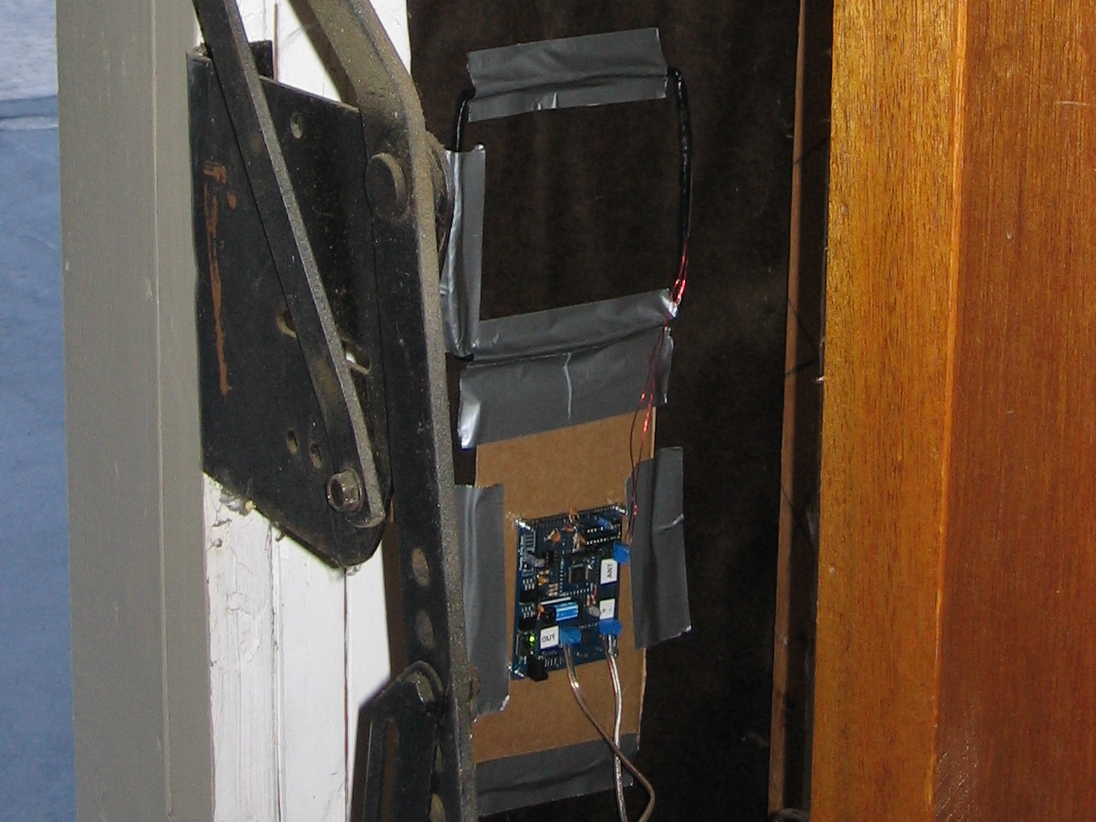
RFID Garage Door Opener
Today I finished a major update to my software-only RFID decoder for the Propeller microcontroller, and I finally installed my prototype in the garage. Now I can open the garage door with my RFID badge from work, while I’m on foot or on my bike 🙂 I’ll post some pictures once there’s some sunlight.
-
The future of computer education
I just stumbled upon a web site which still sells the Elenco Micro-Master MM-8000 Computer Training Kit, a state-of-the-art piece of educational hardware which includes an 8085 processor, 256 bytes of RAM, and a convenient set of keyswitches and LEDs for entering programs and inspecting memory. I remember seeing these in magazines like Electronics Now…
-
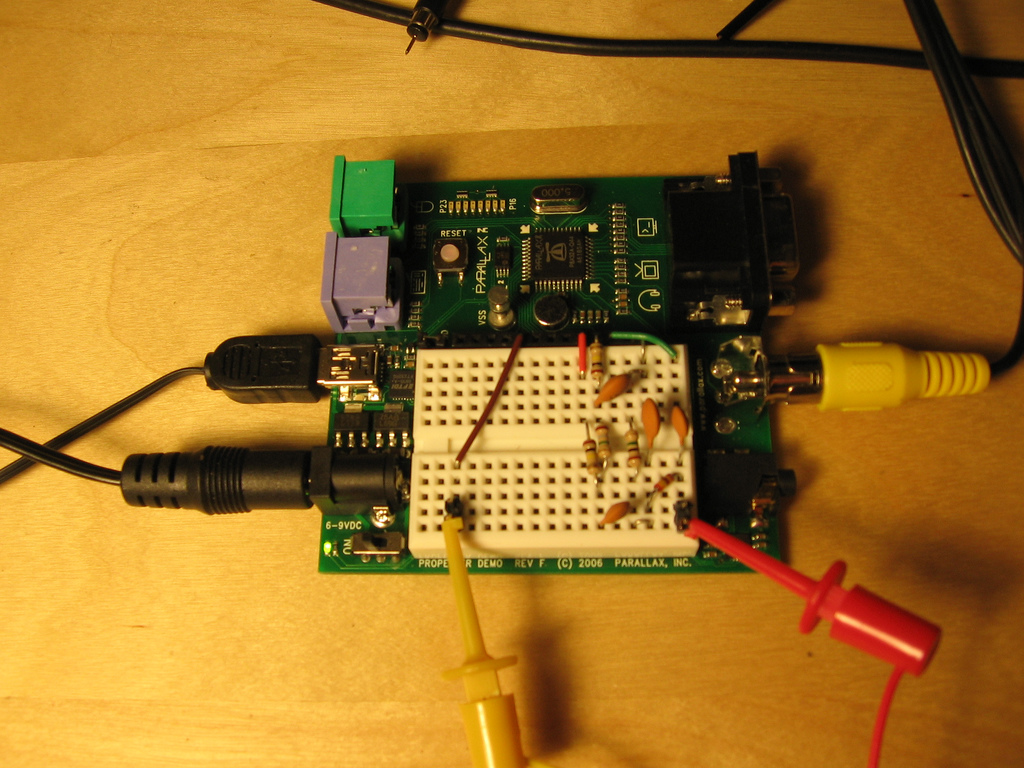
Simplest RFID reader?
That’s a Propeller microcontroller board with a few resistors and capacitors on it. Just add a coil of wire, and you have an RFID reader. Here’s a picture of it scanning my corporate ID badge, and displaying the badge’s 512 bits of content on a portable TV screen: If you’re into that sort of thing,…
-

New oscilloscope!
For a while now, I’ve been looking for a replacement for my ancient 50 MHz Hitachi analog scope. This scope has served me well for the 10+ years I’ve owned it, but it’s kind of a junker. Slow, out of calibration, flaky triggers… I’d could probably get a similar scope for about $15 on eBay.…
-

Propeller chip + SPDIF = ???
So, kind of on a random whim, I decided to build a software SPDIF encoder for the Propeller chip. It was an interesting challenge, and the results are pretty cool, but now I have no idea what do do with it. Not an uncommon problem for me, I guess… Maybe I’ll give my Propeller board…
-
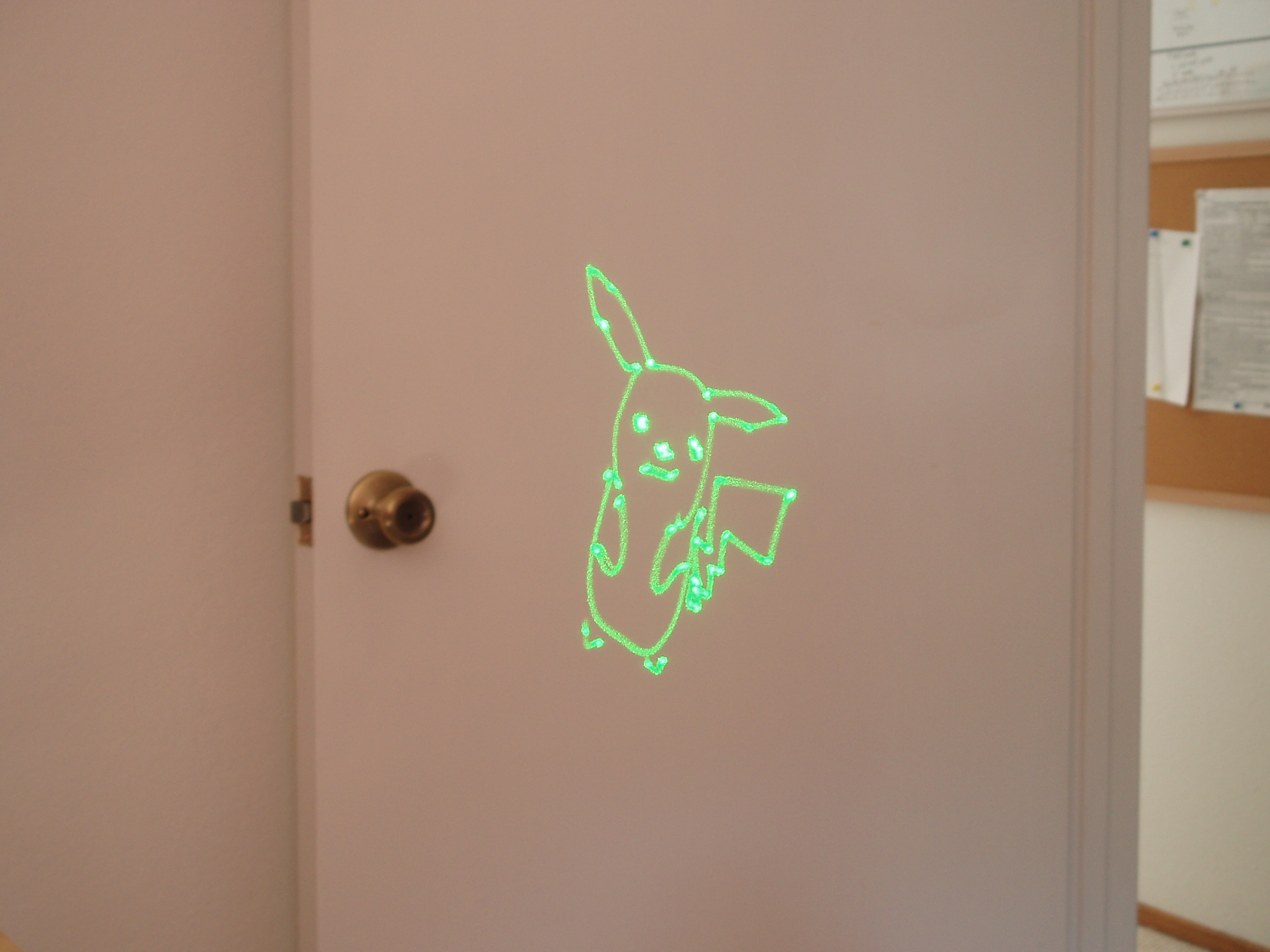
Laser projector update
Looks like my hard disk laser projector made the MAKE blog. Sweet 😉 I’ve been hacking on the software for the projector quite a bit this week- mostly on the code responsible for importing and converting vector graphics data. In a typical laser projector, you have a high-speed DAC connecting a pair of analog servo…
-
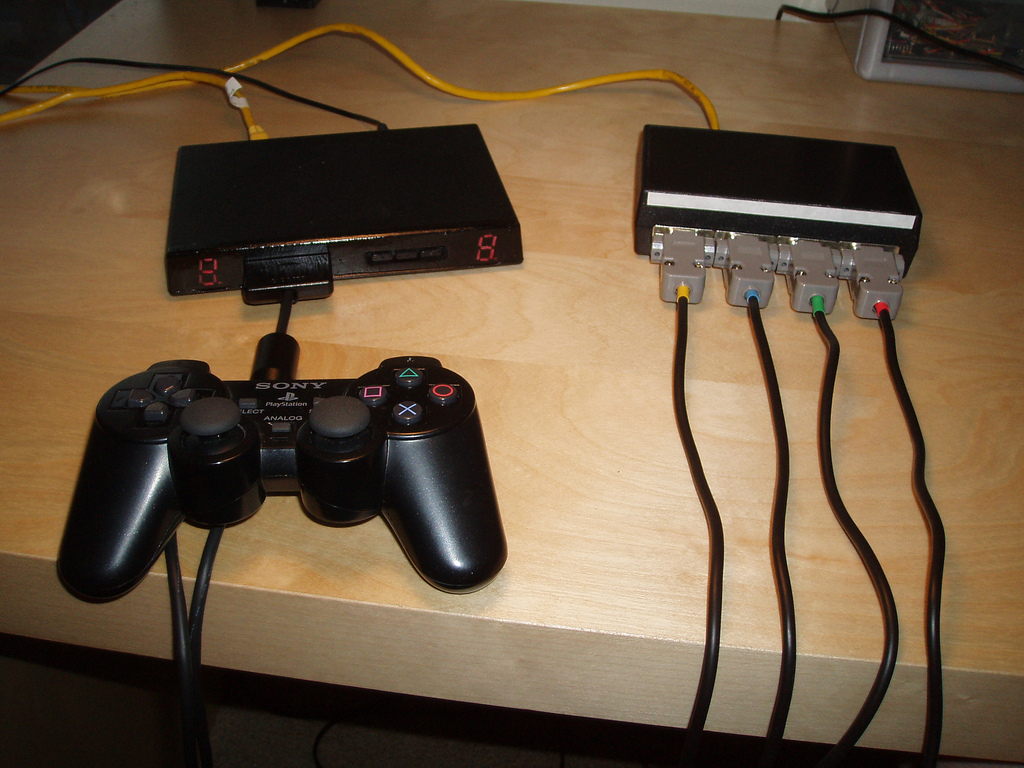
Playstation 2 Dual Shock protocol, revisited
Last summer I did some hard-core reverse engineering of the Playstation 2 Dual Shock controller protocol, so I could build a fully-featured Playstation controller emulator/extender device. I wrote up a fairly minimal protocol document, and published source code (navi-misc/unicone2/psx-base/psx_controller_emulator.spin) for an emulator that could impersonate a Dual Shock 2 controller well enough to fool every…
-
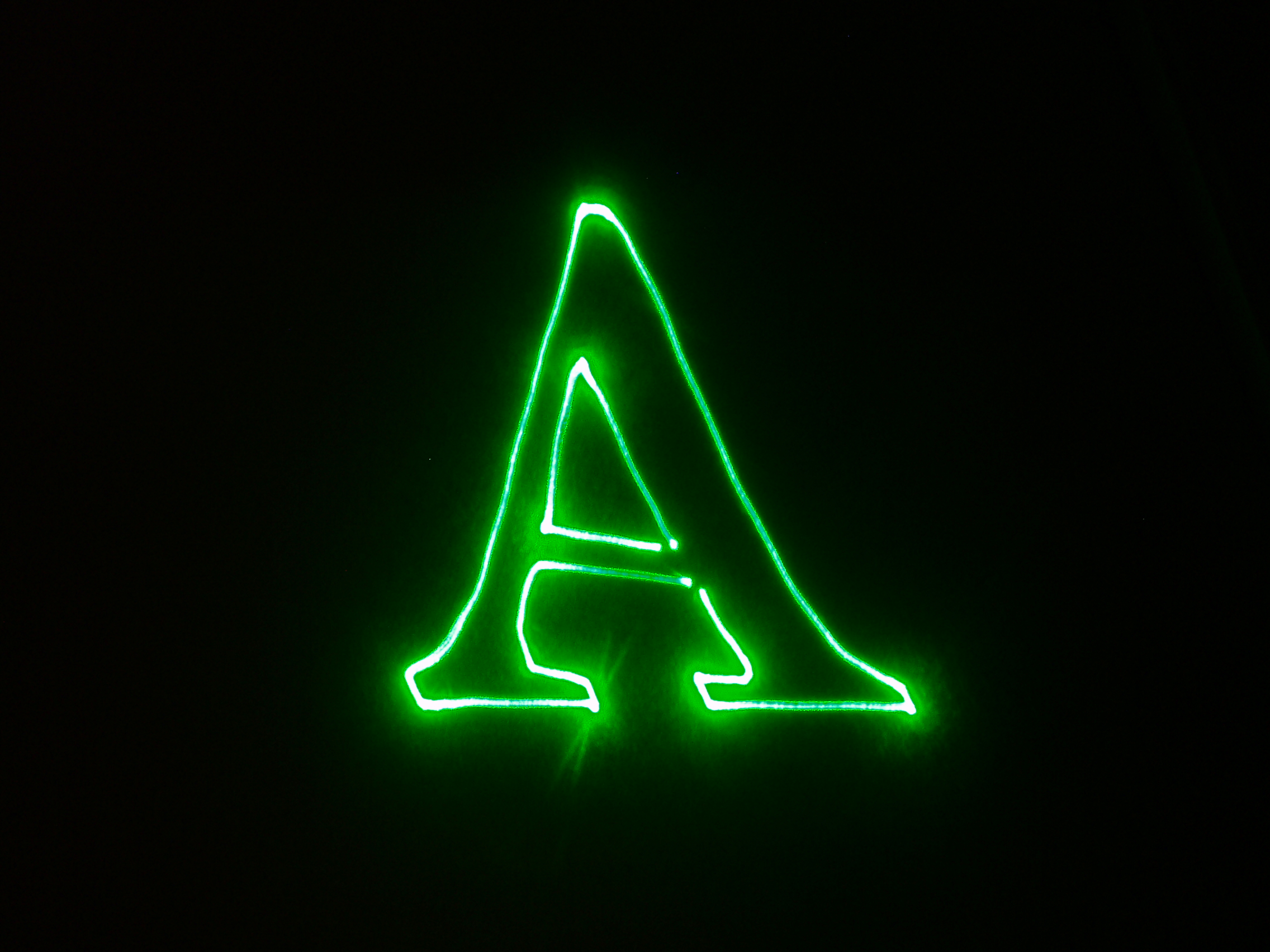
Times New Roman at 532 nanometers
After running the ILDA test pattern at only 4K on my hard disk laser scanner, I really wanted to see how well the projector would do with the kinds of “real” vector graphics that I expected to be able to display. Most commercial ILDA frames are way too complicated for it. As I mentioned, the…
-
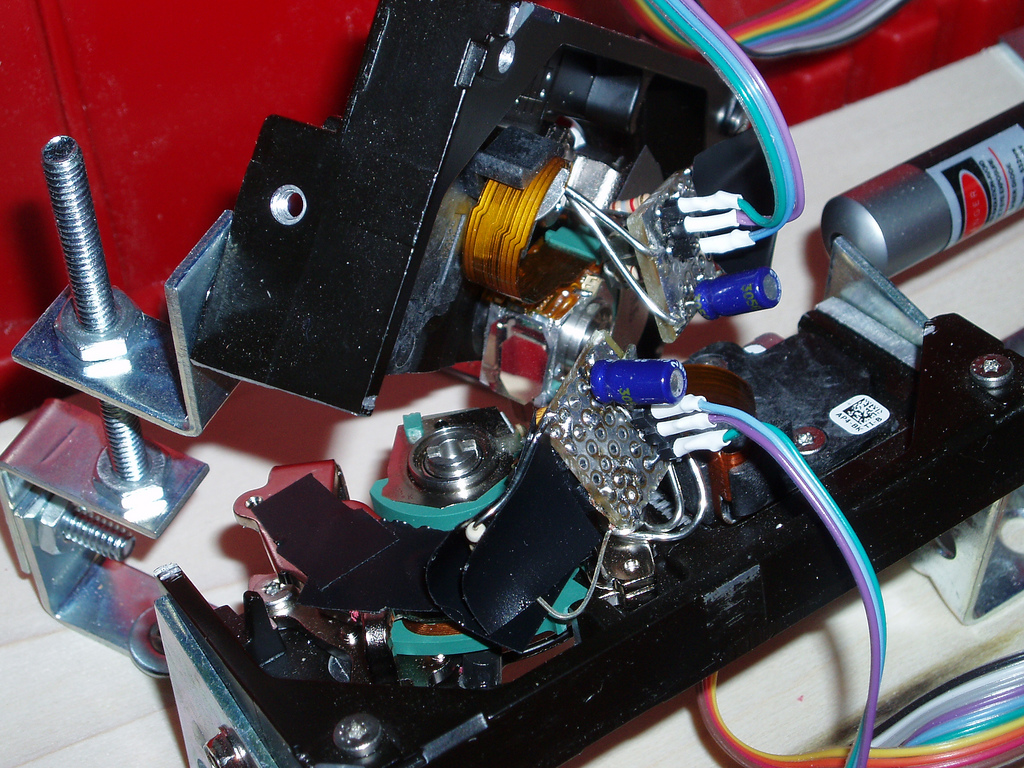
Hard disk laser scanner at ILDA 4K
I should have blogged about this long ago, as I’ve been working on it off and on for about three months now, but today I reached an arbitrary milestone that compels me to post 😉 I’m still actively working on this project, so I’ll try to make updates occasionally, and if I end up putting…
-

3D Graphics at VMware
Despite all the random posts about helicopters and embedded systems on here, I haven’t really mentioned what I spend most of my time on these days… I work in the Interactive Devices group at VMware. For people who aren’t familiar with VMware’s products, we do virtualization: software that lets you run multiple virtual computers inside…
-

NOP 0x004031A9
It’s like circuit bending for digital art. Medium: Fyre 1.0 (Win32), IDA Pro (The Interactive Disassembler). (Okay, maybe I’m just having too much fun with my new copy of IDA…)
-

Pinchy scribbles
I bought a Wacom tablet recently.. partly for work, but partly because they’re so rad. I’m definitely no artist, but Paul demanded I post some of my scribbles.
-
Ants, meet tasty electrical doom!
One of the chores that came up this weekend was to take care of a minor ant infestation. Paul and I had noticed a few scout ants here and there, but there was no clear pattern. That is, until it became clear that they really like my desk. Fine. The ants haven’t really been paying…
-
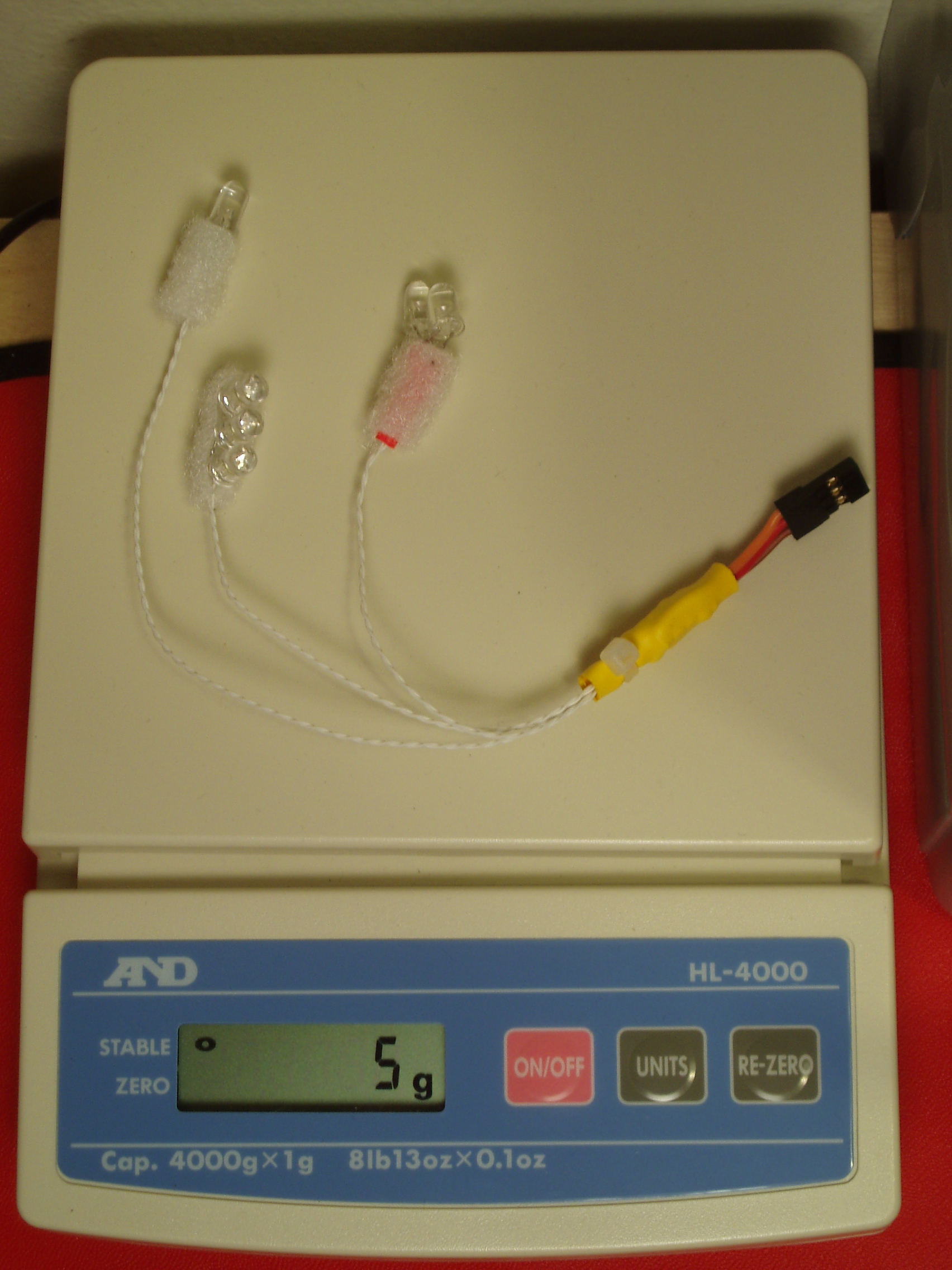
R/C helicopter lights, Revision A.5
Atmel is going to personally revoke my electrical engineering license if they ever find out what’s in that yellow heat-shrink blob, but I now have a shiny new 5 gram version of my helicopter light kit =D This version has all the same remote-control dimming and strobe capabilities of the heavier Revision A. The only…
-
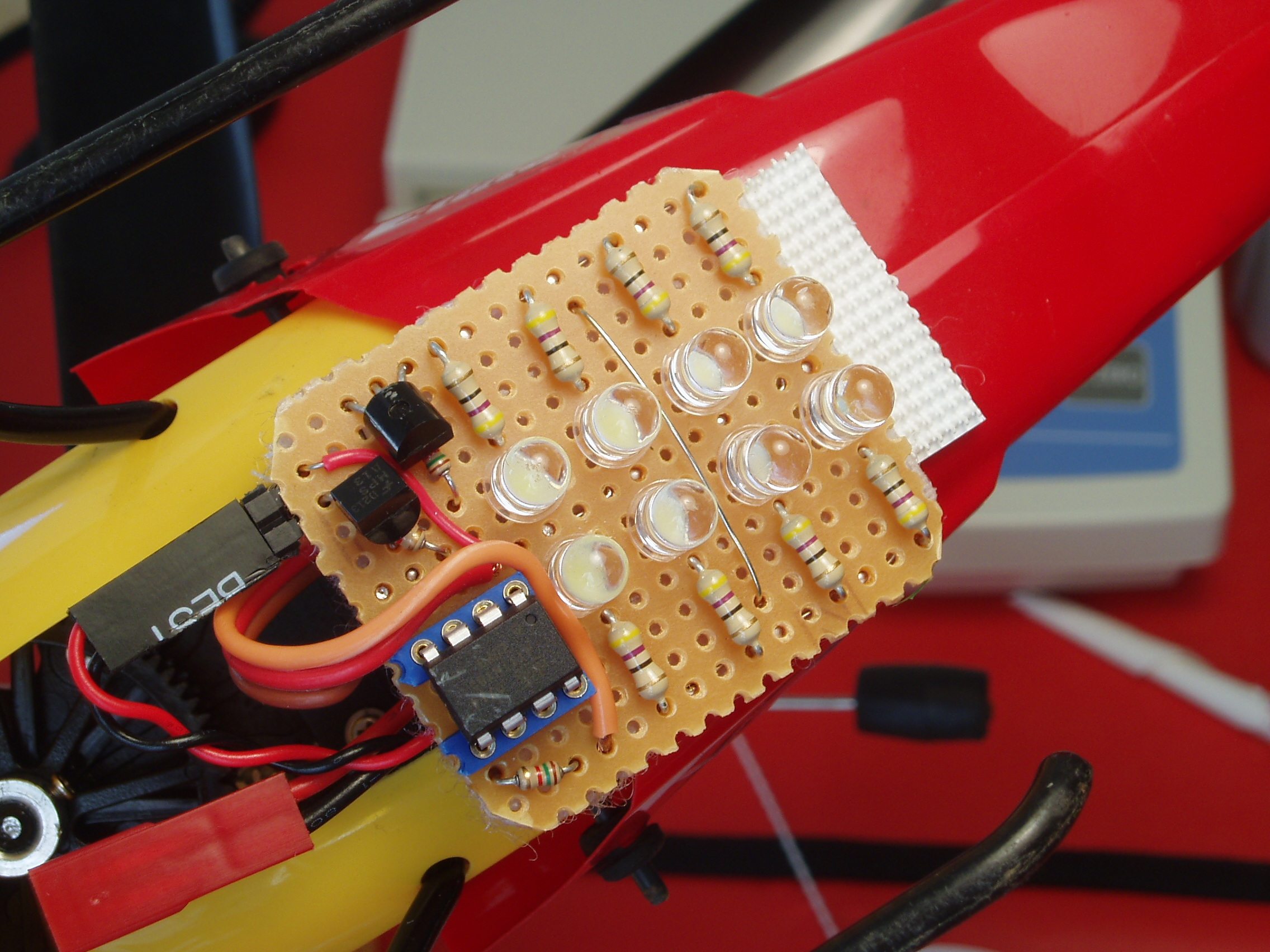
Hardware sketch: R/C helicopter light kit
As great as it is to finish a professional-looking hardware project with optimum component choices and full design documentation, I love the feeling of sketching in hardware (or as I’ve called it in the past, improvisational electrical engineering). Despite all the faults and rough edges in today’s development tools, we do live in a world…
-
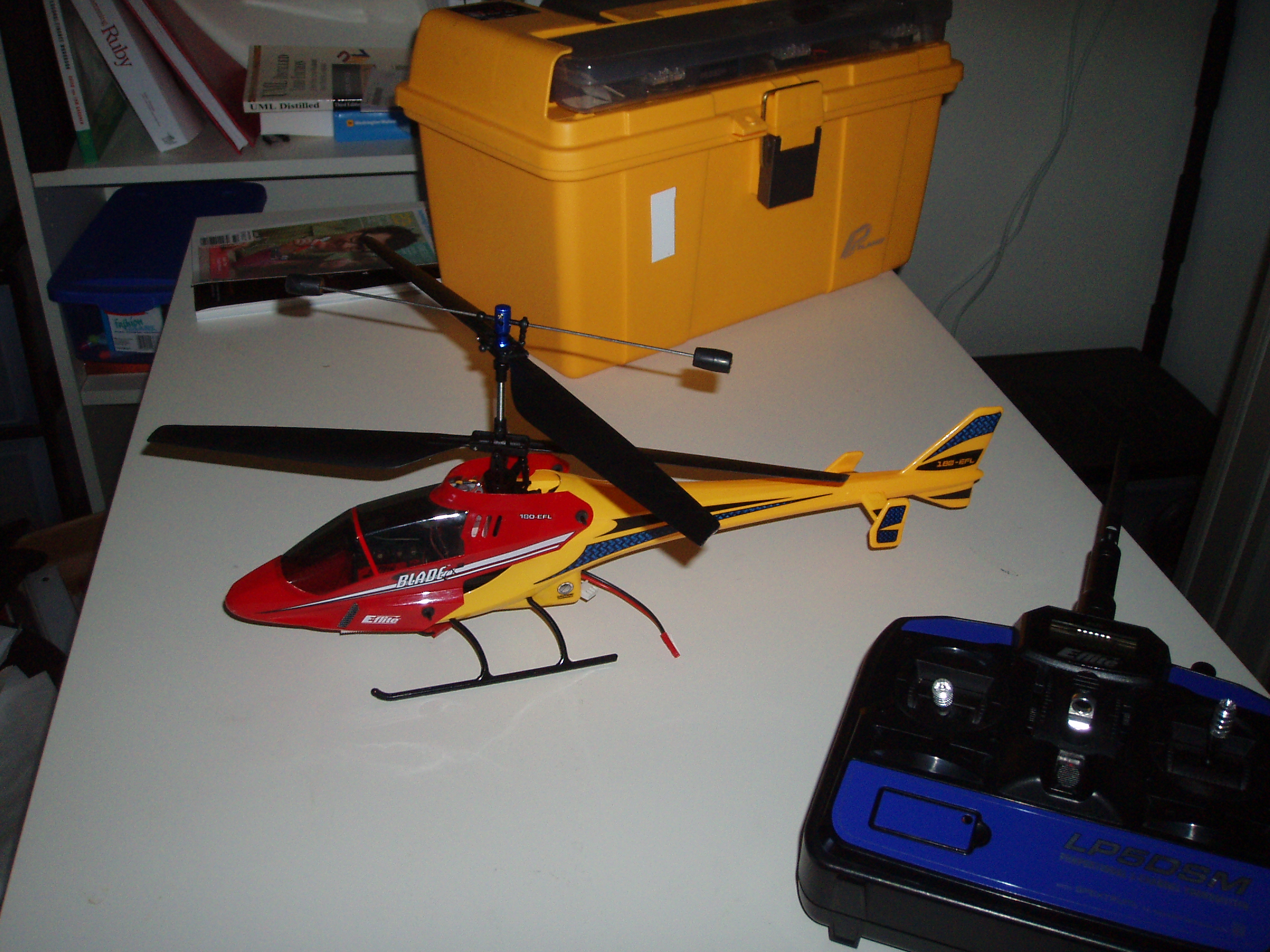
Helicoptering
I’ve been remiss in my duty as blogger extroardinaire. A new hobby, and I haven’t yet informed the world! For the past couple months, I’ve been fascinated by R/C helicopters. As far as I can tell, this all started when I was at Fry’s drooling over the Lego Mindstorms in the toy aisle. The abundance…
-
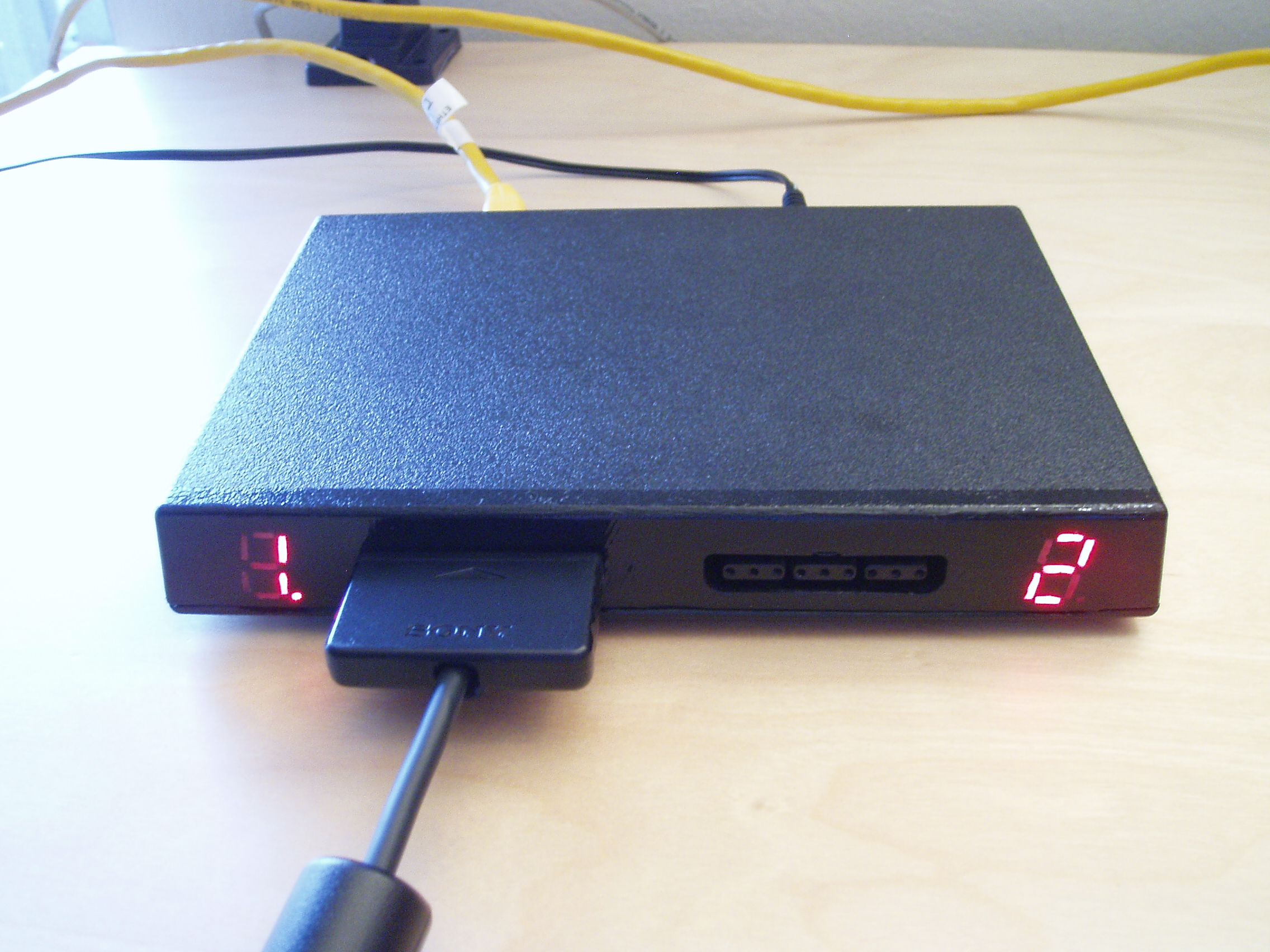
Playstation controller extender
The little hardware project I started almost 2 months ago is finally done. Completely finished. Bug free! Well, almost. It is, however, in a fully assembled state with firmware that is actually pretty usable. The Unicone2 is the result of my mini-quest to extend Playstation 2 controllers over long lengths of cat5 cable. A while…
-

Hardware hackery and the Dual Shock protocol
The hardware-tinkering mood I’ve been in lately shows no sign of subsiding. The theme this time: Everything over cat5. Backing up a bit… It’s summer! Hooray. So, how does one make the most of the season without actually doing something crazy like going outdoors? Of course the answer is to play video games in a…
-
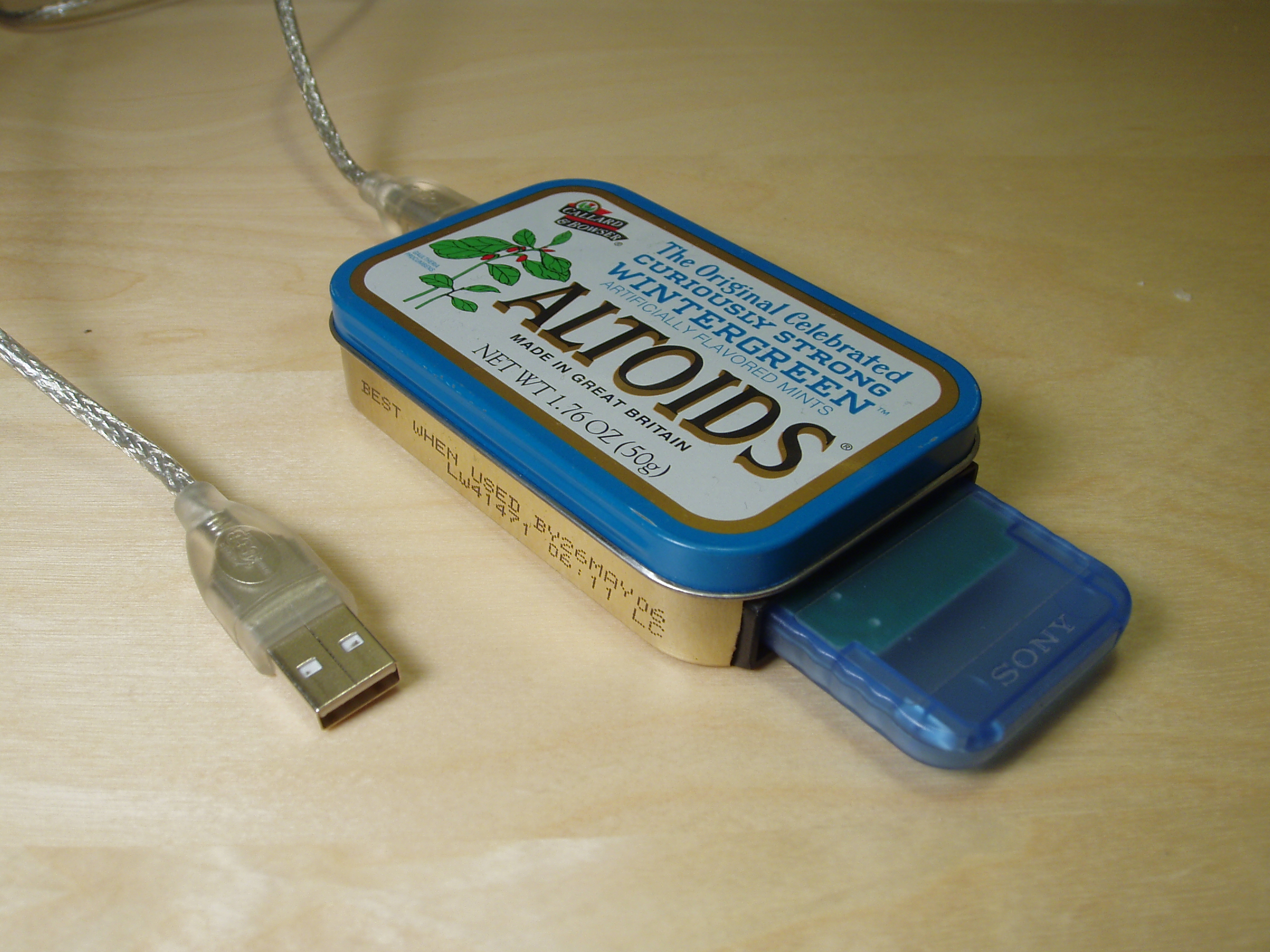
Latest Altoids artwork
Medium: Altoids tin, Keyspan USA-19HS (modified), PS2 Multitap (modified), 74HCT04 inverting buffer, discrete passive components, solder, wire, epoxy. Artist’s inspiration: Dorky boyfriend that crafts Final Fantasy Tactics characters with the precision of a meticulous dungeonmaster 🙂 (Yes, it’s a USB Playstation memory card reader/writer. Firmware and source code for Mac OS and Linux is in…
-

Flightaware route histogram
Flightaware + Fyre: The above image is part of a histogram generated from Flightaware’s 24-hour time lapse. Click the link for the uncropped version. The original video is a Quicktime wrapper around individual PNG frames. I used mencoder to strip off the Quicktime wrapper, then a small Python script split the video streams into individual…
-
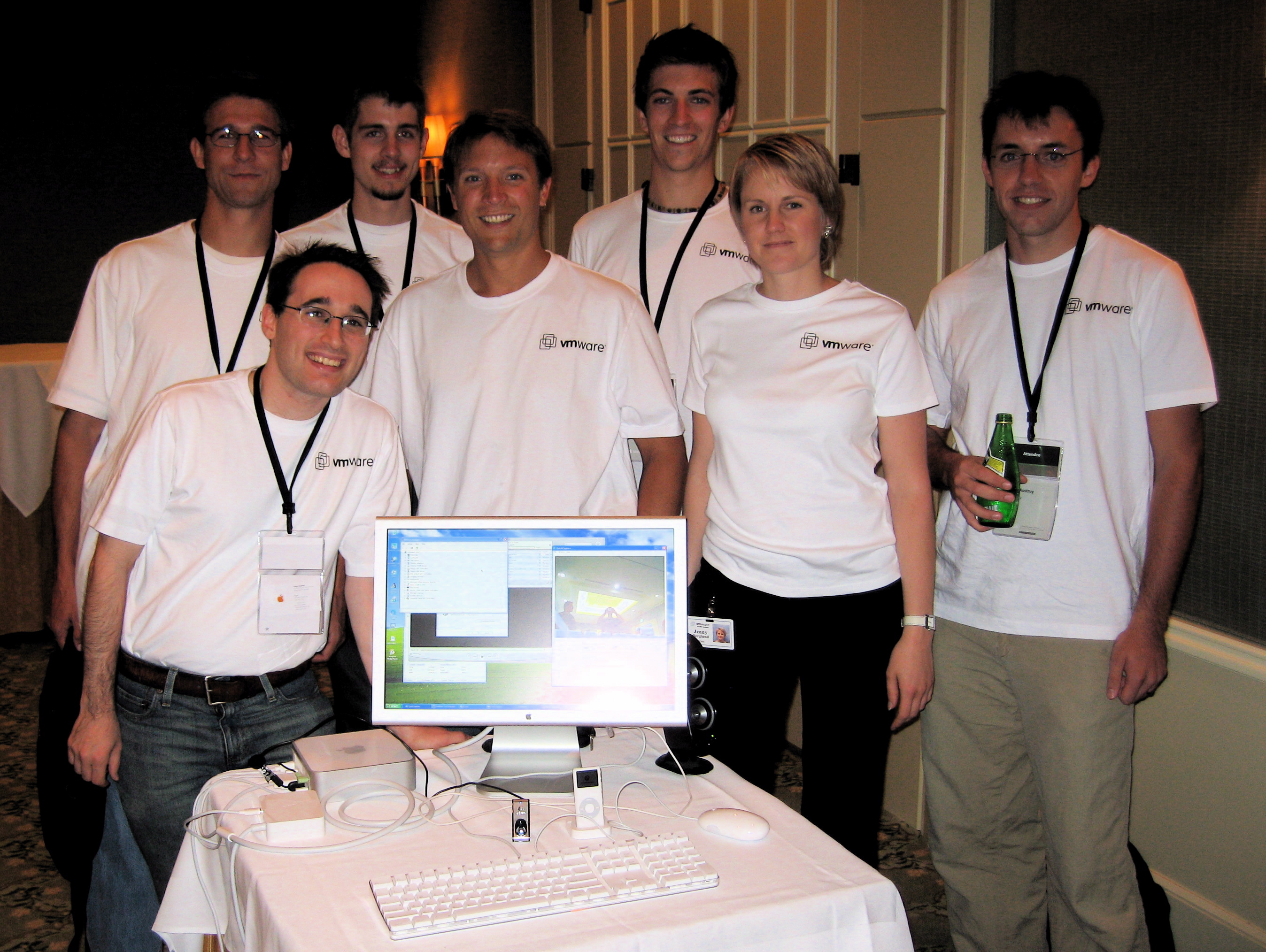
-
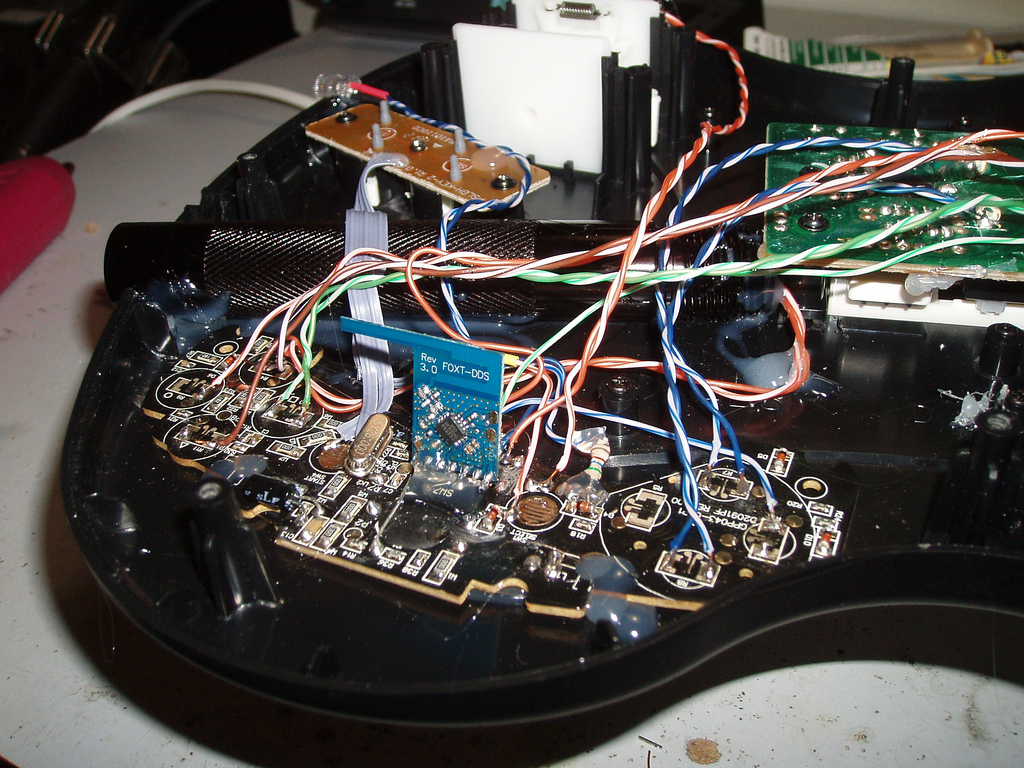
Random update, DIY Wirelesss Guitar Hero
Yikes, it’s been nearly a month since I updated this last. A lot has happened since then… but I’ll skip to some more recent things. David is a Californian, as of last Tuesday! He kept busy buying furniture and waiting in line at the DMV, but I did manage to see him at my birthday…
-
A windy day in San Francisco
Coffee and a muffin in my favorite Sunnyvale cafe. The train car full of baseball fans and their Keystone Light. Metro to Golden Gate Park. A long walk on the beach, south until the San Francisco Zoo. A single slice of pineapple pizza accompanied by fine people-watching. A great diner style cheeseburger with a re-run…
-

Propane pixels
When I was little, I was afraid of fire. I had nightmares about being trapped in burning buildings. Pulse terrified me, even more so than It. I wasn’t scared of being burned- I had my share of encounters with a hot soldering iron or an overheated BJT. I was scared of fire’s power to consume…
-
CIA sure has grown
The latest stats from CIA’s bot server: 50 total IRC bots across 33 networks, inhabiting 370 channels with a total of 5782 users. And amazingly enough, all the large Freenode bots have uptimes of 2 weeks or so. That fancy flood-kick-prevention code sure did the trick.
-
If you thought USB sushi was odd…
Okay, I just have to bloggy-blog about this work of genius that Christian found. My favorite has got to be the USB belt- the perfect gift for that lovable USB dork in your life.
-
Surely I’m not the only one?
Wait a minute, Doc. Are you telling me that you built a time machine.. out of a Saratoga? The way I see it, if you’re gonna build a time machine into a plane, why not do it with some style? Uh, does it run on regular unleaded gasoline? Unfortunately no, it requires something with a…
-
Oversampling in Fyre
Despite Fyre 1.0 being “completely done” for a while now, I have to nitpick it occasionally. I recently composed an image which brought out a particularly bad oversampling bug in Fyre. Fyre implements antialiasing using an oversampling technique, much like FSAA on modern video cards. In Fyre 1.0.0, we just chop each pixel into an…
-
Gimp 2.3.7
I finally got around to installing the latest development release of Gimp, 2.3.7. It’s definitely worth a try. The menus have been rearranged a bit- a little disconcerting for a long-time Gimp user, but the new layout makes a lot of sense. It’s always nice to see the new splashscreens.. but I’m still a little…
-
Google Local on T-Mobile
I was using Google Maps on my phone before it was cool. My little prototype Python application, Pyhole, still gets some use despite the fact that shortly after I got it working Google released their own Google Local Mobile. Why? Google’s client doesn’t work with T-Mobile. At all. Not to mention the cheap “t-zones” plan…
-

Random Update
Well, it’s been a while since I’ve updated. Nothing on its own recently has inspired me much to write, but I have some smallish things to mention. I have a new laptop on the way! My 700 MHz Pentium III with 192MB of RAM was just getting too clunky for day-to-day use. I recently ordered…
-
January 2006 Update
Fyre It’s easy for me to see Fyre as a ‘dead’ project these days- the existing codebase was declared ‘done’, and we moved on to a new architecture dubbed Fyre 2.0. In some ways this rewrite has suffered from second system effect, and the code hasn’t been touched in a while. But, I think we…
-
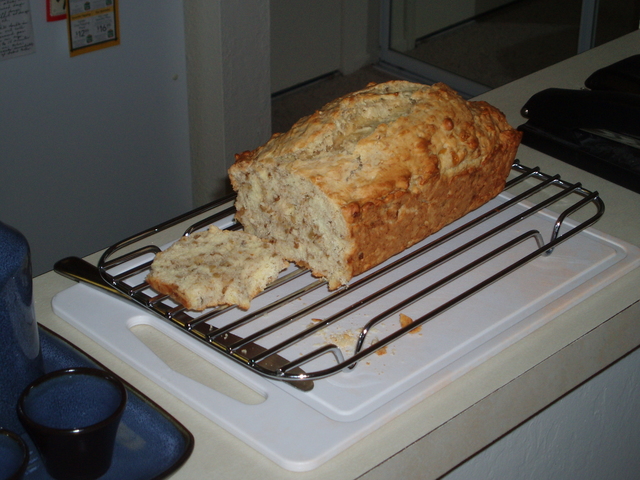
-

Life at 3.579545 MHz
Well, after an evening of cooking and hacking, I’ve managed to implement my own crazy software-only modulator for NTSC video. It can take an arbitrary JPEG image, turning it into an analog signal representing one field of color broadcast video. This analog signal happens to be playable by displaying a resulting image file on your…
-
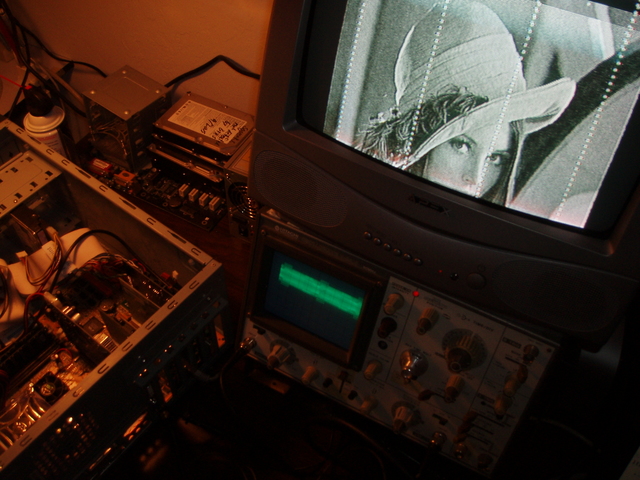
Tempest for ATSC
Recently I have become intrigued by the little 75-ohm coax plug on my plasma TV. To me, television programming isn’t worth nearly what Comcast charges for cable. I mostly watch DVDs, or television shows downloaded over the interweb. After reading about the fairly powerful digital television coverage in the bay area, I decided to plonk…
-
Metadata as personal information
Hopefully all of you have seen this spiffy little tagging library that Christian and David are working on. One of the comments we hear about it is that tags should be system-wide, rather than per-user. Some people view tags as a global attribute of a file: much like a MIME type or its permissions. We…
-
CIA Updates, Cappucino in The City
Database v7 Well, it’s been a busy past couple days, but I have some great news to report with regards to CIA. The new database backend I’ve been hacking at for the past couple weeks is now in place, and the performance is great. So, to back up a bit… CIA uses MySQL. It has…
-
Mobile map inspiration
So, I’ve been itching to do something really cool with Python on Symbian Series 60. The first thought was a way to upload images directly from the phone to Gallery. Well, it still needs some polishing, but I wrote most of that at the last SVLUG hackfest. Right now it takes a picture with the…
-
Fighting entropy
I’m still continuing the gradual process of acquiring furniture and dispersing any large piles of junk from my living room. I finally got to pick up my coffee table yesterday, which I ordered about two weeks ago. I also found a cabinet to hold my server and A/V equipment. It’s garage-grade furniture, but still fairly…
-
Let the pixels flow
My posts have been pretty light on the photos recently- this is mostly just because I haven’t been taking a whole lot of pictures, but even when I had plenty of pictures they were safely quarantined behind gallery rather than flowing freely over my blog and all that aggregate it. I admit, this photo has…
